TAPE 80/SHE/01
THIS TAPE HAS BEEN RECORDED ON THE 8th of APRIL 1980 IN THE WRAPPING ROOM AT SPRING VALE MILL, HASLINGDEN. THE INFORMANT IS ARNOLD PARKINSON, MULE OVERLOOKER AND THE INTERVIEWER IS MARY HUNTER.
[SG note. Some parts of this transcript were virtually incoherent and I have had to edit very heavily to make sense. The principle I have followed is to preserve the sense and meaning rather than refine the original words. The message is that if you wish to make your own assessment of my accuracy you must go back to the original tape. Sorry if this sounds arbitrary but it was the only practical way to do the job.]
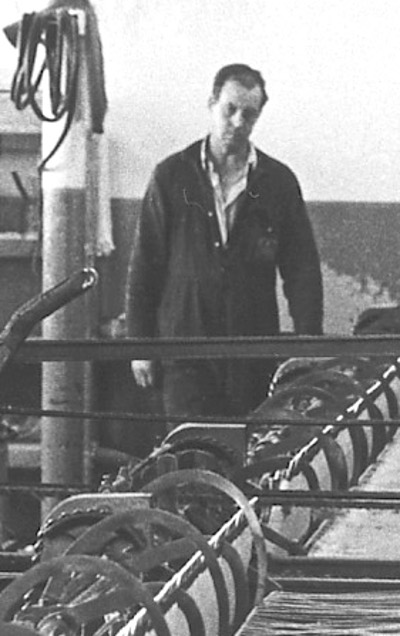
Arnold Parkinson.
Now then Arnold, where were you born?
R – Well, I were born up in Rossendale General at first, that's the only thing I can tell you but I was born at Clough Hole Station officially. Like that's where I lived.
So you've always been a local round here.
R- I've always been a local yes.
That’s right. I should explain what the noises are in case anybody…
R- Well they are only wheeling boxes and that to put on the wagon empty boxes, for taking back to Grane Road for filling up again with tubes.
With tubes? For spinning.
R- That’s right.
Very good. Have your family always been involved in the cotton industry.
R- More or less always. Mother were a weaver all her life, father worked inside and all in between. He were really on the level like an outside worker you know. But mother were always a weaver. My sister were a weaver, wife were a weaver so I mean we’ve always been in the textile trade. I mean, but like now, as I say, we’ve had to finish there. One or two bits of things like finishing and closing and everything else.
[Spring Vale was under notice of closure when this tape was made.]
Do you wish that you could still carry on in there?
R- I do wish I could carry on but there is no question of that. I were hoping this would be here while I were retiring, but it hasn't come about so that’s it.
And you’re hoping to get another job in cotton?
(50)
R- No I can’t because there is no cotton. There is only one cotton mill left that’d be really of any service round here now and that'll be such like Smith & Nephews, which is, there’s quite a lot of various stuff but mostly it's medical supplies you know. Nivea cream and things like that like what they're dealing and all the face value stuff, underwear and that for children, they do all that. But that’ll be about one of the only textile mills left. Within another five or six year you can near enough bet on that in here.
And it certainly isn't condenser spinning, is it?
R- Well it isn’t condenser as we know it, not mules, it's all open end ring spinning all the way through.
Was it always expected that you would go into the cotton industry?
R- Well there were nothing else, there were nothing else in this valley. Cotton, felt and slippers are the three basic things in this valley, nothing else, so you couldn't expect nothing else really, you know what I mean?
Unless you left the valley.
R- Well that's it, unless you left the valley you know. I mean, at the beginning I were expected to go into (?) because that’s what I were interested in at first, with school. But I didn’t want to take it up and the simple reason were at the beginning me mother didn't want me to leave home you know, when we were only fourteen then. So that were the reason why I came into the mill.
Was it regarded as sort of deserting the cause if one did leave the valley?
R- Well I wouldn't like to put it as bluntly as that. I mean quite a lot of people did leave the valley because as I say the cotton trade has been deteriorating for thirty odd years, all the time I've been here it's been
(100)
deteriorating. Now we've had quite a lot of arguments and different things about various subjects about it. It’s been a question like, of all these imports they keep saying. Quite a lot of it is, but there’s quite a lot of it being both on the managerial side as well as the working side. But the mills as they are today, in our trade now, in the condenser trade as it stands now, what few there is left, we've always had the lowest of the low coming into it. We haven’t been able to pick or chose into the labour force. because they are not interested in it you see because it’s been deteriorating that long. Now quite a bit of that deterioration has not just come from the management side, a lot has been through such like as Unions being involved in it. They're some of the main stays in shutting a lot of these cotton mills because they were too ignorant
(5 min)
to see the sort of things that they were asking for when they were asking for things. And if a manager or a director of a firm came along and dangled a few pound or a few shillings in front of a man’s face, especially if it were a Union man, all jump at it. And it didn't matter about the rest of them as long as he got that few shillings you see. But then after another month or two, twelve months let’s say, then there’d be another argument about the same particular thing. Then at finishing up there'd be another few shilling. And this is what's happened through the years, that the condenser trade has gradually built itself up into such a reputation like that, that is why a lot of them have shut down because they priced their self out.
(150)
Are you saying that in the condenser trade the Unions were stronger?
R- Well they were. they weren’t stronger but they were [more] foolish than being stronger. They wore more, they were more foolishness in that lot, they could never see, they could never see what were happening to their selves or anything else. That were the basic thing really. Apart from that as I say, the managers, I mean they were quite at fault and all. They never opened their mouth as long as they were drawing something. But the biggest asset to our trade has been the unions and that is true is that.
The biggest asset?
R- The biggest asset to shutting quite a lot of them is the union involved.
Because they had encouraged imports and therefore…
R- Well not encourage imports as much as they like, they said like they’d been trying to avoid, they've never tried really to avoid them because they've never been strong enough to take it up. In the condenser trade you’ve about seven or eight different small bits of Unions. The same as we have the spinning room, we had the mule spinning department, now that was classed as one Union. Now when I started in this trade thirty odd years since there were a matter of about fifty odd thousand mule spinners between, I’m talking about Rossendale Valley like, including Blackburn and Burnley and things like that you know, there were in the region of about fifty odd-thousand.
Is that right.
R- Now they've got down to, as a matter of fact now there isn't above, I don't think there is above a hundred now left in the whole country. And that were only this one area like. Now we've had quite a lot of representatives like, as far as government’s, concerned, no names like, what’s supposed to represent this particular valley; but there is not one of them yet ever spoke up about the depths in our trade. They’ve all opened their mouths
(200)
when they've been round here but when they’ve gone down London they've just opened their mouth for a quarter of an hour and then shut it up for the rest of the time. So nothing’s ever been said in that respect you know. But they all had their own particular political views about them.
Would you call yourself a Union man?
R - No not really, I pay Union, but at the bottom of it I don’t like the idea of being called a Union man because they don’t represent what I want to say. They represent what they want to say. We had the argument about the [closure] upstairs in the mule room and about this redundancy job. Now that’s the only thing I have to say about that, I don’t like the Unions, not as we have them. But we have to be in.
Yes. I think you’ve said you left school at fourteen?
R- Yes.
Did you begin at this mill then?
(10 min)
R - No I didn’t learn, I didn't come to this mill till I were twenty two. I’d been married about six months then when I came up here. The first job that I had in, not in this particular trade, were in a woollen mill. Now well that had the same kind of [experience] reflecting through the years as what the cotton has. I started in woollen, I started in mules, that were at Rawtenstall. Now I did just over two year there, in the mule room.
As a spinner?
R - Well not as a spinner, learning. In the mule room you’ve to learn more or less basically putting your own ropes on, putting your own belts on and all that. You'd to piece them yourself. Now in the cotton trade although a lot of them did the same thing there were quite a lot of them which had, as we call ourselves now, the mule overlooker, which were supposed to do all them particular jobs instead of the spinner doing them so that the production were going on at the other mule then you see. You see they could concentrate on that. And if it were a job big enough, or too big for the overlooker you were supposed to help him out at that time. But basically like as I say, in the woollen industry you did have an overlooker there but more often than not the overlooker… I mean it only happened in one or two odd mills in the textile trade. We happen had a couple of pairs of mules you know, the overlooker or a carder would be involved in them both. But in quite a lot of mills they had a carder and they also had a mule overlooker which were in touch with both lots of their own section. you know. That’s how it used to be. But you couldn't, as I say, when I started at the beginning you couldn’t walk out of school more or less and walk into the mule room, not just at that time. You had to spend so much time, you did at least twelve months or two years you'd be working in the card room piking bobbins, carrying bobbins and things like that you know? You'd be putting them on the mules, you wouldn’t be in the mule room. That were the idea really to give you the basic facts of how to carry a bobbin and treat it as what it should be. You know, for when you did go in the mule room. Then when you did that, then you'd got a chance then of going in the mule room. But mostly the lads that were interested in the mule room were actually going in the mules and piecing the ends up and helping the spinners to put bobbins in because the spinner were getting the value of it because each mule were being set on that couple of seconds sooner than what
(300)
it were if he were putting it on on his own. So he never interfered with that particular job. The only thing that the old overlooker seemed to [avoid] and that were to show you anything about the headstock till you'd been there a while. When I say a while, you'd happen be in that mule room two year but you wouldn't touch a headstock unless the spinner were off and then somebody came along and said “Well, can you carry on running it?” But you’d to watch all the time, the overlooker wouldn’t show you. The spinner what were in charge of the mule he wouldn’t show you at all. It were like the tacklers were trying to do and still do in the tacklers trade, they are what they call a closed shop. That's a Union [concept], that’s a closed place. Now the mule room was something similar but as the war started that had to lose its face value you know? So they started getting one or two more in. Now, the main thing about what I say about Unions, they allowed the managers to start, what’s it called…? [diluting the labour. SG] Letting people come from outside irrespective of their age or anything and start learning to piece up. Now they'd pay them a wage and a good wage in one sense to get them into the mule room to learn to piece up, put bobbins in and set it on. Now that were one of the downfalls of the spinning room were that, for the Unions allowing it to be carried on. You see I mean you could fetch a lad out from being twenty odd and thirty odd, put him in a pair of mules and along with it he were getting a standing wage, he were all right, he wasn’t bothered. Well they did that quite a lot when the war came on and quite a lot of mills had that process in mind all the time. And it were a poor do and that's when the Unions should have stepped into that part of the job. But instead of that they let it carry on and that were a bad thing for the mule room were that because it didn't help. It didn't help the spinners what were in there, it cut them down.
(350)(15 min)
Do you feel then that there should have been some sort of training, official training?
R- Well that is what it used to be, there used to be a training and you could nearly all say, I mean meself, I know I were twenty odd before I get put on to a pair of mules to look after meself or put in charge of one mule. But in the last fifteen or twenty years there’s lads come along, they’ve only been in the mule room three years, some even less than that and they still go on to a pair of mules. But it’s only because of the simple things, they’ve learned how to piece an end, put a bobbin on and set the mule on and get the mule ready for doffing. Now what I say is that, they are mostly the four basic things. Once you’ve said that they don’t know anything else about the mule except them four particular things. They don’t know why they piece that end up from the spindle to piece it up properly.
They understand the processes but they don't understand how it works.
R- They don’t understand how it works and that’s another fault that the managers allowed to go on. Now I mean, we get a lot of stick, same as us all. They [management] come along many a time and they moan and groan about bad cops going down, bad piecing up but that is exactly where it started in the first place. Now if they hadn’t allowed it [the dilution] or the unions hadn’t allowed it, it could have been a better proposition all the way round.
Do you think that something as complicated and skilful as spinning could be learned by formal methods like going to night school for example?
R- Yes, that were the thing really. We used to have to go to night school to learn the working parts. I mean you can work in a mill, we have them now, I mean Roy here, although he has been in it for near enough forty years, and he’s done this job himself when he were fetched on to it, but he didn’t really know how to start on the mules because he had been to night school for carding. And when you go to night school you learn so much about the card room but basically you learn on what you are going for, the card room or the mule room. Now unless you are working on them, that’s the only way you’ll learn. The night school is a good thing to learn for that particular thing.
So you think it would be a good idea.
R- It would be but as I say you couldn’t get them interested. They weren't interested because I mean they stop, I mean the schools never took no interest, you can't blame them. As I say, for years the trade has been going down, down and down. So the schools, although they fetch these children around, they don't have no particular teaching at school to want to learn ‘em to think about the textile trade. It’s a downgraded thing now to think about coming into the textiles. And you will get that at school. I mean, me own children come out with that question. The teacher says “Oh, you don’t want to go in there.” But that’s happening now.
I think it's the whole concept of factory life.
R- Do you know that’s what it really is, the old factory life as it stands.
Would you consider that the conditions you've worked in through your life in cotton, has been .. that the conditions have been tough?
(20 min)
R – Well they have, they've always been tough in one way but I mean they've been pleasant, we've had pleasant times as well as bad you know? And I mean, me own personal self, touching wood, for the thirty odd years I’ve been in this trade I've only ever had one week, or is it? It might be a fortnight, but only about a fortnight I've had on the dole. Now, I don't really call that bad as far an that’s concerned. The mill, the mill running .. I mean, varies from one mill to another. This particular mill what we are in now is an ideal setting in two rooms especially as I say.
(460)
That’s the middle room and the top room, we've got the lighting and everything else, you’re not forced to look at artificial lights like, over the top of your head, like they have to do here in the bottom room. Now all as a bottom room spinner can see that's the four walls round him. Now in the middle room and the top room they can look outside, and see quite a bit more outside. Now once over there weren’t a lot of that, the windows were either washed up with whitewash or something else to stop the weather from getting into it. Because this trade is ruled with weather, quite a bit of it you know? And that’s another point I mean, coal has gone that dear, they've gone on to oil, and now they're finding oil's going dear so they are cutting down in that respect, everything that goes round it. I mean part of the idea of the closing points at all this, that and the other .. the costing has gone up tremendously.
Has the cotton dust ever bothered you?
R - Well it hasn’t bothered me personally but I know three or four of my friends that has had that do you know, but they've been in the card room side, not in the spinning room side. I've never heard of anyone in the spinning room having it, I know there’s been one or two like tried for it you know. [under industrial compensation] But I mean they’ve never actually had it, not with dust, the job you’re talking about.
Yes. Do you mean the lung disease?
R - The disease on the lungs. [Byssinosis] I've never heard of any spinner having it. One or two have had nasty accidents like in years gone by. I’ve seen one lad who is a cripple, he were crippled down one side. You see that were when the old engine were running. And they used to stop the mule, this is going back twenty odd years since, just when I were in the army I met this particular follow. When the old engine used to be running the mules. As the engine were stopping the mule were stopped and they'd be cleaning them or oiling or anything you know. Now sometimes if they weren’t careful and put the catch over on to the stop rod to stop it from setting on. Because it were dinner time and the engine were stopped they didn't put that stop rod over and sometimes the engine would set on rod would go on and the spinner would be in the middle.
(500)
Now that happened a time or two you know. But, that weren't the machine’s fault as much as it were the spinners fault himself for not being careful and not thinking.
That’s true. You had two years at the woollen mill, and during that time you learned the trade of spinning ...
R - Well I learned the trade as a spinner. I were piecing up, putting ropes on which is basically the same except them in a woollen mill is a little bit heavier than what the cotton is. And then like the different set up in drafting at compared to cotton. [The condenser mules at Spring Vale were almost identical to the mule used in the woollen trade. Worth noting that the headstock on a fine spinning mule was different and a lot less complicated.]
And what did you do after that?
R- Well, I came out of the woollen when that shop closed. I went to Longholme first. Now I went there for spinning but I were put on condensing. Now that was what they had to do, go on condensing for so long before you came on to the mules. I were at Longholme, like not so long before I finished there. And then I come over here to Carr Parkers.
To where?
R - Carr Parkers across the road. That were another cotton spinning place, mules. I went there. And I went there on the same idea, to go in the mules, but because I worked in the card room down at Longholme I still had to go in the card room over there. And I were over there up to going in the army more or less. Then I came out of the army and I thought well, I’m not having no more card room now, I’m going in the mule room. Well as it were, I had to do another couple of months in the card room then I got put on to the mules and that’s where I stopped. And I were just…
And was that here?
R – No, that was over the road end at Parkers.
So you went back to your original job after the war?
R – Yes, oh yes, we had to do. We had to do that, you couldn’t come out of the army and just walk into any other place, you had to go to the place that you worked at when you went in the army. Well I mean, the job were left open for you. You couldn’t pick or choose, the jobs were left open for you. And just at that time you couldn’t do it because if you wanted to move from one
(550)
job to another you had to go to the Labour Exchange to get what they called a green card. And you used to get a card off them and say “Well, I’ve got a job at such and such a mill.” Well they had a vacancy. “Oh well, all right then.” But they had you down then, you see and that were more or less to cover for the forces mostly because a lot used to try the dodge. So they got catched with that you see, they couldn't start unless you had a green card.
So you finally got to the spinning room at what was it, Parkers?
R- That’s right. I were twenty one before I started in the mule room roughly, I’d just turned twenty one and I started over at Parkers. Then I went to Hargreaves, I was up at Hargreaves on a pair of mules up there, same thing, condenser spinning. I was up there for just twelve month roughly and then I came to Spring Vale where I’ve been ever since.
So how many years is that Arnold?
R- Well, altogether, apart from when I had a bit of a discussion, a bit of an argument with the management, that were us old manager. I’ve been here now for about twenty eight years. As I say I broke my service once for about six months, through, oh that were the same principle, the unions.
Yes well you needn’t bother telling me something like that.
R- Well I mean that were it, that’s what it were really about, that were the union.
And presumably you rose to be overlooker here?
R- From here yes.
Yes, so you started in the wheelgate.
R- In the, well as you call it, yes, in the mule gate, it’s right is that.
What’s it called?
R - Well they do call it that, they do call it mule gate, it's right is that.
Wheelgate they call it?
R – Yes, well right, they do call it that.
Yes, very good. Right Arnold. Well we've been through most of what you’ve done in your life, and we could probably spend a lot longer but in view of the time and the fact that you are leaving and everything perhaps we’ll start on the photographs. We’re looking at number 40 in the spinning folio and from now on we’ll look at the photographs of Jim spinning and perhaps we'll ask you Arnold to make any comments that you want to make as we go through them. And when you’ve said all you want to say about one photograph you turn on to another.
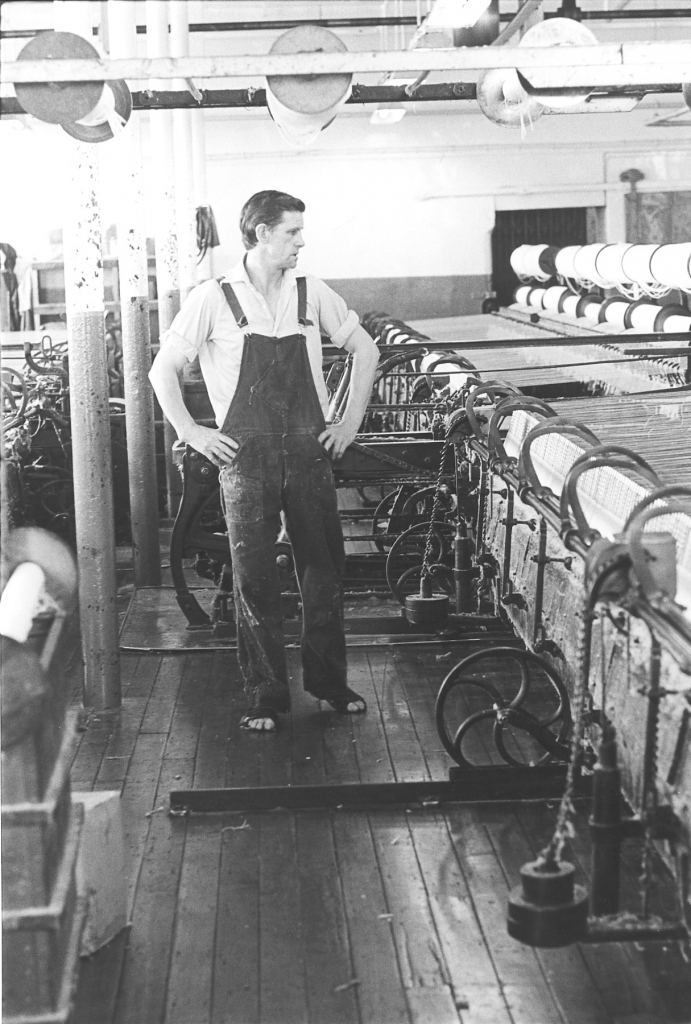
R- Well as I say, on this first photograph you can't really say so much because Jim is stood there with his arms folded for a start, on his hips. He’s just watching the mule running backwards and forwards which
(600)(30 min)
basically is the mule. The only thing you really can say about that photo is that under the conditions, as what they’re working, it's an ideal set for it because he’s stood there watching this particular pair of mules, five hundred and ten spindles and not piecing anything up. So he's not running around in any sort of haphazard way or running his self off his feet in your first photo.
So things must be good.
R - Things are good in there on that one. And I mean, basically the mule, there isn't another thing yet has been fetched out that can beat the mule for evenness in speed or anything else. It’s the most even machine there is going is the mule, in equality and everything else that it produces. The only thing about it is that they can’t get such a large percentage of cotton on the cop as the ring frame can. That is really the only thing that spoils the mule.
So in other words you have to doff more often.
R- You are doffing more often. Every time they doff they break all the ends. Now I mean, we moan and we groan about piecing ends up but every time a mule doffs we break all it’s ends. And that’s five hundred and forty ends being broke every hour and a half, happen two hours you know depending on counts and various things what’s on. They're breaking all them ends and then start rewinding again on the tube. But that is really the only thing about the mule is that one particular thing. And that’s that.
This is in the top spinning room?
R - This is the middle room is that.
The middle room.
R- All wood, Maple floors, it’s grand to walk on provided they’re looked after. I mean as a lot of the old spinners, same as what you can see there, them floors are looked after. They used to give them the long brush, put a rag round the head and they used to go round polishing them floors to take all the oil up. The oil gets in, varnishes the wood and keeps it clean in that respect. It’s nice to walk on and it’s nice to work in.
What's all this about spinners wearing vests not wearing shoes.
(650)
R - Well they didn’t use to, they do now, you’ll not see so many. [In bare feet] I don’t think you’ll find one now in the Valley. Myself, if I go into the mules, which I have done from time to time because we’ve been short or something else, as soon as I get in that pair of mules my shoes come off.
Do they?
R- It's more comfortable walking and working in bare feet than it is working with shoes on. The only thing about working like that is the particular type of tube which we have. [Northrop pirn] If they happen to drop on your toes you know about it, you feel it you know!
I should think you jolly well do!
R- But what used to be before you know, your feet were like another pair of hands for you in years gone by.
That’s what I heard.
R- We didn’t have tubes, we used to spin straight on to the bare spindle and all the cops at the bottom used to be starched.
Starched?
R- Yes, like sizing you know, what they put on. [Arnold is talking about 'paste bottom cops' which had no insert in them but relied on the dried starch or size holding the cop bottom together.]
Yes anyway.
R- We used to wind on, run about three or four draws, they used to call that whipping. And they used to, as the mule’s running in, stopping on the back and just run it in that little bit and then lift the folder up and rewind it again with their arms. And they do that about three or four times. Now that cotton then which were winding on there would wind itself underneath the bottom of the cop right? That made that cop bottom hard. Now, when that were done you used to get a small can with a brush on at the bottom and fill it up with this starch paste and you go all along your spindle bottoms, cop bottoms, with the starch, that’s made it hard so when you spin on top it wouldn’t break.
Yes I am with you.
R- Then that started failing and so they started putting them on paper tubes. That were the next thing, paper tubes coming in. Well the paper tubes were ideal because you didn't get that breakage you didn’t have to whip them at the bottom you know and you could gait up more faster and that. The tubing were the next thing that came in where the spinner used to have to put them on his self. Now they started saying well we are losing money. So that were the next introduction, after a few year we started finding tubers, or young Piecers to help in the mule room, more or less to help putting tubes on. Well that’s how it's carried on from there. But it’s gone from paper tubes which we don’t do now but they usually do down at Higher Mill. It got from paper tubes to going on what we call Welsh Hats. Now them’s a cardboard tube with a small tin at the bottom, that were the next one. Then they fetched these kind of automatic looms out and they found out the Welsh Hats and the paper tubes were no good.
(700)(35 min)
Because why?
R - Well they couldn’t get them tubes in the batteries you know, to drop down. [Thee battery was the magazine on the end of the slay which held full pirns and the Northrop loom loaded them automatically when a shuttle ran out of weft.]
I see yes.
R- So I don’t know really how true it were about it, but they said that Boardman’s, which I’m employed for now was one of the first ones round here that found this particular tube, metal tube, that we spin on now, they were the first ones to fetch the metal tubes round here and they’ve had quite good success with them metal tubes.
And that’s what you have…
R - And that what we spin on now.
Yes, I’ve got to get one of them I think.
R- Yes, that’s what we are spinning on now in the metal tubes and as far as I could gather them were the first ones round here were that. But we found out that the metal tubes were ideal.
Yes, very good thank you. When I’ve first been I’ve always seen Jim in shirt sleeves.
Yes well that basically is because when they’re putting their hands in between their ends you see and picking the waste off they are not dragging at their other ends. You can put your hand through and pick the waste up where if you have a shirt sleeve or try to pick up an end with your jacket on then you catch on to the other end, you can break two or three ends down at each side of the one that you’ve pieced up.
Yes, he had me stripped off when he let me have a go.
R- That’s it, that’s the way.
But it's obviously warm enough though as well.
R- Oh well that’s the one thing the mule room’s always wanting, humidity.
Yes.
R – If it’s a little bit damp outside and it’s warm it’s ideal.
So that the cotton doesn’t break ...
R- That's right, it helps to keep it together. If you get a frosty morning like this morning, and the frost gets inside the mill, especially in the bale processing, then it gets through to the mule room and you start getting a lot of that breaking down. It makes the cotton very brittle as simple as it seems and you get a lot of breakages on that. [In frosty weather the percentage of water in the air is lower] We’re ruled a little bit with the weather but as I say, through the years, and Ill give the managers their due on this, they have tried to get the humidity as near right as they could. But as I say the cost of the heating and everything else today is costing that much that they’re having to cut back even on that. When
(750)
we had the old coal fires the steam were in all the time and very seldom went out because the coal were there, the heat were already in the boiler and the factory kept warm. And then the firebeater used to build up at morning so they could get the engine going so it were always warm. Now with this oil and going on electric you don’t need them, you didn’t need the heat so the oil fires are automatic but the price of the oil is going up that much it’s putting more cost on again. [What Arnold is describing here is the difference between a Lancashire boiler with a good reserve of water which, banked up, could produce steam safely all night for heating, and an oil fired package boiler which can't be treated in the same way.]
That's right, OK, 41 we are now.
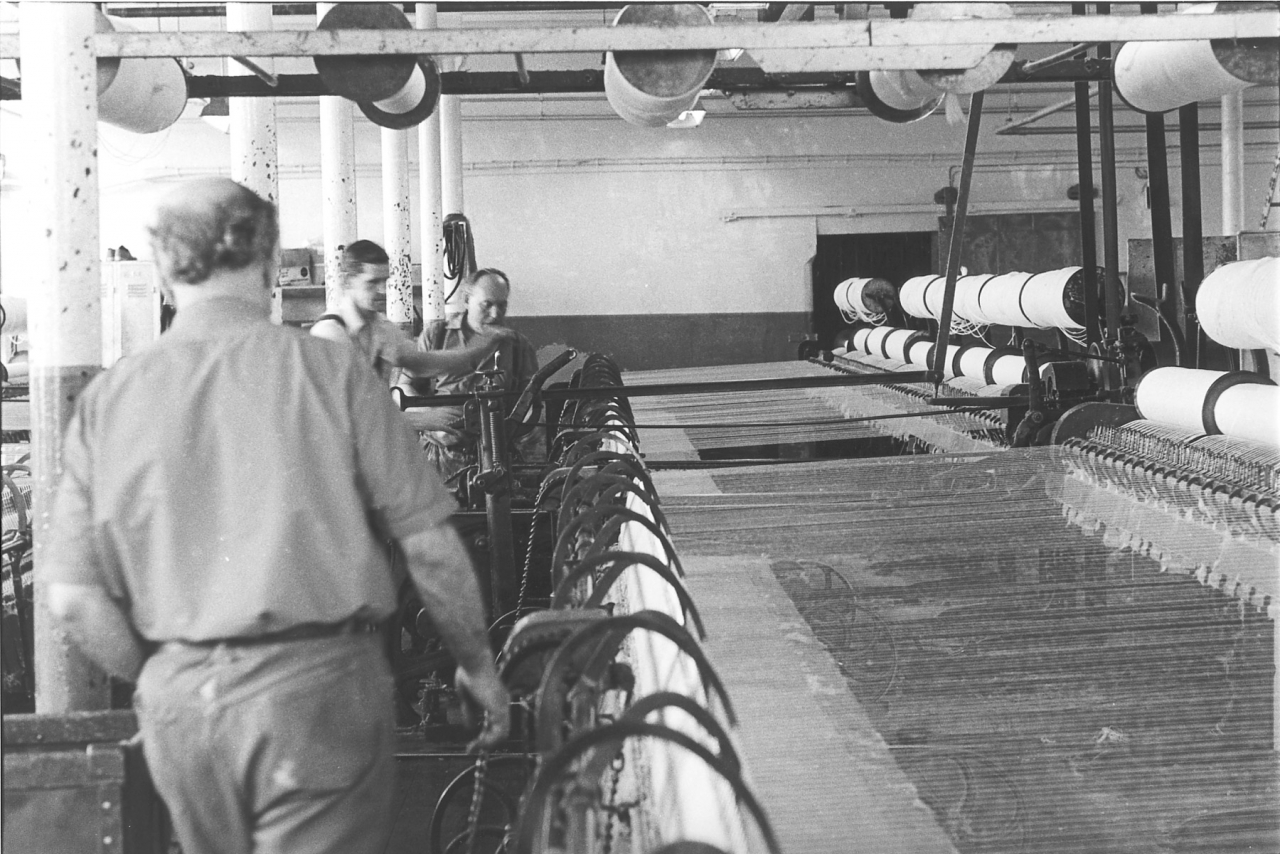
R- That's right 41, but that is the same, your mule has gone on the back. It is now spinning at its fastest, waiting to reach, rewind back on to the cop.
What do you mean when you say ‘On the back’.
R- Well, what we call, you see although you’ve got, we call this the front and that is the back, but in actual fact your mule running out to the front as you call it, we call that the back, the wrong way around to…
So like when the mule is out the middle…
R- When the mule is out at full stretch we call that the back.
I see.
R- Now when it gets there the spindles are revolving at their fastest, to put the twist in.
Right.
R – That’s when the twist is really going into it then. Now then, when that process is finished the folders [The faller wires near the pirns which control where the yarn is relative to the height of the pirn], they change over and then the mule starts going back into the roller beam. When it's done that then it start back, right?
Yes I am with you.
R - Now that’s as far as that picture is concerned. There is nothing else in there excepting as we have already said.
(40 min)
There are three men though.
R- Well this lad here was only put in for helping out because the tuber wasn’t working at that time you see.
So they’re just about ready to doff?
R- He's getting ready for doffing, the cops are getting nearly full. Right?
Right. Yes.
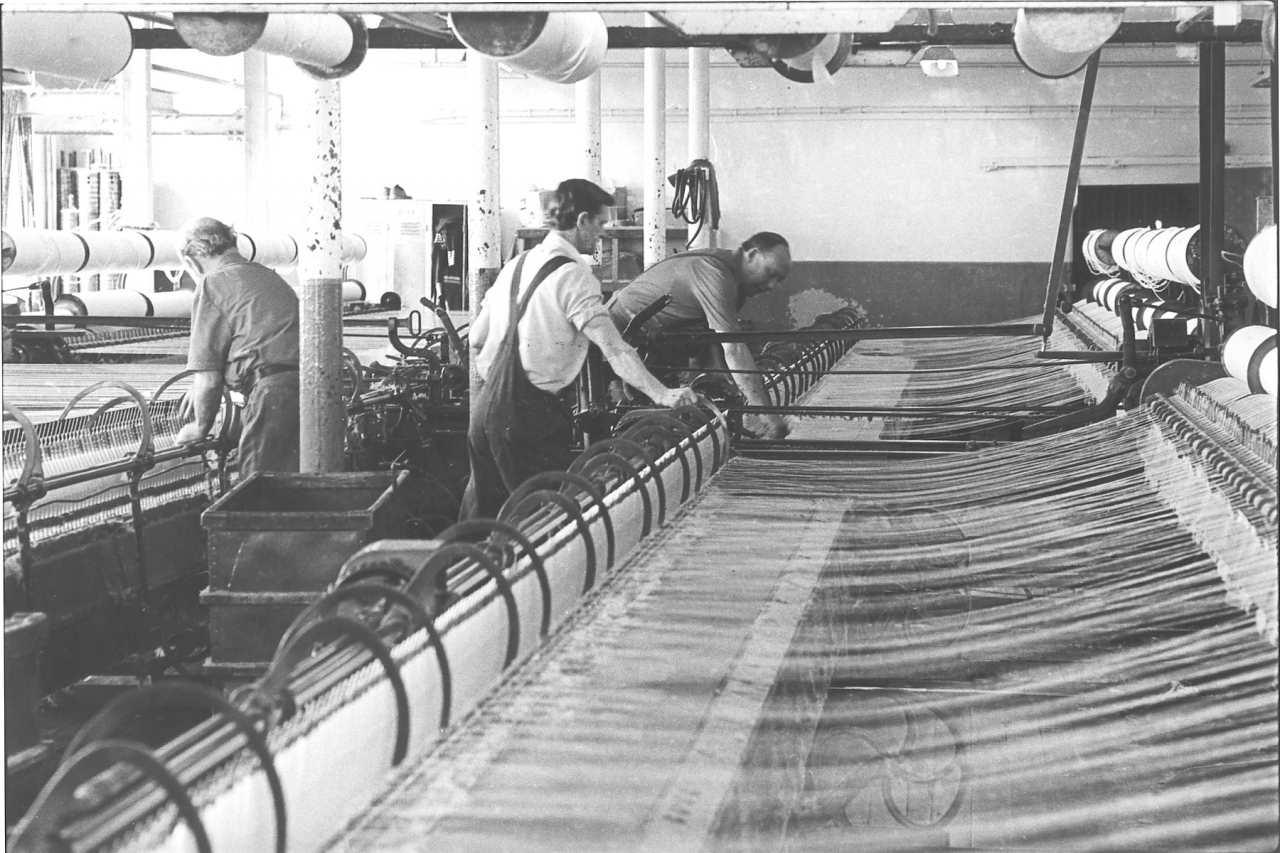
R - Now your next picture, number 44, that is, the mule is getting ready now for doffing, they have it stopped on the back, the folders are changed, they are pressing the folder down to put a hook on.
What does the folder do?
R - Well the folders [wires], one winds and one guides.
Guides?
R- Yes well it guides the ends as, it keeps the end taut, it keeps them really, really tight and the other one winds it back on to the cop with a rail that’s at the bottom which you can't see in this picture. And that is what they call, now they're getting this mule ready for doffing so they're hooking the folder down the winder will run the mule in a little bit so as the ends will finish up right underneath the bottom of the tube butt.
(800)
So that it’s easier to start again.
R- And then it’ll wind on and they can pull them off and the ends won’t [fall off] even though they have been broken, they can put the tube back on, and then let it run in again, so that it starts winding straight on the tube. Instead of piecing up. But there is nothing else there.
There is a little trolley?
R- Well, that trolley that’s in the wheelgate, that is only for when they doff those cops off. They put them into the box so that the weft chap comes along, he shoves the box out and fetches it out into the warehouse ready for loading on to the wagons for going back over to Grane Road for weaving.
In there a special way of filling that up?
R- No not like it used to be. When we were talking before about paste bottoms, then they usually doff them into what we call weft tins. Now there, you had to be careful because if you dropped them they break. They are really supposed to put them in as regular and straight as they can, they get a few more in and they don't break, the cop won't break unless it’s absolutely had a good bang because it’s on that metal tube. There is nowt really in that except they are supposed to keep them straight, but not the same as they used to have to do with the starched bottoms.
So it's not a specific size?
R- No, they’re not a specific size. Them cops are filled, they’re governed from start to finish. You can’t get them any longer than them. You can make them a bit thicker, or you can make them a bit thinner but you can’t get them any longer.
How do you decide when they’re full?
R- We have what they call a stopping motion in the headstock. What we call the stopping motion is attached underneath what we call the front of the headstock. This is a small lever and as the mule’s running backwards and forwards the motion’s turning, the small screw is going forward all the time. So when it touches a small bar which runs across, the small screw hits that bar and starts lifting it. Now when it gets up to that particular height there is another small lever underneath the headstock and that drops down and stops the mule from backing. It’ll let it run up but it stops it there on the back.
So it's not for the spinner to decide?
R - No it’s not. Sometimes when we go on to Welsh Hats, we have one in the mule room now running on Welsh Hat, we don’t bother to set that, we leave it to the spinner to decide. They can see to them themselves but some will try to get more on them than they should do and then they have them running over the top. If they do that they make it hard work for the weaver. Because the battery fillers have to pull all that yarn off before they can put them in the battery. The spinner makes it hard work if he does that and it’s up to one of us [overlookers] to tell them if we see them doing it, which they do every now and again.
I think you said there were fifteen hundred spindles did you?
R- No, five hundred.
Five hundred.
R- There's five hundred and ten spindles on this mule.
And there will be five hundred and ten on the other?
R - And five hundred and ten on the other.
And you have two men on each thousand.
(45 min)
R- Yes. Well there is a pair of spinners for a pair of mules. But that doesn’t say much because we had some down at Higher Mill which were seven hundred and odd spindles. The same thing, two men looking after them. Depending on what sorts they were after. Some of our spinners now that come from Higher Mill thought these were classed down as broad gauges as far as they were concerned because theirs were a narrower gauge but smaller. Now that kind of thing varies with the amount of spindles. All them were the same. Now in this next picture 43, they've actually got their mule run up, and they're ready for taking the cops off. Although they're talking like instead of getting on with it. But they've actually run the mule up and they are ready for taking the cops off. All the ends are reasonably tight, they don’t make them too tight because if you do the ends break. They just run it so far as to keep a reasonable tension on the threads.
The threads seen to be tighter on 45 than they are on 44.

R – Yes because as I say on 44 they were getting it ready. So, you see, when the mule backs itself up, just runs that little bit in, they shove what we call the counter folder down. So by shoving that counter folder down all the ends take up that little bit. The other winding folder that we talk about, they put a small block of wood on, a block at the the headstock, wind it down, that folder, then the counter folder runs right back underneath the butt of the tube. Then it’s wound on to the bare spindle is the end, and in 45 they’ve ran the mule in and the
(900)
end’s gone underneath the butt of the cop on to the bare spindle. And that’s how it comes to be that little bit tighter so that when they doff, that end’s still there on the spindle. Are you right with that one?
I am, forty seven.
R - Well that's in the same process. Well you've got one more talking to two more. Well, I can't say nothing about that because that’s exactly the same you see? You've got two identical photos there. The only thing is on this particular one Donald were over here, these two were talking, you’ve got the same picture, but these talking to them two then.
They're probably having a great discussion as to how they are going to doff.
R- No. There is no such thing as that. They are having a great discussion on which would be the easiest way to get out of doing the job first, or what football and cricket were like this year, week before or something.
SCG/14 June 2003
7,447 words.
LANCASHIRE TEXTILE PROJECT
TAPE 80/SHE/02
THIS TAPE HAS BEEN RECORDED ON THE 8th of APRIL 1980 IN THE WRAPPING ROOM AT SPRING VALE MILL, CHARLES LANE, HASLINGDEN. THE INFORMANT IS ARNOLD PARKINSON, MULE OVERLOOKER AND THE INTERVIEWER IS MARY HUNTER.
[SG note. Some parts of this transcript were virtually incoherent and I have had to edit very heavily to make sense. The principle I have followed is to preserve the sense and meaning rather than refine the original words. The message is that if you wish to make your own assessment of my accuracy you must go back to the original tape. Sorry if this sounds arbitrary but it was the only practical way to do the job.]
Now then Arnold, we had just finished talking about 46 had we?
R- We had finished about 46. Now picture 47 is .. well you can see that Jim is releasing the brake at the front of the headstock so as to get the mule wound up, get the ends to wind underneath the butt of the cops before they start taking the cops off. The ends then will be on the bare spindle.
So that it’s easier to start again.
R- So that it's easier then, I mean as soon as they took them cops off the other lad or lass which is in the wheelgate puts the tubes back on, the spinner shoves them down at a uniform level all the way across and once he’s done that, then the mule is ready for rewinding again and starting all over again with the same process.
Yes.
(50)
R- Now that one is just exactly the same.
Forty seven.
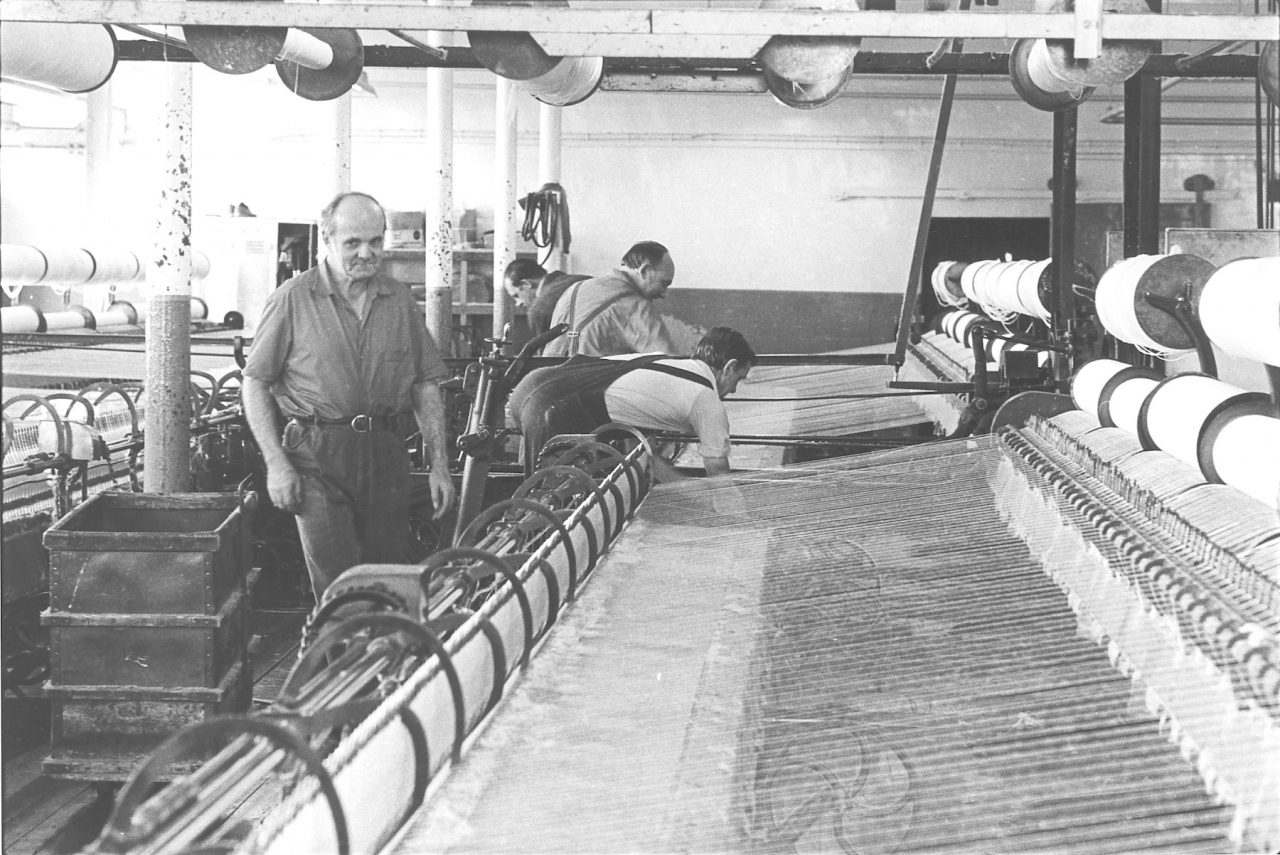
[51]
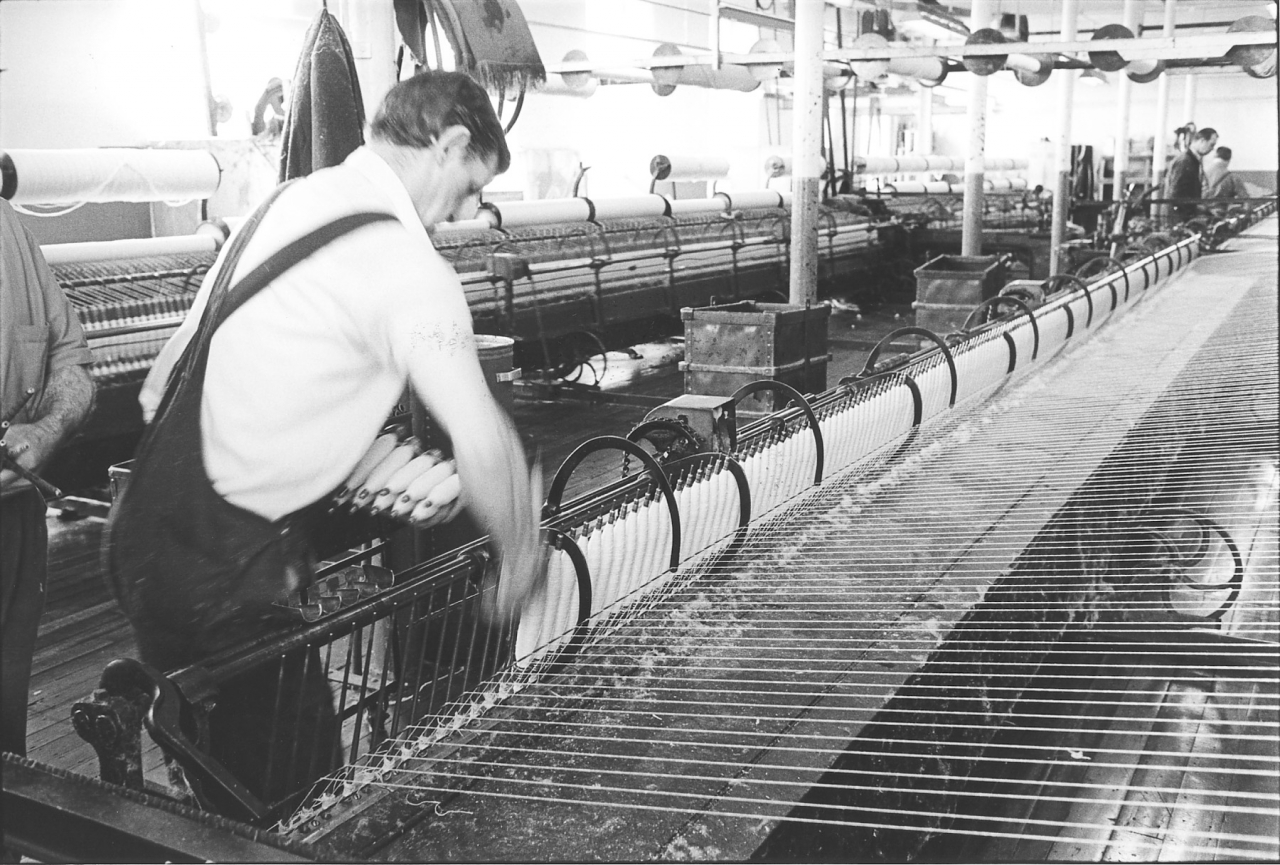
[52]
R- Now 52 you come back to the, well 51 is exactly the same only roughly an hour and a half or an hour and three quarter’s difference. He’s come back to the next doff and that's all there is to it.
Fair enough.
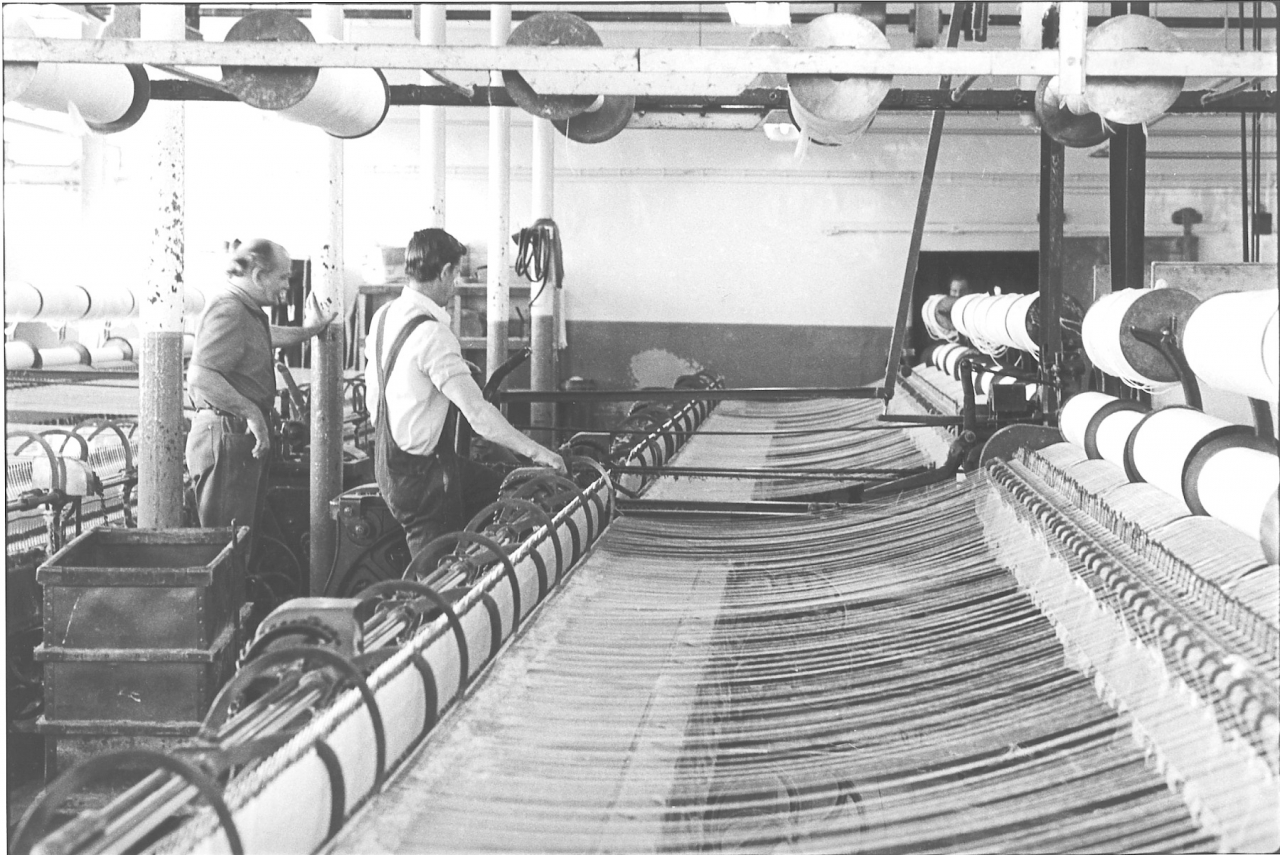
[49]
R- Now 49, is it 49? Yes. That shows where he’s let what we call the quadrant chain down a little bit, run it down, getting ready for restarting on the next cycle. His mate is winding the builder up then shoves the counter folder back down under the butt of the cop again. Jim is starting the chain up ready for the mule to run up before they start to doff the cops off again you see. That's all he is doing. Now once he's tightened that chain and run that mule up, them ends'll tighten up a little bit more back on to the bare spindle again. Then he starts doffing off again. When he's done that the tubes are put on and shoved down again level, and then they're off again for another doff.
(100)
So 49 is in some ways fairly similar to…
A- Well 49 is in the same line as 44 plus 45 and 47 you see? Now in 50 that is exactly the same procedure, they’ve run the mule up and they’re getting ready for taking the cops off.
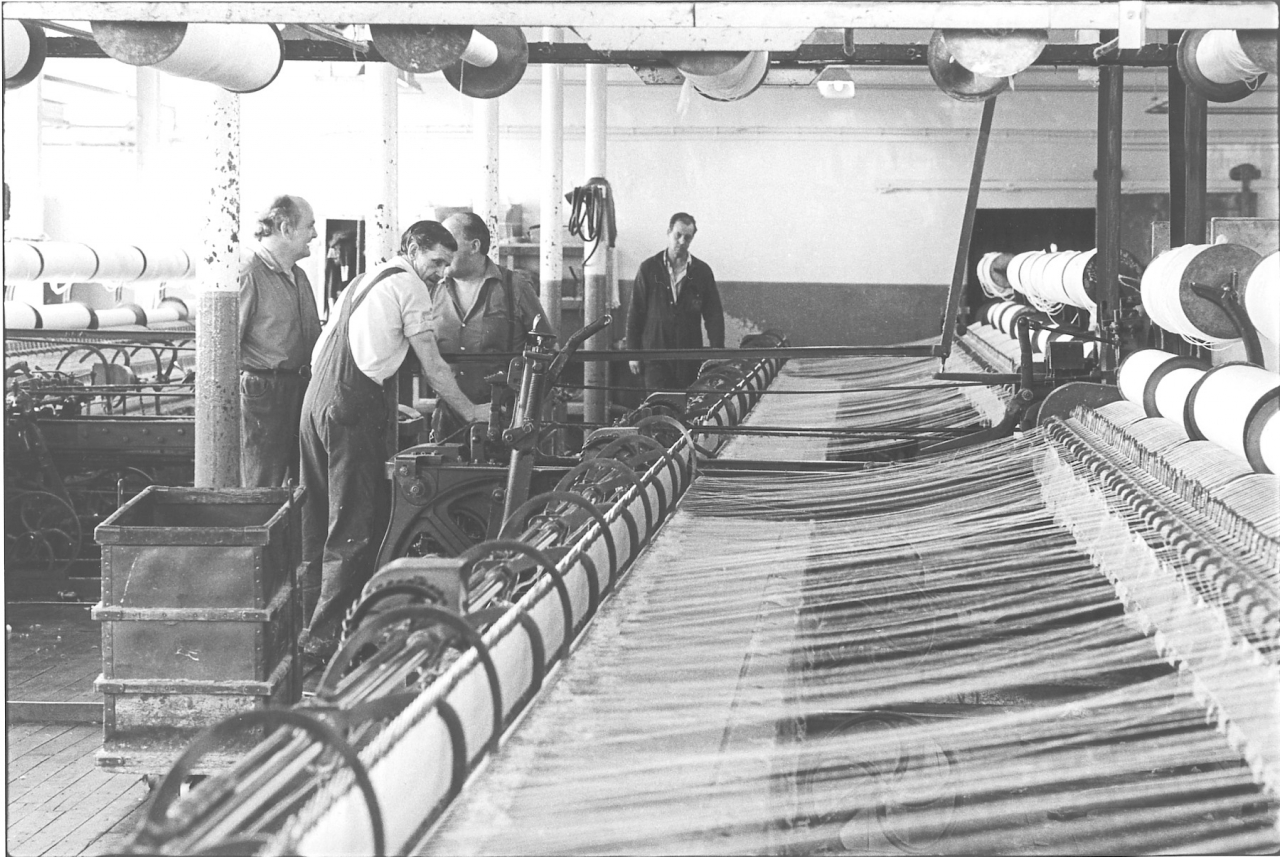
There's an awful lot of men in 50
R- Well there is, which shouldn't be as I say. There should be a young woman in here. We have got one lad in which is helping because the tuber must have been off work ill so he is just filling in for the time being to help doing her work, tubing. But ..
And you've been coming to help.
R - Well I came in to help ‘em, I mean to doff the cops so that the mule will get going a little bit sooner. But that isn’t our particular job. I were happen coming in, happen to see that there were none running over the top of the tube or whether there were something else wrong with the bottom of the tube. I just can’t remember.
The thread seemed to be rather uneven on that…
R- Yes well, as I say, it’s because they haven't run the mule in that little bit just to start doffing the cops off. You see they are in the process of letting the mule run up that little bit before [they doff] and then they can start taking the cops off, then the ends will be that little bit tighter.
(150)
Yes I see, yes.
R – Now, picture 51, that shows where they have run the mule in that little bit, the cops are ready for coming off because the other lad at one side is already doffing off. Jim is taking a little bit of quadrant chain back off so that it's ready then for when he has doffed his cops, re-tubed them and everything else and shoved them down. That mule then can just, the folder can just be unlocked and the mule can set off again ready for the next doff.
What is it, a quadrant chain?
R - A quadrant chain, that’s what we call it.
And the chain, that is responsible for…?
R- It’s the chain that is responsible for the tightness of the cops for one thing, and also the building of the cops.
The winding? Oh I see. Yes, right.
R- From start to finish, if that chain weren't on, the ends would just all be, all curly all the way through. You know, they’d never wind on.
Yes, I am with you.
R- They'd be anywhere. That's what that chain is for. As I say, I could show you now, 52 is a good example, a good picture to show you exactly what I mean with the ends being reasonably tight. They're underneath the butt of the cop. Jim is doffing the cops off the mule but the ends are still there, they’re not broken. In actual fact they are not broke from the roller beam, they're broke from Jim’s cop you see?
Yes. Does he actually break them, or…
R - He has to break them. Yes that's what I said when I said before. The way a lot of mule overlookers play heck many a time with spinners for having what we call a sawney, that's all the ends is broke down. But yet every time a mule comes to doff every end is broke down. No matter whether he doffs once in a day or twenty times in a day. Every time that mule doffs all them ends on that particular mule are broke.
How does he break them then. Does he .. ?
R - Well you see, as I say, it’s wound back down on to the bare spindle. Now then it's wound on the bare spindle and he breaks the ends just by pulling the tube up.
So he is actually breaking them when he’s doffing. Right.
R – When he is doffing the ends are breaking.
Now what did you call it when all the ends were down?
R- When all the ends is down on the mule, that's through some accident or something in that line, we call them sawneys.
And how on earth would you spell that?
R - S a w n e y. And that’s all. I mean, we play heck many a time when they have them but as I say every time they doff they break all them ends down. That’s all there is to it.
That's right. There seems to be some skill in actual doffing.
R- Well it looks that way to somebody that’s just coming into the mill, but in actual fact it's just a matter of getting your hand set and having the balance of the cop on your hand right. A lot of people when they come in and they get hold of a few, they're fiddling about and they might put the cop over here and they might have one side over here, and they start stumbling with them. It's only a matter of what
(250)
you’d call practice and balance. That's all it is.
Yes, yes. How many can you carry at once?
R- Well, depending on the size of the lad and everything else, but mostly with these metal tubes if you reckon about sixty odd, eighty, happen about eighty cops on his arm he's got a lot because he gets a lot of weight because every one of them tubes, every ten of them tubes I should say represents a pound. Ten of these empty tubes, before any cotton's on, represent a pound in weight. So every time he doffs one bobbin off he's got three pound, plus the cotton on the top. [Arnold is way off beam here. According to his figures 80 cops would be 240lbs plus the yarn, obviously wrong. I reckon they’re nearer half a pound each, full of yarn.] He gets another but he gets a bit of weight in his hands then. So when we talk about going on to Welsh Hats or paper tubes you can doff, depending on the size of the mule, but on our particular sizes, them at 540, if you are doffing Welsh Hats or paper tubes you near enough doff ‘em all off in about two armfuls. You know you've got a good armful but you can doff ‘em off in about twice.
Well yes, there is much less weight there.
R- But there is less weight and everything else as you say.
Very good.
R- But I mean otherwise, I mean .. it depends on the size of the cops.
Right. In the new folio .. 53.
(10 min)(300)
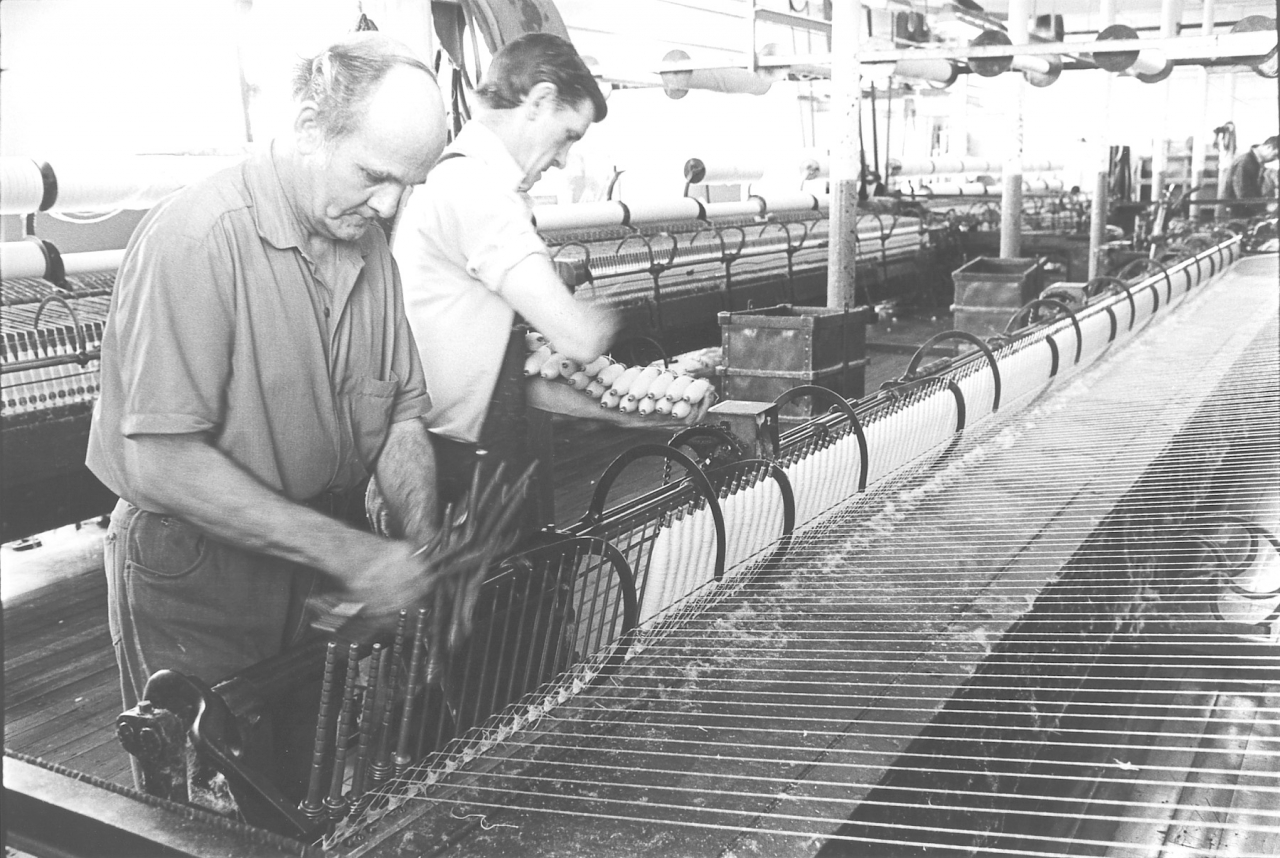
R- Oh this is the same procedure again, excepting where Jim is being shown in the other one doffing off, it also shows here another lad putting tubes back on the spindle. Now then when they've doffed all their cops off the mule and Donald has put all the empty tubes back on, Jim comes back up and starts to shove them tubes back down as level as possible with a small piece of metal.
Yes. There is a photograph of it, actually.
R- Yes. There is a small piece of tin which we've had shaped out and that for the tubes and everything else cut out so that they all get shoved down to the same level.
Normally now, there would be a tuber doing this lot.
R - Well normally we’d have a tuber, yes we’d have a young lass or a woman doing it.
There seems to be quite a lot of skill too to putting the new pirns on.
R- No, no, I mean that particular thing is not skilful or anything else. It's just the matter that when you are putting the tube on you've got to be careful with your hands on the top of the tube for cutting your fingers and things like that. But it's not really what you can call skilful as much as it’s the knack of getting used to putting them on. You know, it’s not hard.
Well put it this way, I was fairly impressed when I first saw it.
R- because as I say, you would be more impressed if you’d seen young Pat, that’s probably what you're meaning, in the top room, because she has been doing it ever since she were fifteen when she started here. Now the lass is about twenty-three now. Through the years she's got used to these spindles and she could put them on without any bother.
Is she the very slim girl?
(350)
R - Yes that's right yes.
Ah well, it was her that I saw.
R- Yes well as I say, young Pat could leave anyone of them here standing. While they were looking at a mule she’d have it doffed and tubed, Pat would have it tubed and be waiting for the spinner coming up at this end. She could put them on before they took them off. I mean, she can keep up with the spinner taking them off and the spinner’s taking three every time and her only one or two on. But yet at the same time, although the spinner should be in front she’s keeping up with him because she goes that fast. Aye, a good little kid.
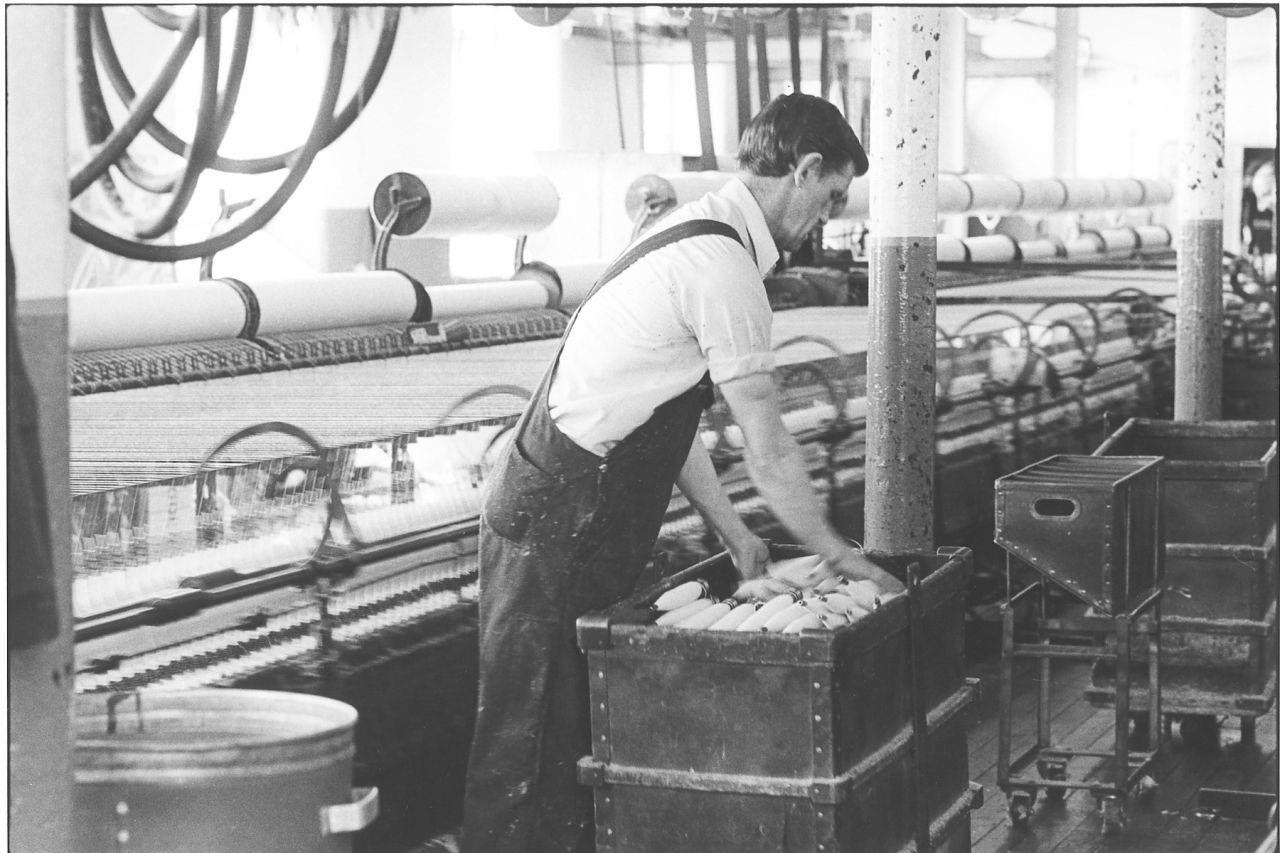
Now in 54 it shows where Jim has doffed his cops and he's putting them into the small box which they have in the wheelgate with wheels on, and he is putting them in there so that they are ready for going out and going down to whichever weaving shed needs them. That’s your tubing trolley you can see there, that’s where the tubers put their tubes for putting them on the spindle.
I've seen these trolleys full and all the pirns are the right way round.
R- Well they're all put in that way, they’re all straightened out ready for the job. That’s what the tuber does.
And that’s what the tuber does while she is waiting for the next doff.
R- While she is waiting for the next doff she re-fills her box by putting them all in straight that one way.
Yes. And Jim sort of lets go of all the pirns when he is putting them in the trolley?
R- Well, when he’s doffing them down he just puts his hand down there when he’s got them all on to let them go into the box. They should be put in as straight as possible so that they are not damaged in any way.
This photograph also shows a lot of…[fire points]
(400)
R- Well that photograph shows the hosepipe on the wall. We have one at each end of the mule room. We’ve two pairs in the middle room, so we’ve four hoses on in case of fire.
And is that fairly common?
R – Well, it is here. I'll not say common in a lot of mills because a lot of mills hasn't even got one in, some has got one, others have got these fire extinguishers and things like that but we have both, both for motors, and from the mule room point of view for fires and also fire extinguishers besides.
(15 min)
So you’re fairly safety conscious.
R - Well it's not just a matter of being safety conscious, the idea were from the insurance point of view when they were put in the first place. Because like a few years back we had, not in this valley but in Yorkshire I think it were, I couldn't name the particular mill now but there were a big fire at this particular place. And I think if I recollect right, I think there were supposed to be about twelve people or something burnt, at that one particular mill. Due most probably, and I don't know off hand, but I dare say quite a lot of it were due to lack of supervision in their department and not making sure that the extinguishers were filled and ready for use. And most probably had no water pipes or if they had either the hose-pipes had been cracked or caught or something else and never been checked. You see, as I say, I will honestly say about that, they are very conscientious on that, making sure that the hose-pipes and that are kept in good condition for that one reason. And we know because we’ve had one or two fires here, even in the mule room.
(450)
Have you?
R - Oh yes I have had this mule here afire twice. We’ve had the middle room afire. The mule which you are looking at now as a matter of fact and we could never find out what caused that mule to fire. There were nothing, we never touched that mule from that day to now, never touched that mule, but yet one particular day that mule set fire. Personally, I were dubious but I couldn't prove it because we never found one, but I think somebody, more or less in a joke, brought some match ends off a match and put it somewhere around the carriage, so that it were against the tin roller or something running that fast as it sparked it off.
Yes, friction.
R- Yes. And that’s what I think really happened although as I say we couldn't prove it because the mule was running and as luck would have it we were there. I were there at the time. There were no oiling or anything being wanted, it just set off in the air.
Very good. Fifty-five.
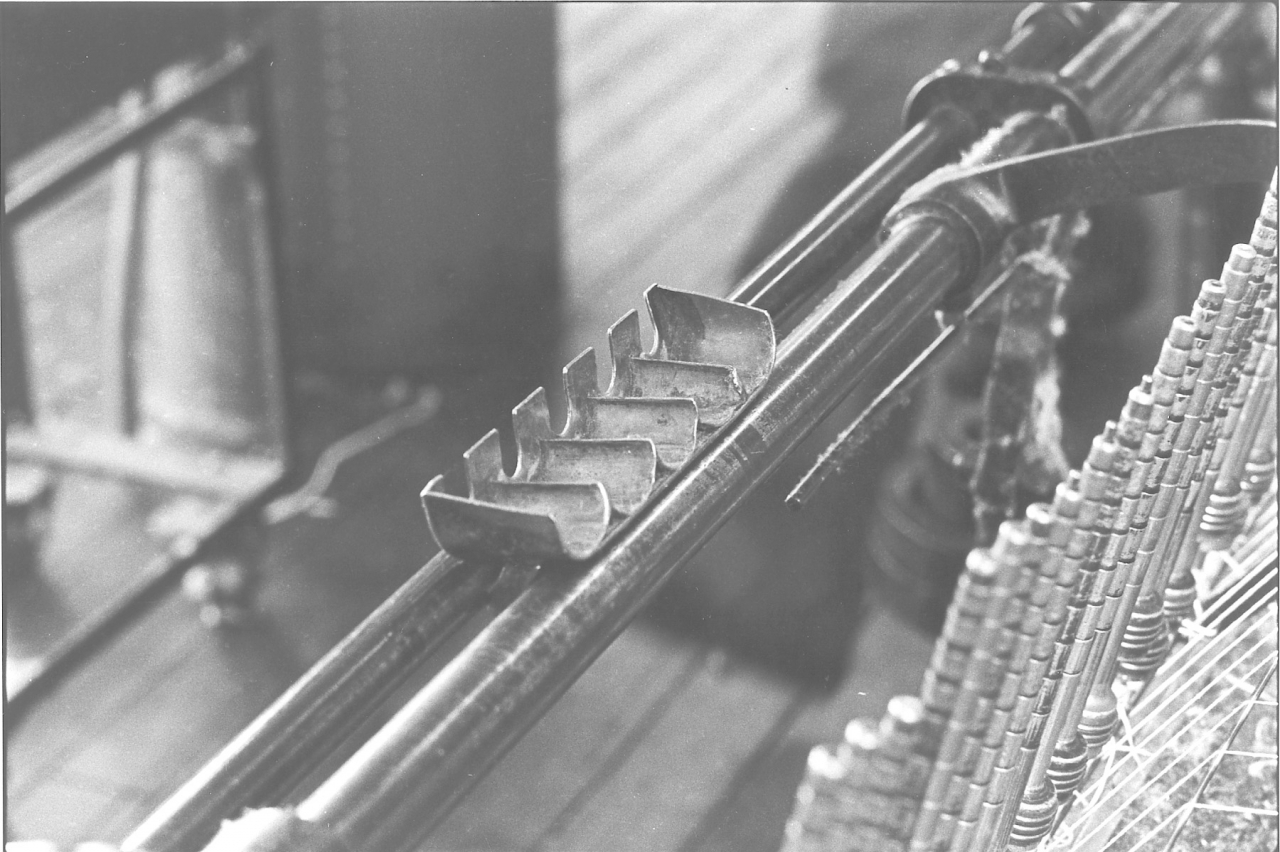
R - Now, 55. It shows you where the empty tube's being put on to your spindle. There is also the thing which we call the presser which shows its shape and uniform length of it for pushing the tubes down. Now all the spinners have one of them apiece so that five holes will go on to five of them spindles, fix the tubes and they are all at the same depth. I mean, provided there in nothing in the road of the tube, there's no waste or anything like that underneath that will block it from going down and there is no waste in the tubes, that tube will shove down to that particular height. Now all these tubes do the same.
(500)
It also is a very good photograph to show the threads at the bottom.
R- Well the threads at the bottom yes, it's a good photograph is that as the threads there they have been wound underneath the spindle. Now, I don't I know, I haven't seen the next photo, but you see I mean, as soon an them tubes are being shoved down, then the folder is unhooked, the winding folder, the block is took out, the counter folder is unhooked then it's ready for running up.
Yes. There is obviously some pirns being pushed down and the rest of them seem to be …
R - One or two, one or two looks like that, but I mean what happens is you have a small rubber at bottom of your tube and sometimes they get a bit worn and they’ll drop down that little bit like that and it looks like they’ve been pushed down but in actual fact… I mean, the tuber might even have just shoved them happen, you know, while waiting for Jim. But that is that process. Anyway, 56, what's he doing here? Got me guessing here.
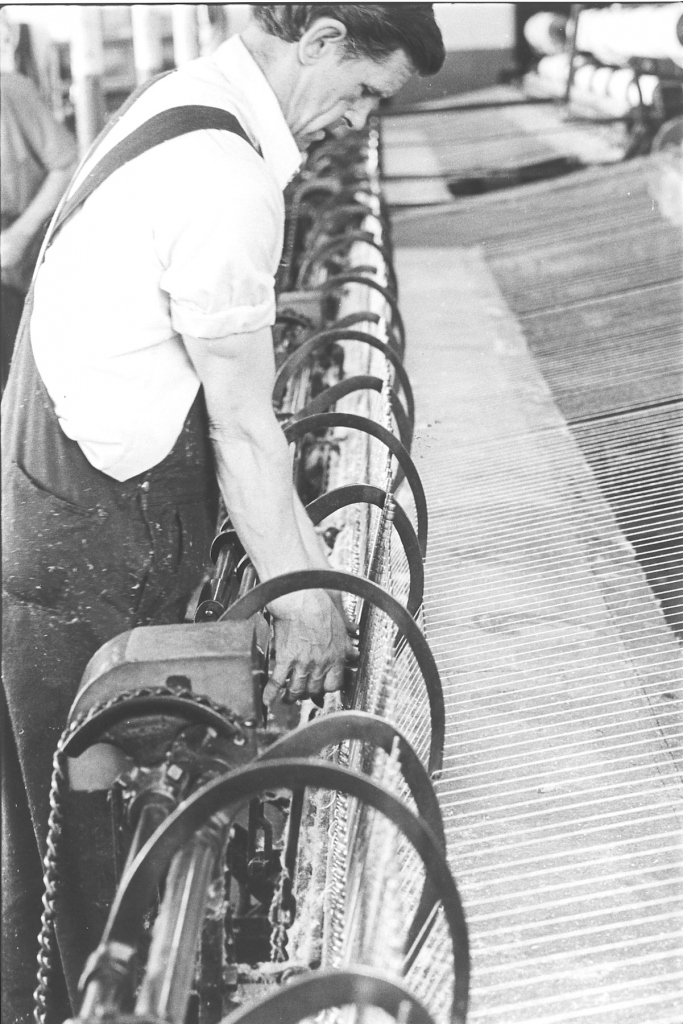
Pressing isn't it?
R - Oh yes, aye. Ah well, I couldn't even see on here. That’s where it shows the spinner shoving the tubes down, it shows him where he's shoving them all down so that they're all level ready for the next process in filling up again. And I can't say very little else about that. Now then 57 is a good picture.

It is isn't it?
It's a good picture that where it shows where all the tubes being shoved down even, the ends are underneath the butt of the tubes ready for the folders to be unhooked, the block to be took out so that the counter folder lifts back up and the winding folder also comes back over the top.
The wire that the threads are on ?
R- The wires? As I say, the guide wires, they're only like a guide wire is them.
A guide. Yes.
R – Yes, that's all they really are. And the counter folder, your bottom one of all which is below the cop is what we call the winding folder, that's the small one ..
Yes. And is that this one that ...
R - Right at the very bottom.
Left hand corner?
R - Yes. That's what we call the winding folder. The other one at the top now, that is just what we call a counter folder, that is where the weight ... in the mule room, in the wheelgate you’ll see three levers, sometimes you'll see four depending on the length of the mule. But over the overall length of the mule you'll see weights in a mule room which go up and down on the mule's backing up. Now all that that weight is for, that keeps that one particular wire reasonably tight.
I see, yes. Fifty-eight coming up should be…
R - Should be..
Yes, 58.
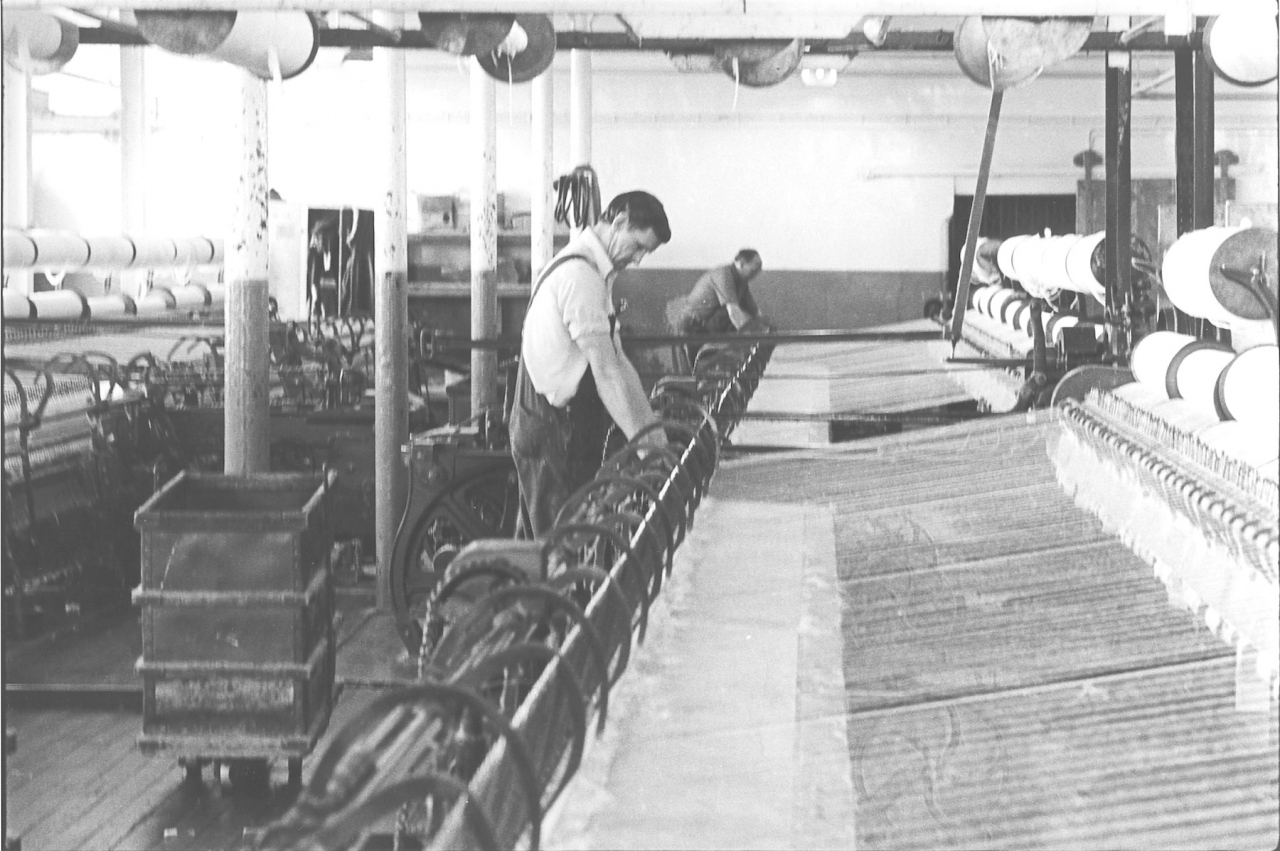
R- Now 58, that shows the same again. Jim’s finished the shoving down part. He’s waiting for his friend now I think to come back up to the headstock with him, why I don’t know. He should have had his folders out and be ready for running again now.
Is that an end down there?
R- No it’s more than likely it's one that's been run double you see. Sometimes if one end breaks it might catch on to the other one and when he is, when the mule has run back in he'll come back up to this empty tube, wind a small bit on, and then re-piece that one up.
(600)
So there is two threads in one there. I am with you.
R - You sees there’s two threads in one there, that’s why you can see that broad gap there. See just here, there's another one there with a couple of ends broke down at the side of the headstock. Well in actual fact they are not broke there, they are broke on the bobbin because you can see the space in between the bobbin on there. Can you see how dark that bobbin drum is?
Don't miss much do you?
R - No, well that is what it is, it’s the ends in the bobbin. There'll be two ends there, there'll be a small hole in that bobbin there. And that’s where the ends are down, on the bobbin not on the actual mule. Now picture 59.
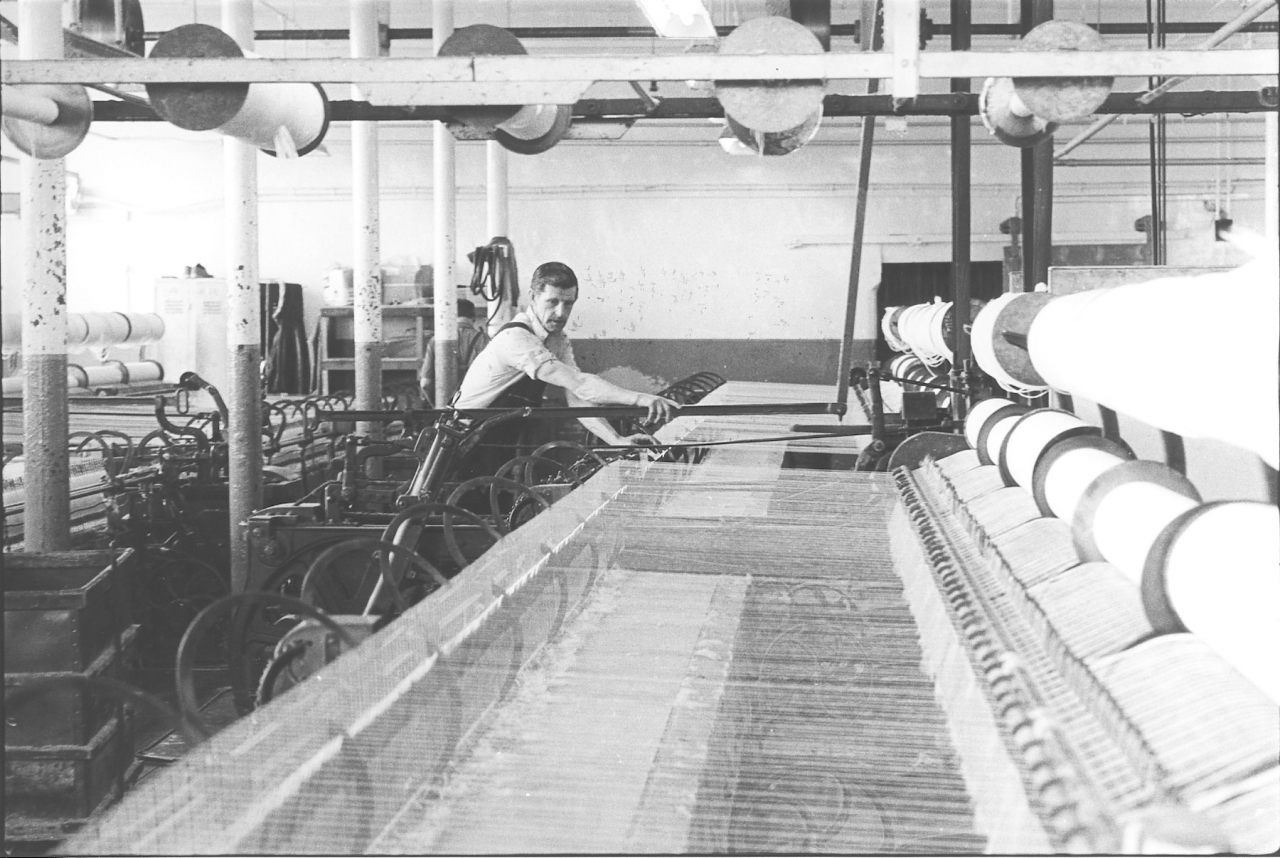
It shows Jim where he has unhooked all his folders, he’s took his block out and he is running his mule up over the butt of the cop so that he just runs it back into the roller beam and starts all off again filling up for the next doff round. Them's all empty tubes starting there right from the beginning.
What do you call these semi circular…?
R – Sickles. We call them sickles.
Sickles. What ... ?
R - Well if you just think back like, when they talk about gardening with a sickle
Yes, they look like one.
R - Well as I say the mule is all different parts. They call it a mule because it has no
(25 min)
It's a combination
R - It's a combination of quite a lot of things and I mean, the things what the bobbins are on here at the back of the mule, all them things are called stag horns.
Stag horns?
R – That’s right
They are.
R- There's even things at the bottom which you can’t see here, which you call pigs feet and all different. There’s numerous things that have been filled in through the years you see from one overlooker or one spinner and that ... They all have their names like it should be called in a brochure, but they’ve all got these particular names, they are known for it you see, I mean when you want something you know what you're asking for.
When you’ve got nothing better to do Arnold you have to draw me a picture with all these names on.
R - Then I wish I could, it would take me a long while. Now 60.
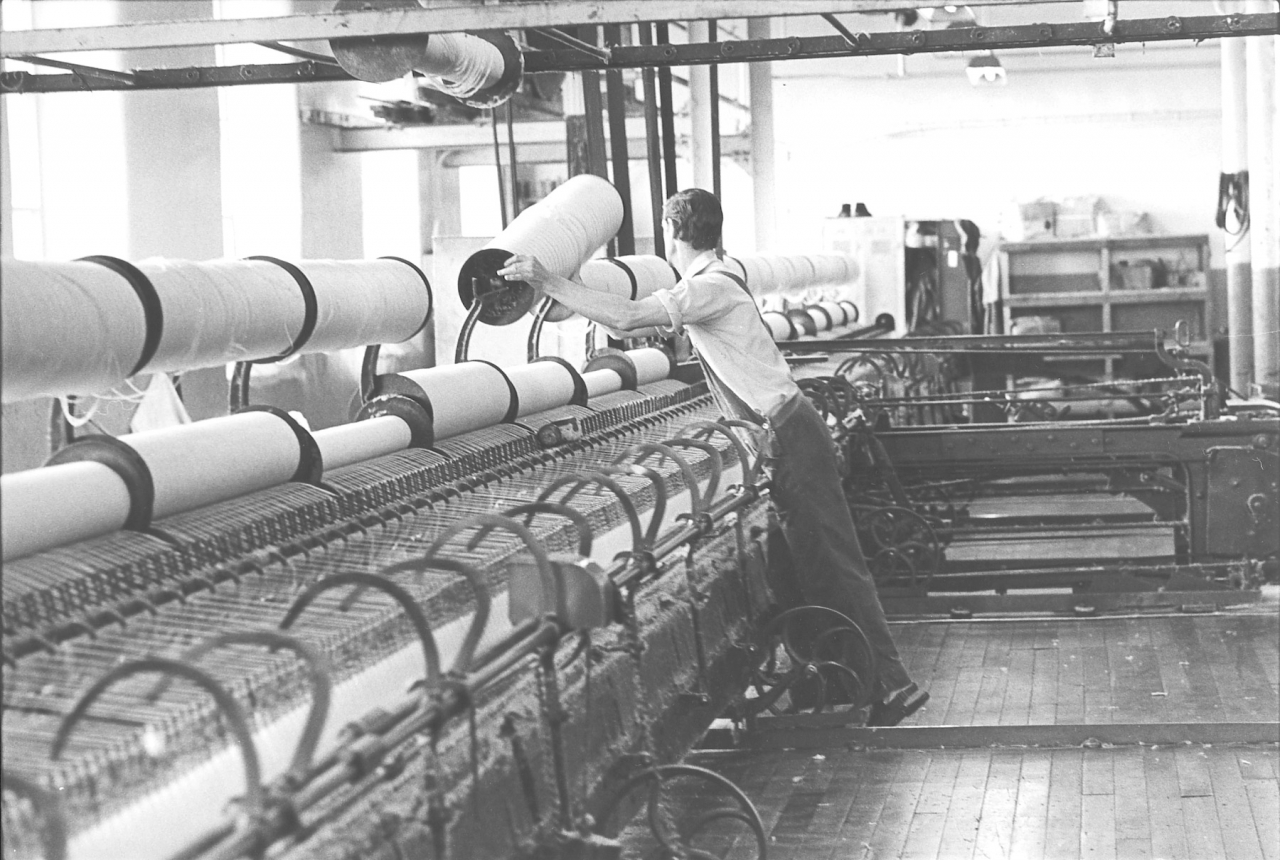
The mule is actually running out that little bit. It shown Jim
(650)
putting a bobbin on to what we call the stag horn. He is filling that space up so that when the bobbin comes empty he has one ready for going in.
There is a lot ...
R - A little bit further up it shows where all the waste.. the ends broke down and the waste is on the top of the tube. And
In the left hand corner?
R – Yes, it shows all the waste there so when he's done that then his next thing will be to come up here and piece that end up but not in this one particular draw because the mule will be too far out.
That’s right. It's a lot of forward planning, isn’t there for a spinner?
R - Well how do you mean with forward planning?
Well, he's got to make sure he’s got all his bobbins ready.
R - He's got to make sure all his bobbins is ready yes, I mean, providing the bobbins is coming from the card room.
Yes.
R - On the rack there it comes through the spinning room. I mean individually he has to make sure the mule is filled up with bobbins or a few so that he has them to put in.
The bobbin rack in fact is shown on the top part of this photograph but it's looking very empty on that particular day.
R- That’s right. Well that’s a good thing, I mean because if we don’t have a lot that means the spinning is good and the spinner has no complaint you see?
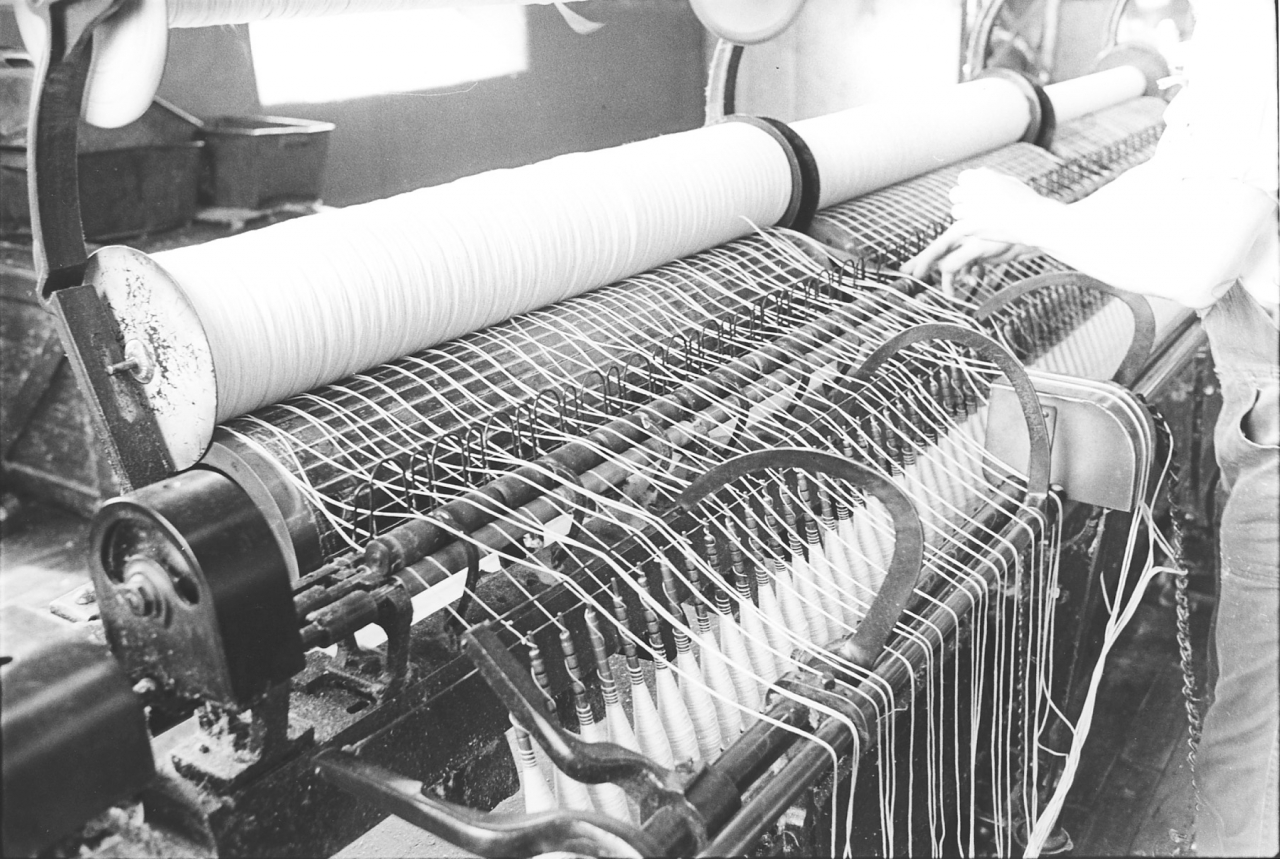
Now 61, that shown where they've .. one bobbin has come out, and they’re re-piecing another bobbin in which really, I mean without finding fault in this one particular picture, it is a bad example of spinning from the spinners point of view, not for the mule or anything else, but for the spinner it is a bad one. Because by rights, that spinner should break all them ends out before he drops his bobbin in. You see, if you see this picture you see all them ends there are going to be double. Now that mule running out is stretching them ends so if you've got them out, we'll say nine or ten inch of end and you've got that other seven or eight inch from the bobbin to the to the
(700)
steel roller being pieced up, you've got roughly about eight or nine inch of a double end. You see, you’ve got two ends ...
Oh I see yes.
R - Now them should be really broke off just at the back of the guide wire.
The old bobbin. Yes?
R- The old bobbin. The one they took out should be really broke off just at the back of the guide wire and then the other ends put like they have done but pieced up so that it’s only a short one.
I must say that I was helping Jim that day and it was done from just behind the wires.
R- That’s right, that’s what they should do. They should always take the bobbin which is being finished with out first before you put the next bobbin in so that you haven't got all that double end. Because although that will be twisted, drafted and stretched it’s still all there, that double piece and when that set of cops goes into the loom the double ends will show up in the cloth. It shows up that double end all the way across the cloth.
(30 min)
It would he a fault in the cloth then.
R- It would be a fault in the cloth. If they were looking precisely for something in that line you know? And it shows when the cloth is being woven. It shows them particular points. Now that is the same except in this one particular thing.
Number 62 are we on?
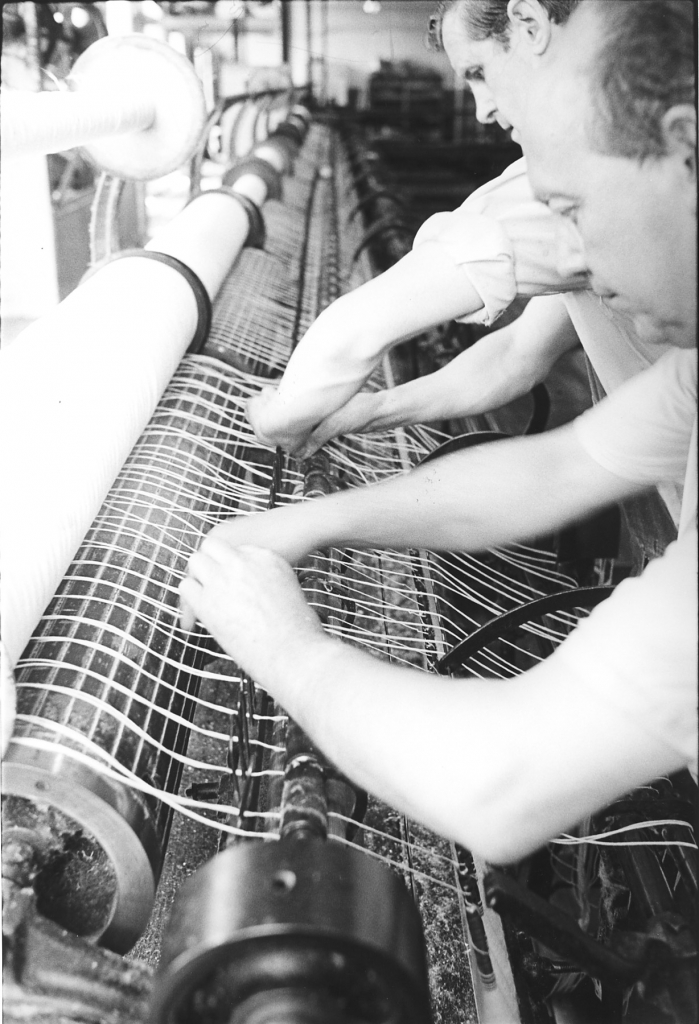
R- It shows the two spinners piecing the ends up. And I think in this picture they have taken the empty bobbin out. So that they haven’t got all the double ends they are still on a single end but for piecing one end up to the other. But it’s only a small piece. But one particular point, which I mean is bad on this one bobbin which is being shown is the unfortunate look of this bobbin. Real uneven that.
(750)
Is it not because there are two ends there?
R – No. There's no end under there you see, no end running up the bobbin. That is a bobbin fault what's come from the card room side and all them lugs there, as soon as that mule starts drawing out, it will draft them out that little bit thinner but on the other hand them five or six ends there, they'll just break.
There still seems to be two ends there.
R - Yes there is one or two ends in where they shouldn’t have been. But they have took the bobbin out and the biggest part of the ends are all small piecings up.
Is it very usual to have the two spinners helping each other when they have ...
R- Yes, that’s why they call them a pair of mules and a pair of spinners. If you can get a pair of spinners working together as a pair, then obviously you get more weight off. You get that bit more uniformity in conscientiousness and everything else at the back of it. Which really is what you are doing in a mule room.
So there's got to be team work.
R - It's all team work really. It’s team work all the way through the mill but mostly in the mule room. If you get two spinners which will work identical to one another then you’ve got a good set up. I know you can't always get it, but if there is any possible chance of getting two lads working together as a pair, and they work together good, then you come up better, the stuff that comes off comes off better and it’s better all the way round.
Do you find there is any competition between one pair of spinners and another pair?
R – That’s always gone on in the mule room, well ever since I came in, say for thirty odd years.
Do you think it's a good idea?
R - Well a lot say it's a good idea. I mean sometimes it causes a bit of friction but at the same time, as it did like a few years back, waken the other pair up, an they'd start shaping a bit. As I say, a few year back the manager’d come along and start querying "Why are you only getting this off?" and "Why is this particular weft that you’ve got not as good as what they are getting downstairs?” you see so although it did cause a little bit of friction it also helped them along as well.
It keeps everybody on their toes.
R - And it kept everybody on their toes. I mean it's good all the way around but I think it worked through the years.
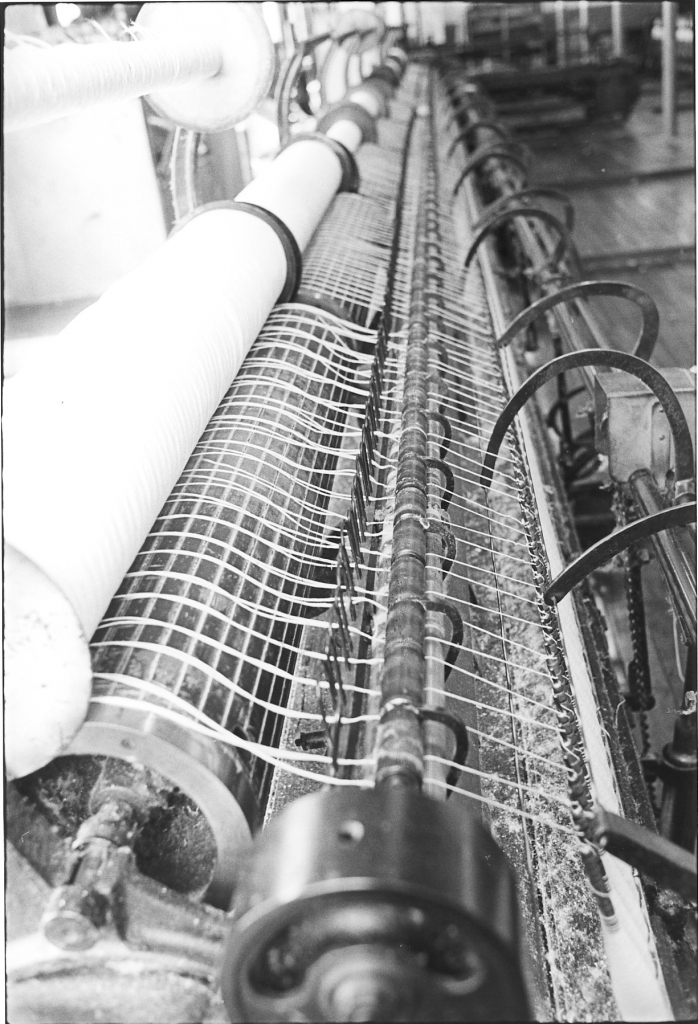
Now picture 63 is where they piece all their ends up, so the mule should be ready for getting set on so that all them ends, the bad ones and that as well, you'll see where they start drafting out.
But they’ve pieced them really, just behind the guide wires.
(35 min)(850)
R - They piece them up between the guide wires and the leather rollers. You’ve two fluted rollers and a small leather roller on the top. Now then, the ends are pieced up between the guide wire and the leather roller and the fluted rollers.
And the rollers are these small rollers on the top.
R - And the rollers are on the top and they’re all what we call leather. There is synthetics and that but they’ve never succeeded, not in the mule room.
And the ends from the old bobbin will be drawn out on the next ...
R- The ends'll be drawn out onto the next doff yes.
Very good.
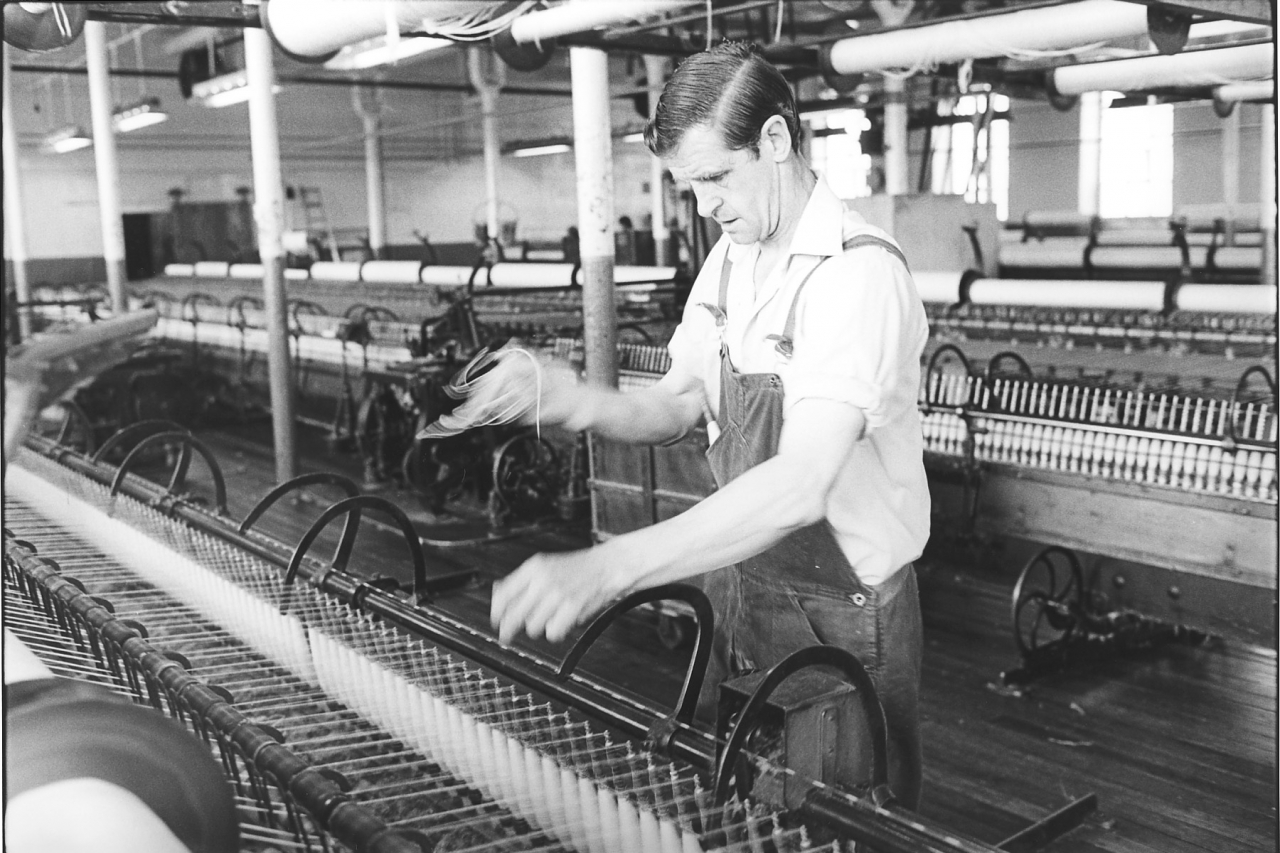
R - Now it shows in picture 64 where Jim has set the mule on, and he's waiting to see what these ends are going to do.
He looks as if he is having problems.
R - Well he isn’t having problems as yet, but he is still waiting for them because it's only on its first speed.
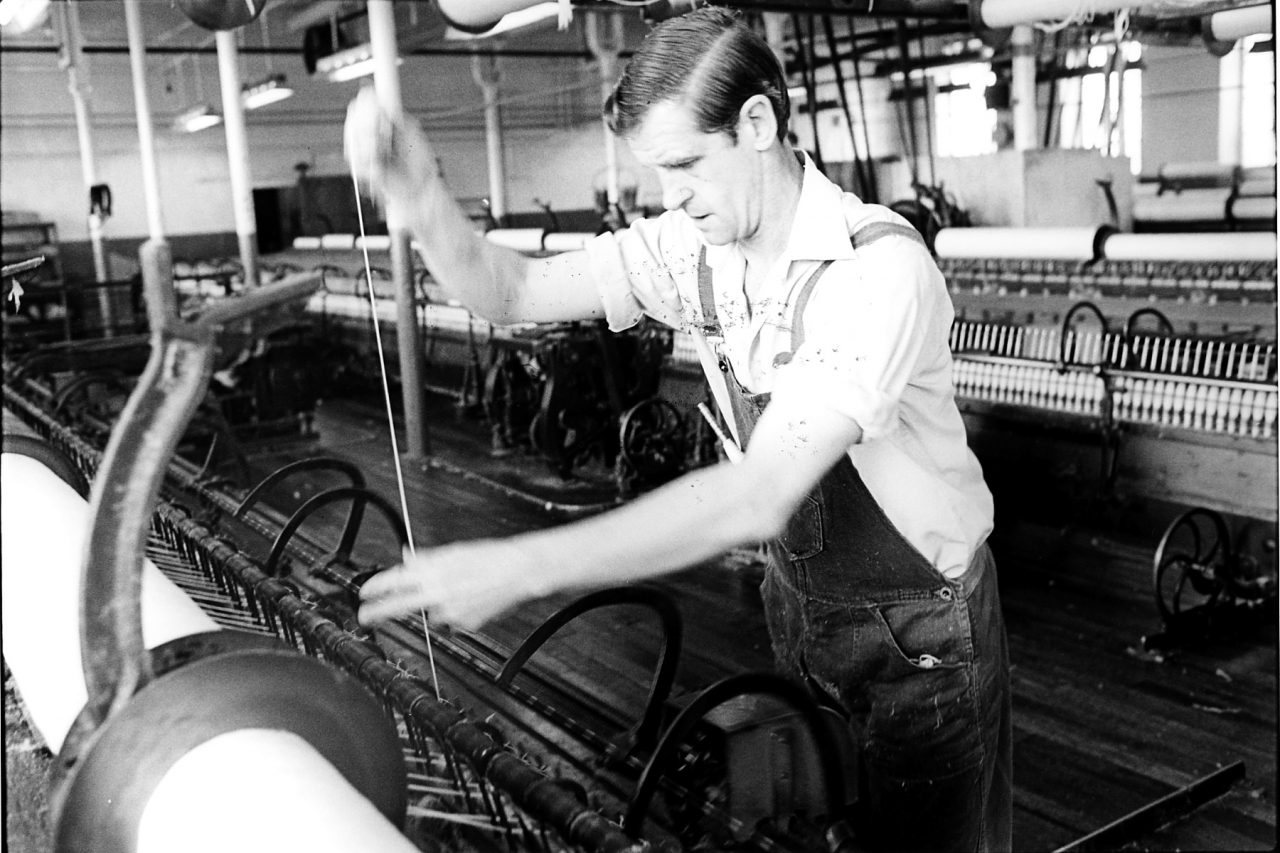
Now in 65 it shows where the mule has run in and the end we were talking about has actually dropped down. And it shows where he is piecing one up at the roller beams.
And that's called taking an end up?
R- That’s taking the end up, piecing it up as near as you can to the roller beam.
Would you say that that's the most difficult job?
R - The piecing up part in a mule room is the most difficult for a spinner.
I certainly had a lot of trouble.
R - Well it is. I mean for anyone that comes in to the mule room that's never done it before it is one of the hardest [things to do] Not hard but difficult as you might say. I mean till they've got used to working with a mule running backwards and forwards. And that really is a spinner's fault is that. And they're getting used, they can get used to walking backwards without looking then they'll get into piecing up their ends without bothering.
Yes it's the whole business of a machine moving isn’t it?
R- It’s the whole, that's what a mule is, the mule’s running backwards and forwards all the time. And there's nothing else you can say. What’s these others?
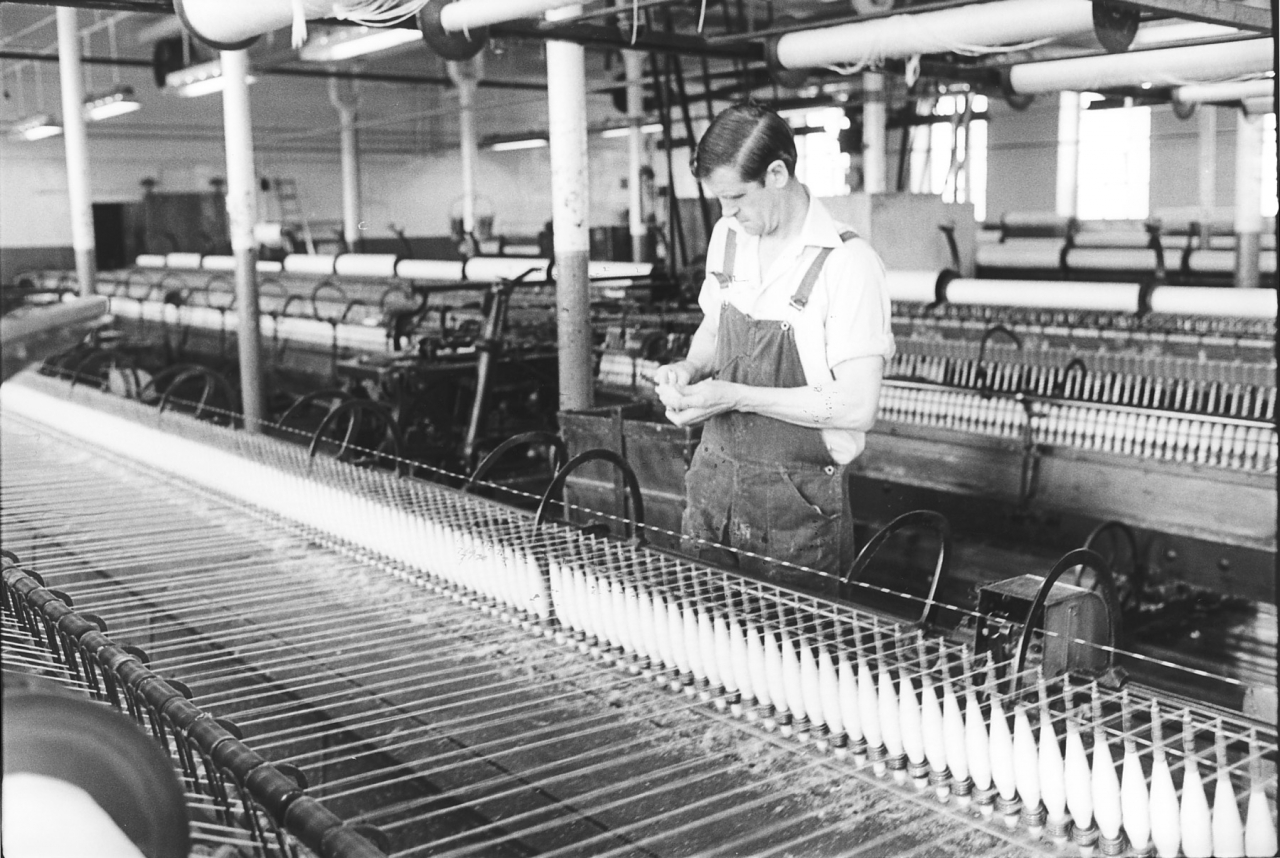
Sixty-six, that is when a mule has really got more or less out on the back; and it shows Jim. This is another bad fault ... when we were talking should have mentioned it really but didn’t do. When we were talking about doffing off and re-tubing, the end being wound on to the bare spindle. When it starts running back in again empty that end then is wound around the bottom of the tube .. right?
Yes.
R - Now Jim on this particular end has took the cop off to find the end on the cop. Before it runs back in, to piece it up again.
Because it's broken on the cop?
R - Because it's broken on the cop. Now really it is a bad thing although we all do it. Because that end has been broke at the bottom so therefore that tube is then free. You see, the end what were wound on at first helps to keep it there. Now when it's been broke, if it is an old tube, an old rubber, it can let it keep moving up and down. Now if it's moving up and down accidents happen. The mule's backing off and that cop can come up between them spindles, between the wires and stop it from backing off. When he's backing off, getting ready for running back up you see when it's done its twist. And that is a bad thing although we all to it at times, we have to do it.
So when you have to take a cop off you would say that was the spinner’s fault? A mistake when doffing that’s caused that?
R- No. You’re getting me wrong there. This mules been running for a while. It’s half way up the cop.
(900)
Now, for some reason, the end’s probably broke when the mule has been running in. So therefore it’s got on the cop and happen got lodged in between the winding you see. So the spinner will wet his finger and rub it up and down the cop to bring the end up. If this doesn’t work he has to take the cop off to find it. Odd times we can’t find the end so we have to take the cop off but it’s a bad policy.
(40 min)
So you were saying it was bad because it had to be taken off?
R- That’s right. By taking the cop off he broke the end at the bottom on the spindle which was helping to keep the cop in place.
Yes. And it will also mean that the package on that cop won’t be as big as the others.
R- Well it won’t be as big but it doesn’t show, not in the mule. Now in the other processes, winding frames and that, if the end is broken it does show quite a lot. In the cop it won’t show when it has had three or four draws, it doesn’t show to that extent. Now on your next picture, 67,
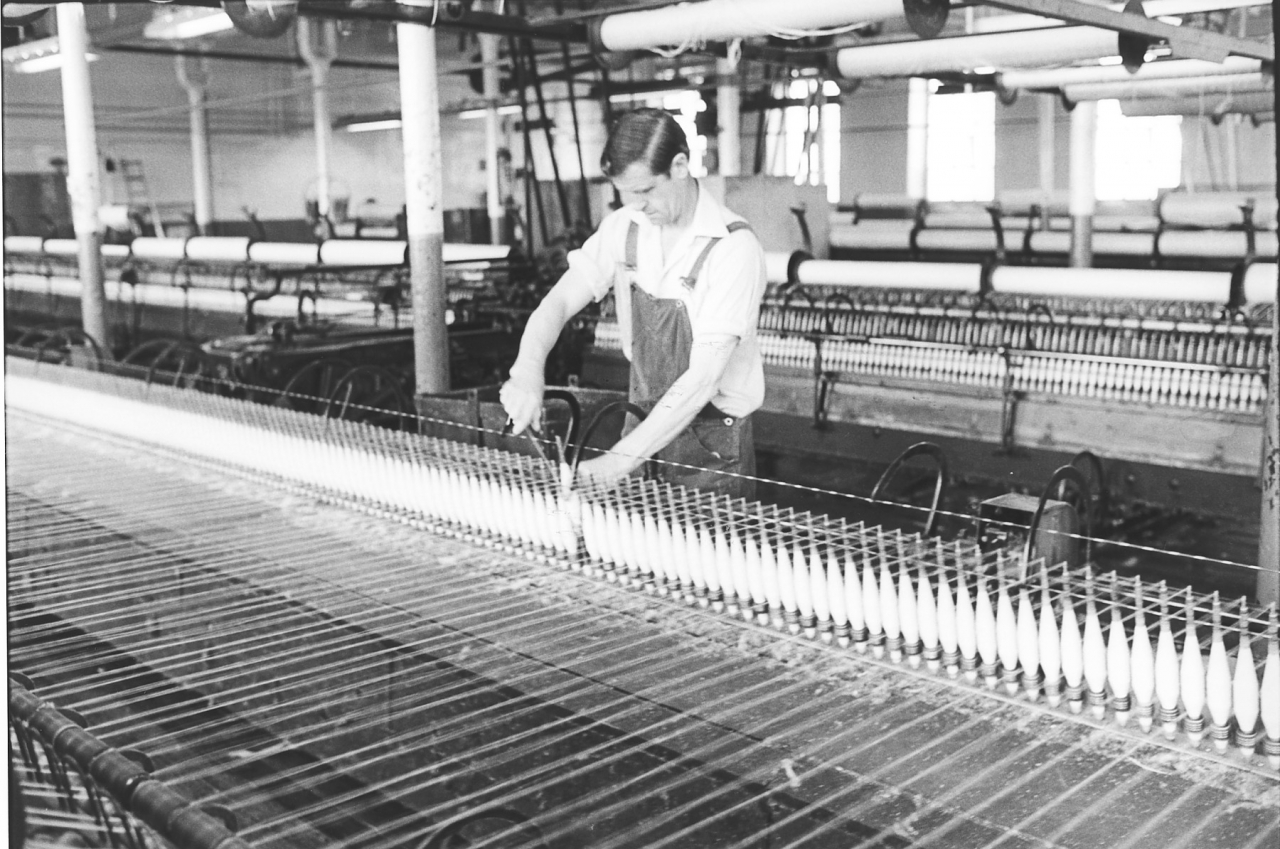
it shows where Jim has got the mule out on the back and it is the next process now where he has found the end on the tube and he’s putting the tube back on the spindle. Now I don’t know what these particular things are, but a little bit further up the mule you’ve got one end here with a bit of waste on it where it shouldn’t be. You’ve got another one where the end is broke and it’s also lapped on to the other end so that you’ve got two ends in one again which shouldn’t be. So that’ll have to be broken and then re-pulled off again.
So Jim’s not having a good time.
R- He’s not having a good time on that particular picture, no. He’s got two ends down, he’s got another here with waste on.
Unless that's underneath.
R - No it’s the waste end which keeps coming from the bobbin. It’s not from the mule, it’s from the bobbin is that and there’s a small lump coming through.
So not only is he having to put the cop back but he's also got to….
R - Well he’s got that end to pull back off after when the mule’s running and piece it up. He's also got, on the same bobbin again, another seven or eight ends further up, well, he’s got two ends running together.
Yes you can just see that in the bottom.
R - He's got to pull them back off and then re-piece them up individually. It shows him there like where he’s found the end on the tube and shoved that down.
On 68?
(950)
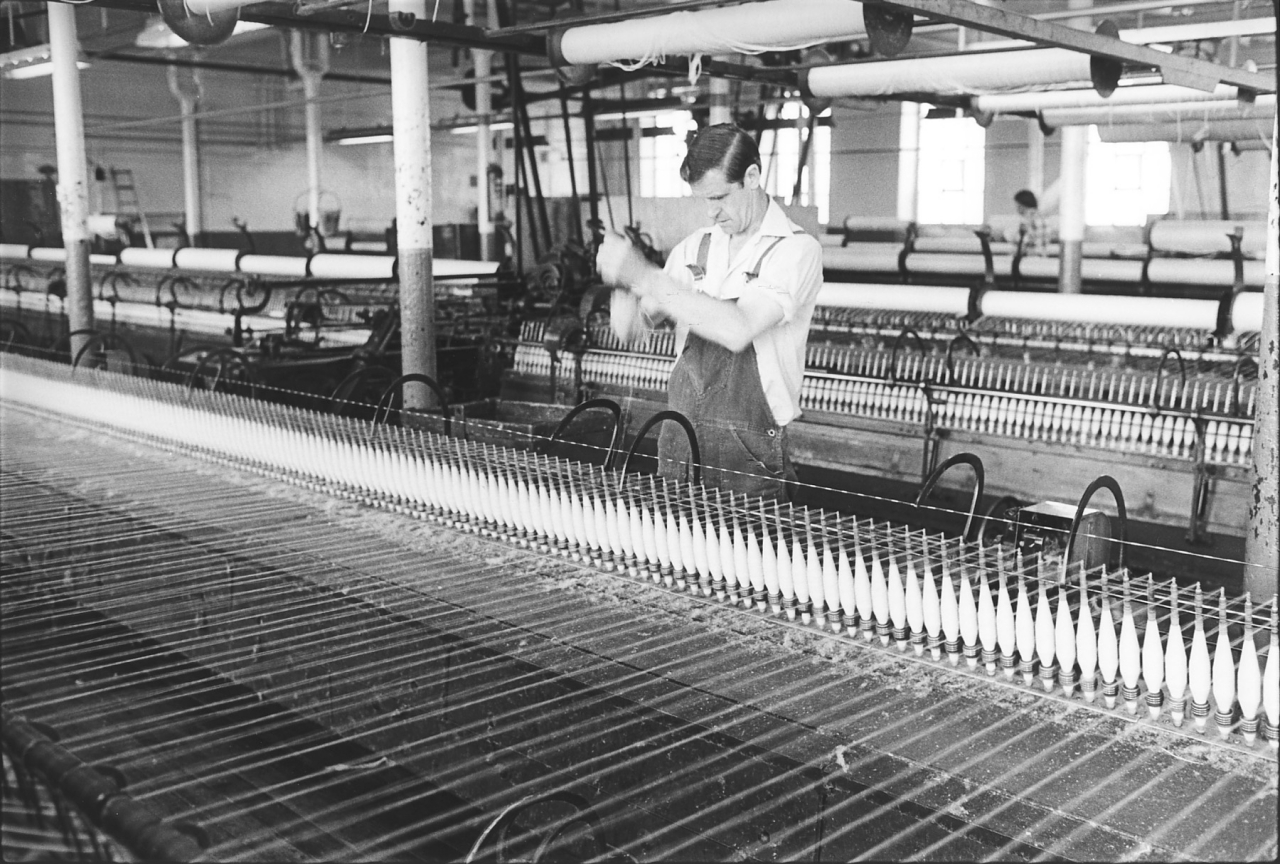
R - Yes sorry, picture 68. He’s pulling the waste off the cop now and getting ready for the mule when it backs off. Now when it backs off , starts rewinding hack on the spindle. He'll walk in with the mule and re-piece it up to the roller beam end. Right? That's on picture 69 is that one where he is piecing it up.
So on 68 he’s waited while…
R - Sixty-eight he's got the end up in the air more or less…
And he follows the mule in.
R - Waiting for the mule to back off and there he follows it back in till it gets back to the roller beam. When it gets back to the roller beam he'll then piece it back up to the end on the original bobbin. That is as far as that one goes. But there is one good point about it, I mean in this particular picture, although they have the lighting on, it does show you the actual lighting which is coming through the glass. I mean you don’t need the lighting on all the time because you've got plenty of light coming through to you.
Is the natural light better than electric light?
R - Well, the natural light is better in any shape or form than electric if it's possible, especially if you're working underneath it all the time. I mean, this lad here could tell you that, even though he hasn't worked in here long enough. But I mean when you are under electric lighting all the time sometimes it does get on your nerves compared to proper daylight. Now, what’s this, picture 70?
70.
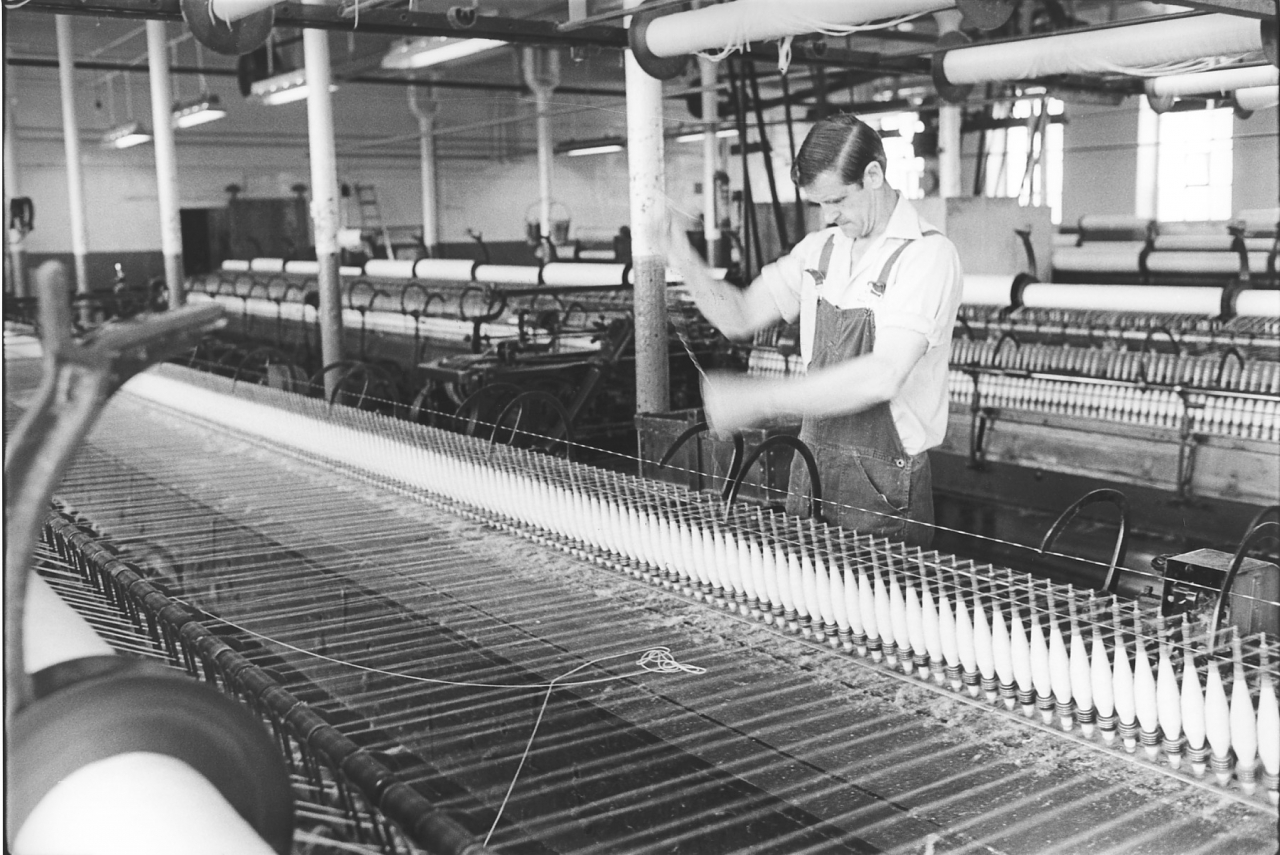
R - 70 is the next picture and the same thing again. I think it's the one where you had the double end which he is pulling back off the cop and getting ready for re-piecing up again. When the mule's finished it’s run out and run back in he'll re-piece them two ends up. That’s what that one is although there is only one end where there should have been two ends. But he must have catched one when it were running out.
And the thread on the bottom ... ?
R - The thread on the bottom is what's come from the bobbing underneath the leather roller just over the top of the two fluted rollers. And then the end just falls down to be pieced up to the spindle. The next one, picture sixty nine is exactly the same except in this way, it's just at the point where the ends have gone a little bit slacker, because the mule in on the point of backing off, you see? It's on the point of backing off, or ready for running up so that he can piece the end up again. I can’t see anything else in there cock.
(1000)
So, number 71?
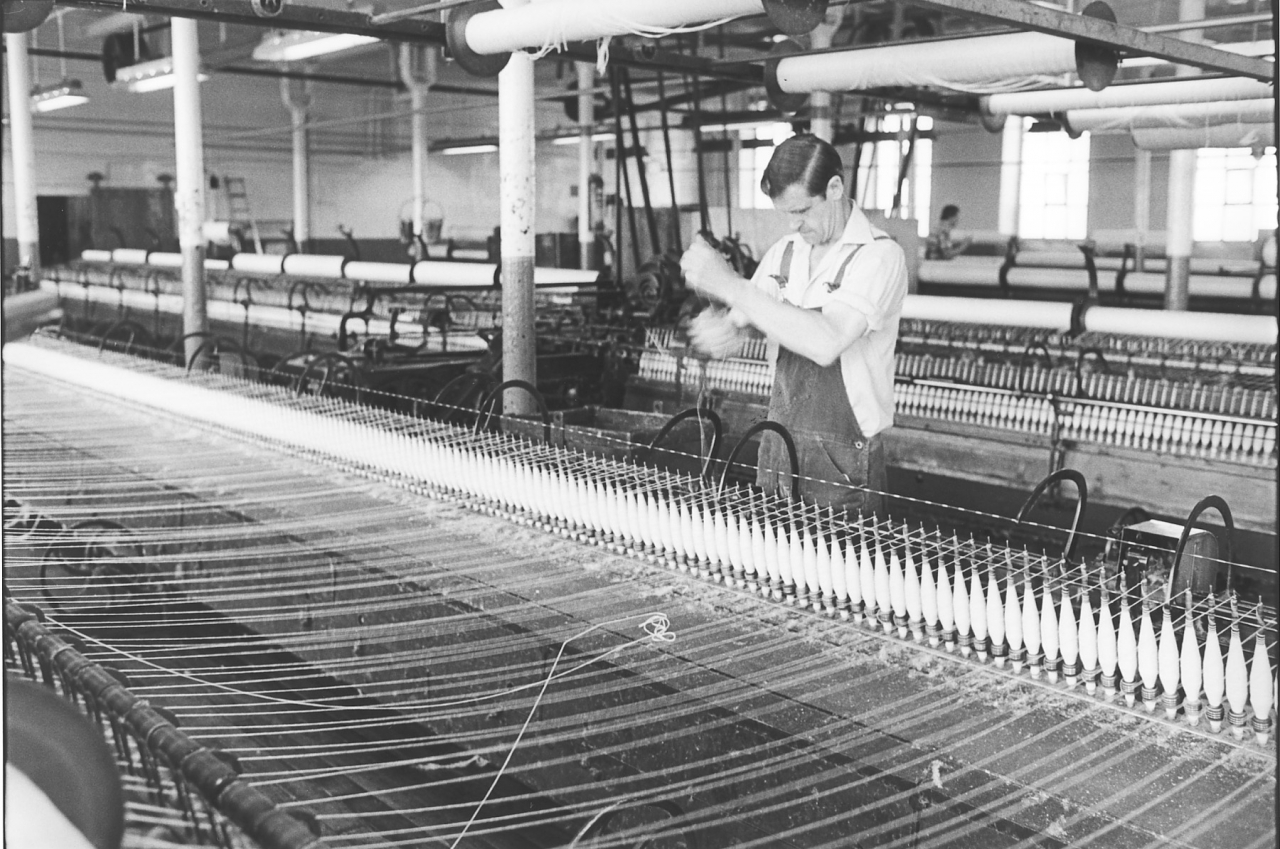
R - Right, picture number 71. It shows where Jim has put a tube on and through the end being broke down for so long he is winding a bit wore waste or thread or what you call it under the tube. Now with doing that it's already damaged the cop so that in the next doffing process that cop will have to be pulled out and put to one side so that it can be re-wound off on another machine that we have over at Grane Road. As I said, it shouldn’t be done.
But he is doing it to build it up?
R - He's done it to build it up, so that it keeps it [in step with the others] instead of the ends falling down on the floor and on to the boards and the wheels or anything else. He is keeping it straight in his wheelgate which is right in that respect.
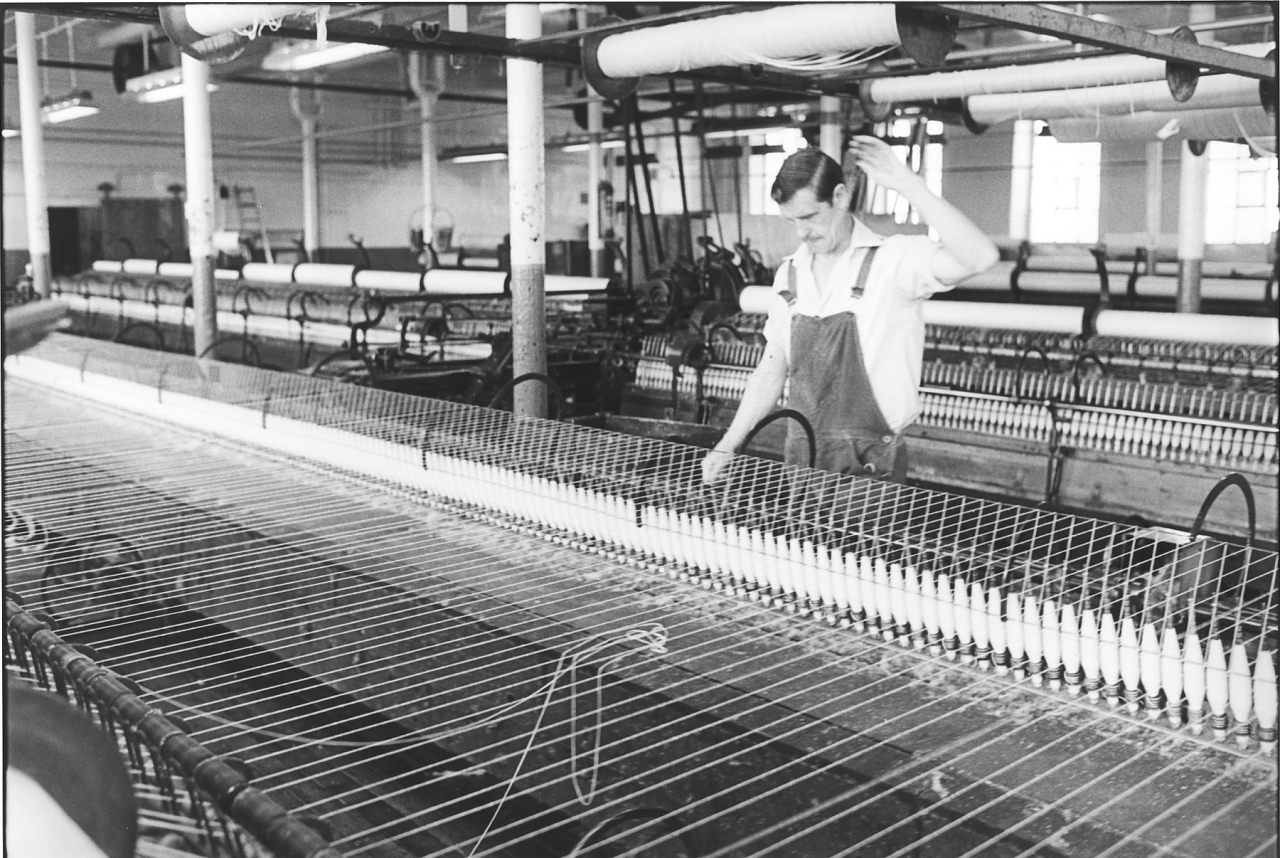
Picture 73 is more or less where the mule has backed off, he's got his band, his end up, ready for walking in with the mule to piece the end back up again, before it gets running out again.
You said he's got ... he’s got the end in left hand ...
R - The end is in his left hand and with his right hand he's guiding his own with his right hand and letting his left hand come down till the mule gets into the roller beam and there he'll piece it back up to the end which is coming from the bobbin.
And that’s the end that we see dropped down?
R- That’s the end that we can see dropped down. So that all that waste is not being left to dangle down there on the floor and tangle up.
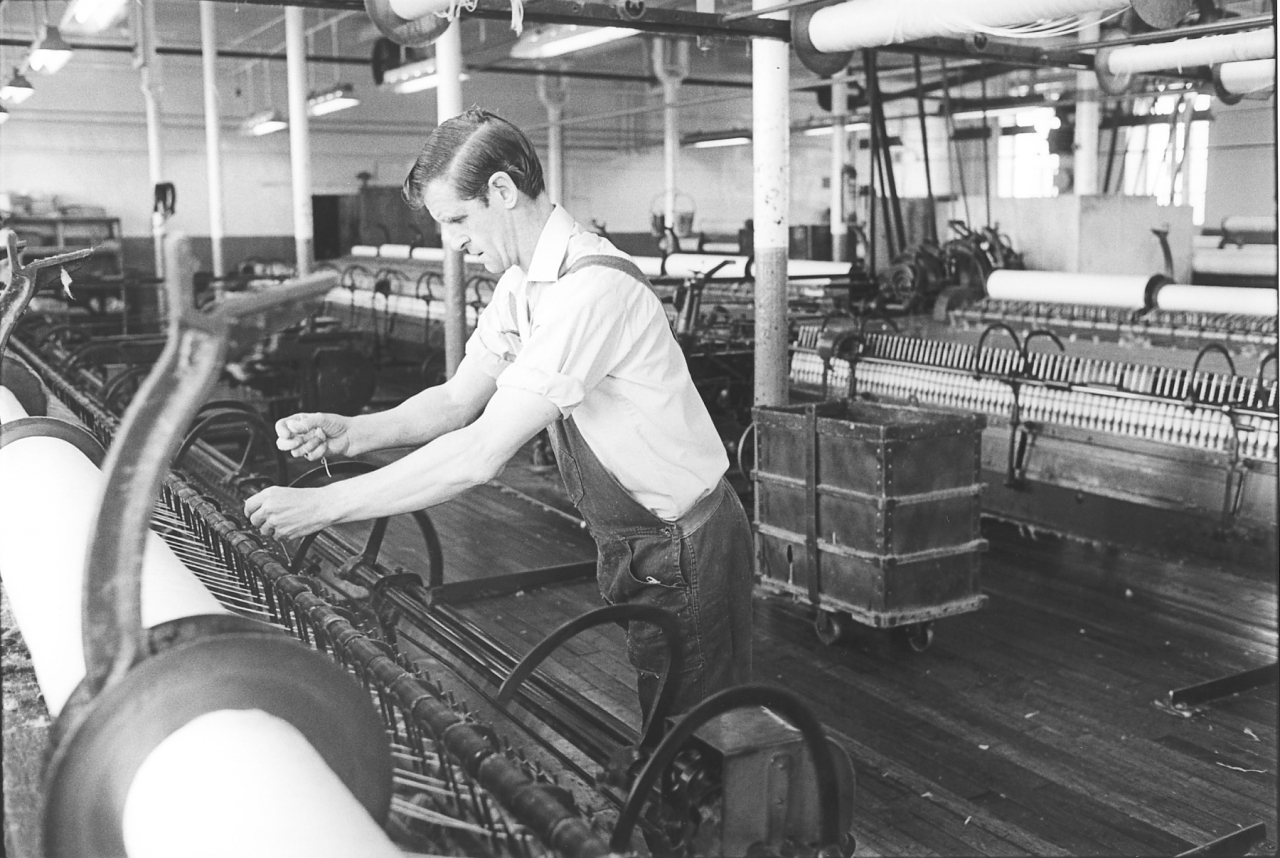
Seventy-four is the point where he is piecing, it shows Jim where he is getting over the end and he is piecing it up.
Hang on, he's got the waste in his right hand there.
R – No, he’s got the end off the cop, he’ll do that with his left hand. He’d hold the end off the bobbin in his right hand and there on seventy-five it shows where he is piecing the end from the spindle to the bobbin. And .. that is really, I mean that is one way it should be done.

Right.
SCG/21 June 2003
7,233 words.
LANCASHIRE TEXTILE PROJECT
TAPE 80/SHE/03
THIS TAPE HAS BEEN RECORDED ON THE 8th of APRIL 1980 IN THE WRAPPING ROOM AT SPRING VALE MILL, CHARLES LANE, HASLINGDEN. THE INFORMANT IS ARNOLD PARKINSON, MULE OVERLOOKER AND THE INTERVIEWER IS MARY HUNTER.
[SG note. Some parts of this transcript were virtually incoherent and I have had to edit very heavily to make sense. The principle I have followed is to preserve the sense and meaning rather than refine the original words. The message is that if you wish to make your own assessment of my accuracy you must go back to the original tape. Sorry if this sounds arbitrary but it was the only practical way to do the job.]
R - Is it right now?
Yes, we finished the last tape on 75 1 think didn't we?
R – That’s right, yes. Well you were on to 75 and we were saying there the basic thing of piecing up two ends together in that you pull the loose end, which is broke off the cop with your right hand, right? Now, with your right hand then you’ll reach over, your left hand will also reach out to get hold of your loose end, the soft roving which is coming from the bobbin. Your right hand then will go to your left hand. Now although it seems like it you don't actually twist, you just put your right hand to your left hand, and break the two ends of [level], and therefore those two ends together will automatically twist their selves, you don't twist them yourself.
Why will they automatically twist then?
R - Well because the spindle is revolving in itself with the spindle bands and the mule running out .. and as I say, once you've put, once your right hand has gone over and you’ve got hold of your loose end you're like, you are not pulling your soft end, you know a lot do, they are frightened and they are pulling back, that’s why they break then. But you don’t, if you just put your right hand over and just break your
(50)
your soft end off and you automatically just put it together and it spins it back in, the fibres gather theirselves up with the spindle turning all the time.
Which do you break off the loose bit with?
R - Well, the loose bit, it seems more complicated than what it is. You'll have your right hand up in the air, your left hand's down. When it gets to the roller beam and the mule's gone in, you automatically get hold of your slack, your soft end from your bobbin with your left hand, you just break that off and the other end will go to it then you see because you've already got hold of it.
Yes.
R- So I meant you just put the two ends together and automatically with the spinning of the spindle it'll piece itself up, although a lot try to spin it with the finger on top but in actual fact you don’t need to spin it at all, it already does it. But the idea is, really, to piece that end up as near to that roller beam at the front as possible. When you get your end from the cop you're reaching over and that is to try and get it from the spindle point to the roller beam, as near a possible.
So that it has the maximum twist.
R- So that it has the maximum twist in it. Not to piece up when the mule gets three quarter way out or on the back, and doing that is neither use to weaver nor the cloth what’s being finished you see because it's too soft. And you'll see it done, you'll see it done a lot in fact. I mean even a lot of overlookers including meself does the same thing many a time, instead of piecing up from the spindle point to the
(l00)
roller beam will get hold of the roller beam end first, the opposite way to what I’ve already said, with the left hand, fetch the soft stuff forward, break that off first and then take the spindle to that you see? It's the wrong way, it's the wrong way of doing I quite admit it but that's another way that you find. A lot of young uns that's just starting in the mule room does that to get a start you see? Once they’ve mastered that part the other comes quite easy.
On picture 75 is Jim doing it that way.
R – Jim’s doing it roughly in the right way but as I say he's gone over the soft end, so he's bringing the soft end to the spindle when it should be the other way about. And .. that's what I mean you see, you joint the piece up as near as possible to the roller beam. You should do that, that's the way to do it by rights, it's not to take the soft end to the spindle but take the spindle to the soft end.
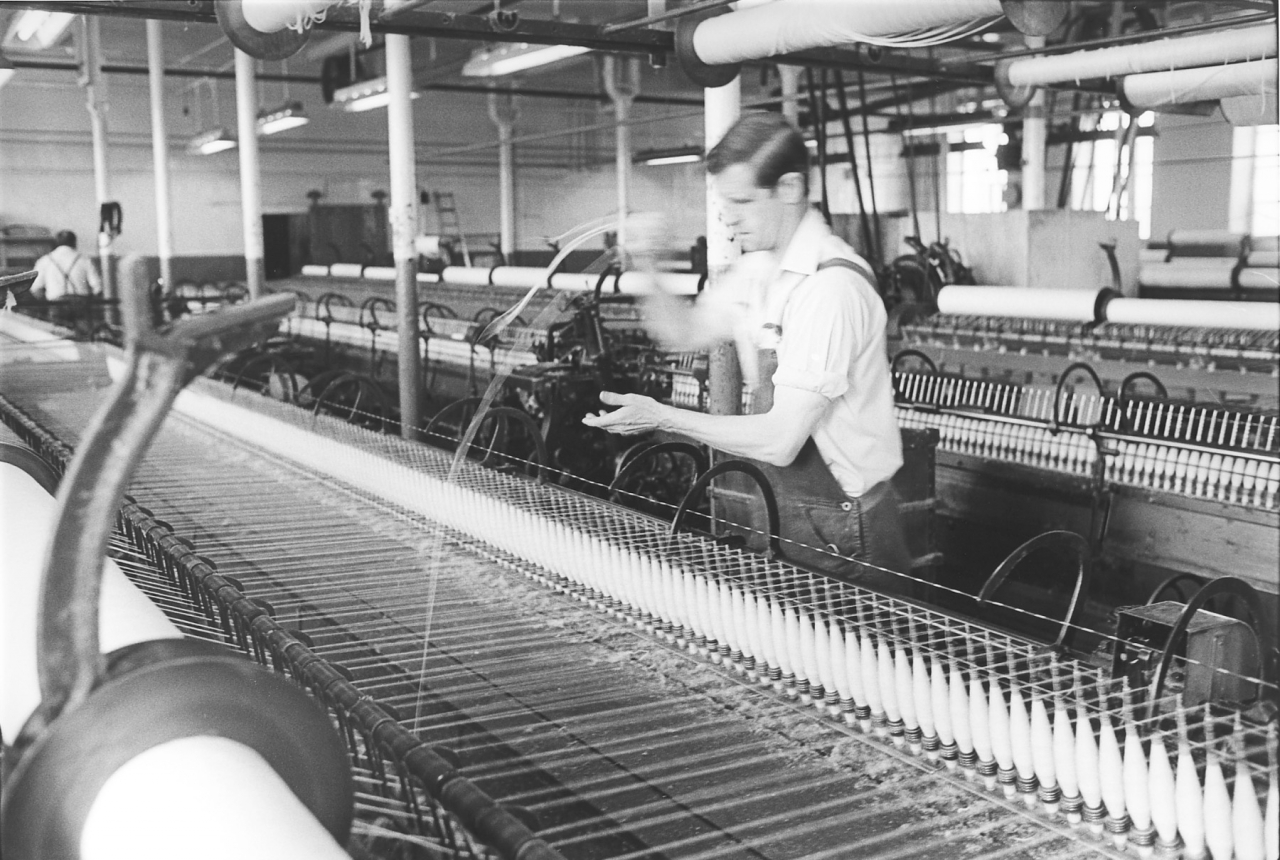
On picture 76 it shows you there now where he has pieced the ends up. Now he's gathering his waste,
(5 min)
he's picking his waste up. Now if he is not careful, by doing that, them ends is going to travel through on to the ends again. Instead of holding his hand down, getting hold of the ends and just opening them a bit with his fingers. Hooking the ends up but not stopping them from spinning you see, to gather his waste up. 'Cause that waste would be flying about even with a bit of draught, blown it over on to the other, so then if it’s blown it over on to the other it means he has to break it again and then start re-piecing it.
(150)
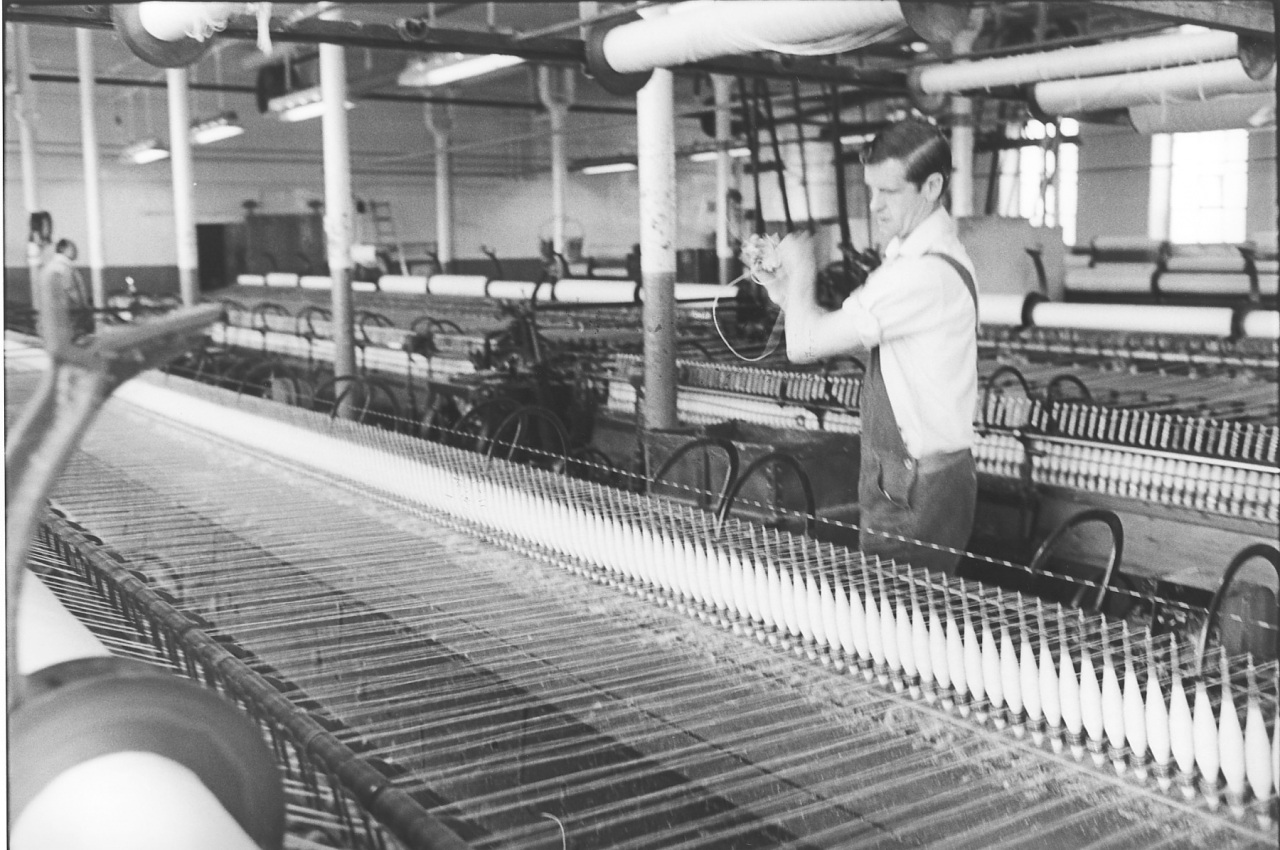
So then the other picture, number 77, that shows where he has managed to gather his, his waste up, and he's just rolling it round in his hand. Now the other side I don't know whether there was sommat went wrong there. Looks like all the ends is gathered. So in this picture he’s had some kind of a break down here, or ...
On the other mule?
R - On the other mule. Or else the mule has slipped from the back and they've all curled round on the top of the spindle and consequently all the ends is all gone slack, so there in something automatically gone wrong with the mule which is not their fault. We’re right on them two are we?
I think so.
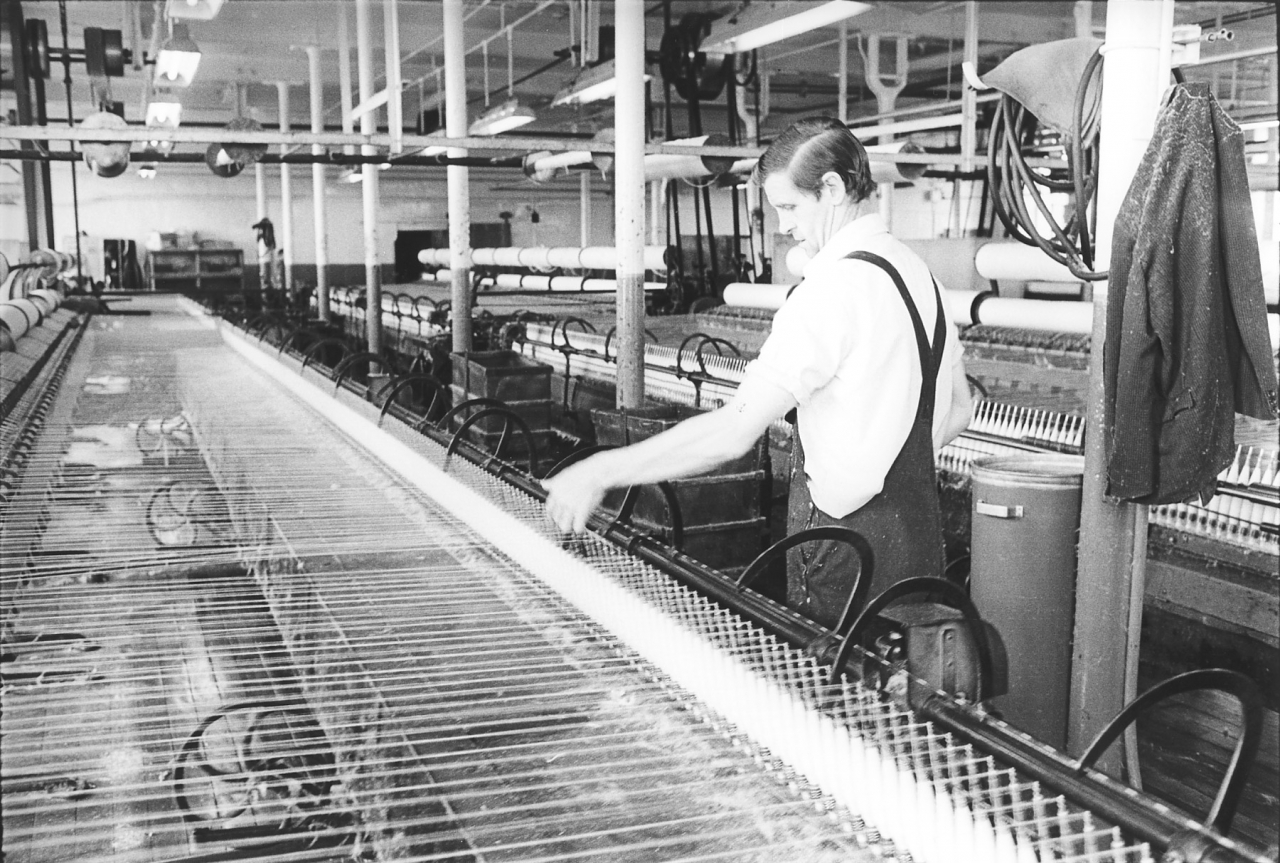
R - Seventy-eight is just an example sometimes, as spinners suggesting really, either that the mule is running out, that there is either more twist being put in or not enough with the consequence that Jim has to put his hands through the ends and lift them up you see. To see whether they're feeling a bit hard or they're feeling a bit on the soft side you know? I mean on that principle that's what he’s doing. That’s what he’s lifting the ends up for.
What could he do about it if it was?
R - Well he can do nothing. The only thing he can do, that’s report it to such as the overlooker or the manager, and to say that he thinks they are either too hard or they are too soft. Then that's up to the individual overlooker to either re-wrap them or check up for the strength and everything else, whether it wants twist in or it wants twist taking out.
(200)
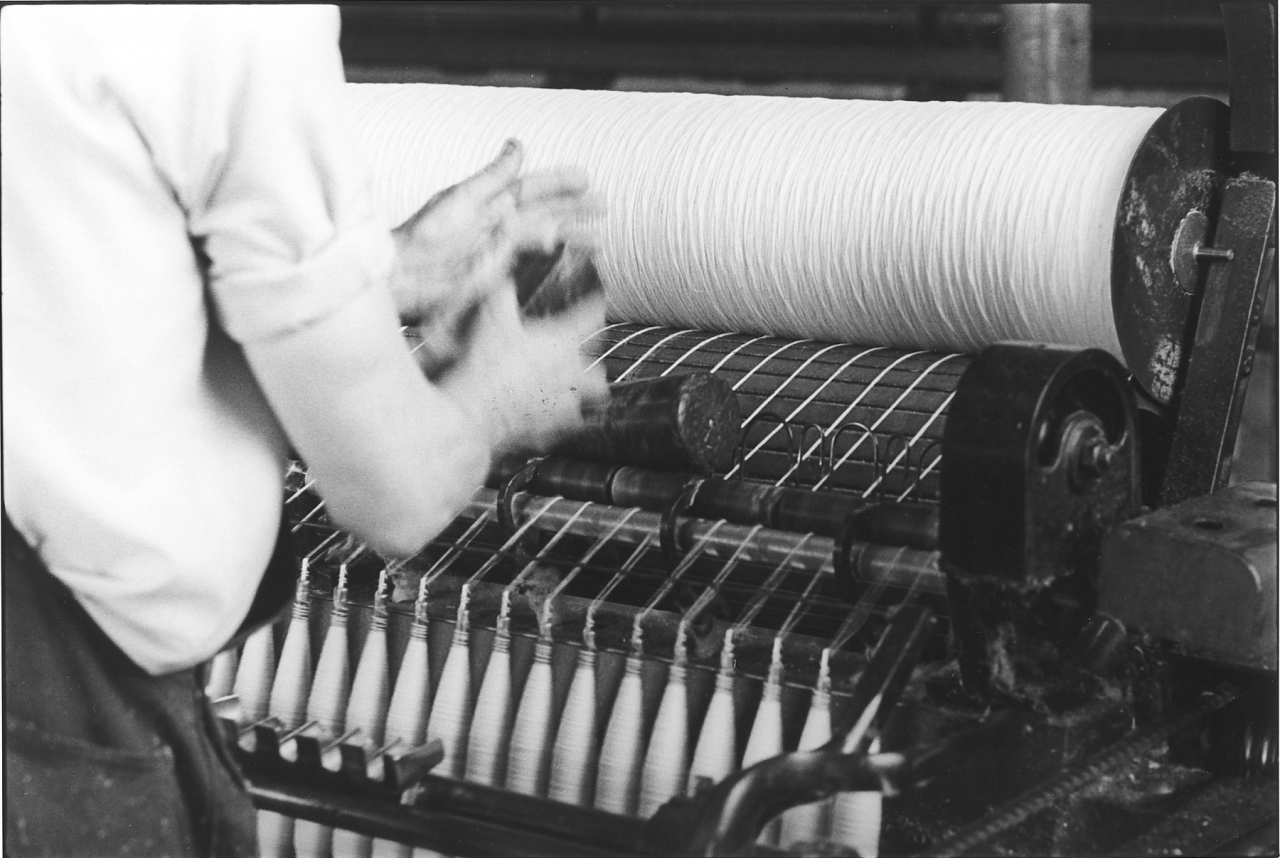
Now 79 is another reasonable picture as to what should go on with regards to keeping the leather rollers and that clean on the mule, where the ends come through underneath there in between the two fluted rollers and your leather rollers. The cleaner which runs along the top is being wiped off instead of just being turned round and being left as a lot of them do. He’s actually wiping the dirt off the bit of wool which is nailed to a small block of wood to travel backward and forward with it. The only function that has is to keep the leather rollers reasonably clean.
Do you have a name for that?
R - Well I mean there's no specific name, we just call then cleaners. There is no specific name for them. They’re a cleaner and that’s all they are for really and that's just for keeping the dirt, the bit of soap and that which is in the cotton do you know, from sticking to the leather roller and keeps all them clean. {I've heard some spinners call it the 'mouse'. SG]
It just travels along those…
R - It just goes half way across the mule to the headstock, then he turns it back round and it comes back again, that’s the only function about that one particular thing.
And if it wasn’t there, the rollers…
R- Well, if that cleaner weren't on at all, or there were no other kind of cleaner being used then the leather rollers would get that dirty as you'll see in one or two odd mules which don’t bother about the cleaner going backward and
(10 min)(250)
forward, or looking after them you'll see the leather roller's going to get all slippy with the grease and soap that’s come out of the cotton and the oil that gets on to the leather rollers. Well if he doesn’t keep them clean consequently you get a small film of dirt on the leather and on the ends running through although really with the naked eye you can’t actually see it but in fact the roller has just lifted up that little bit so by the fact of that leather roller just being lifted that little bit, the actual twisting is not being done from the spindle point to the leather roller and the fluted roller, it’s actually going underneath it.
Yes, I am with you.
R - Now that can cause some ends breaking unnecessarily what don't need to break. You see them fluted rollers are another, the front one is nearly always kept clean, the excess dirt what comes off the cotton and the cleaners goes mostly on to that back fluted roller. Now that back fluted roller should really be cleaned frequently. The spinner like individually cleans them happen five or ten minutes at morning or at dinner time, in their own time, keeping that back roller clean.
Yes.
R - That is really what they should do. Some spinners you'll see they don't even bother over ‘em. They are supposed to do what they call scouring every three months. That’s been a recognised thing in the trade all the time; and they normally stop like, depending on the length of the mule, between four hours, four and a half, five, it might even get up to six on individual lengths of mule you know. You have a time allowance that’s for taking all the bobbins out, all your leather rollers and everything off, giving them all a good cleaning and a good oiling. That should be done at least once every three months. But I mean through the process, like everything else, I mean, that gets ignored many a time in a lot of places including here, but more often than not they get cleaned more or less.
(300)
They really need to do it in this place because depending on the requirements of the stuff what we're wanting. But quite a lot of firms just ignore it and don't bother till it gets too late then they have to do something. But with all the dirt there is on that fluted roller at the back plus the dirt what's on your leather roller, you can't actually see it with a naked eye, but you can see it if you’re looking carefully, you'll see at the back of the leather roller the ends are actually twisting. And you get more breakages on your ends with that than you’ll do with anything.
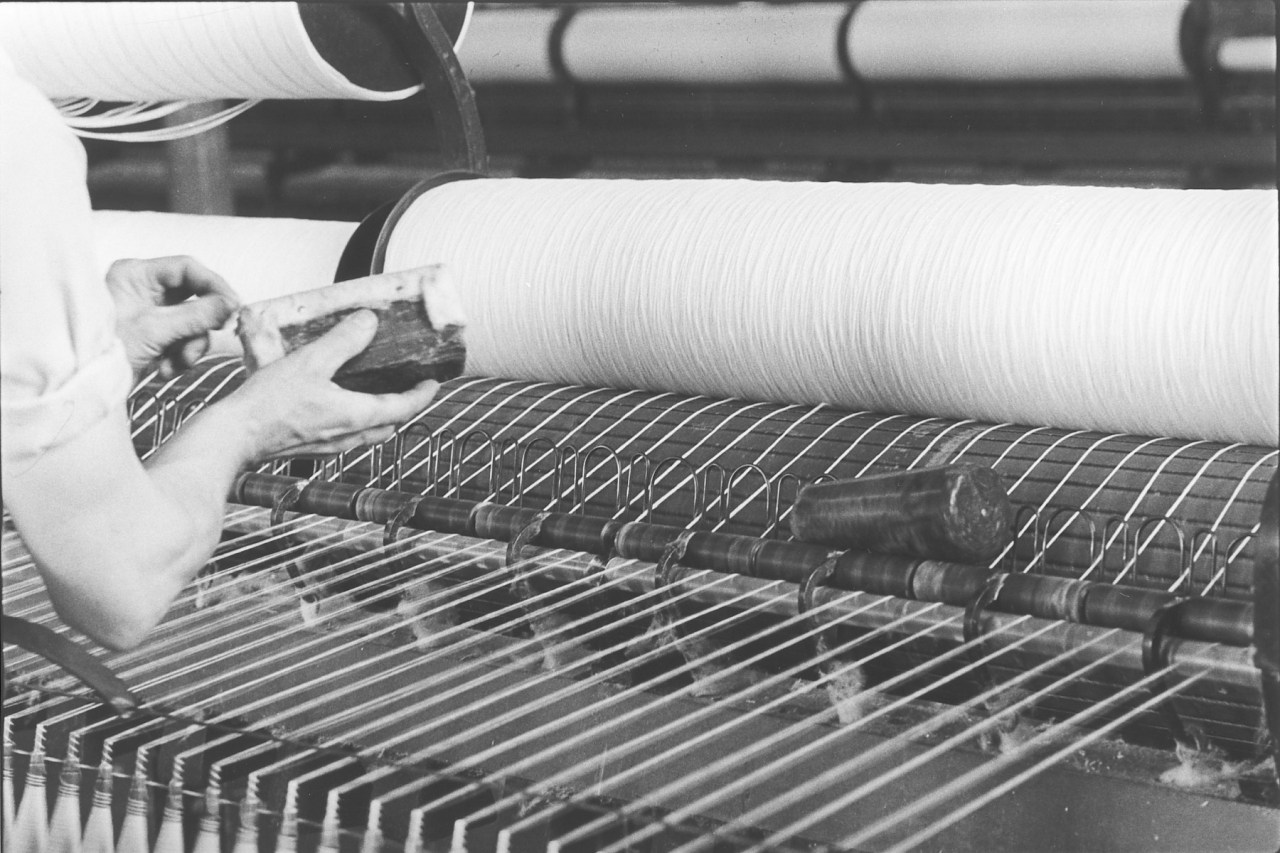
Now 80 is the same procedure, we can see the mule running out. Jim’s took his cleaner off, so as to keep his rollers clean and he's actually got the cleaner in his hand making sure he's got all the excess dirt and that off the cleaner before putting it back onto the leather rollers for it to start again.
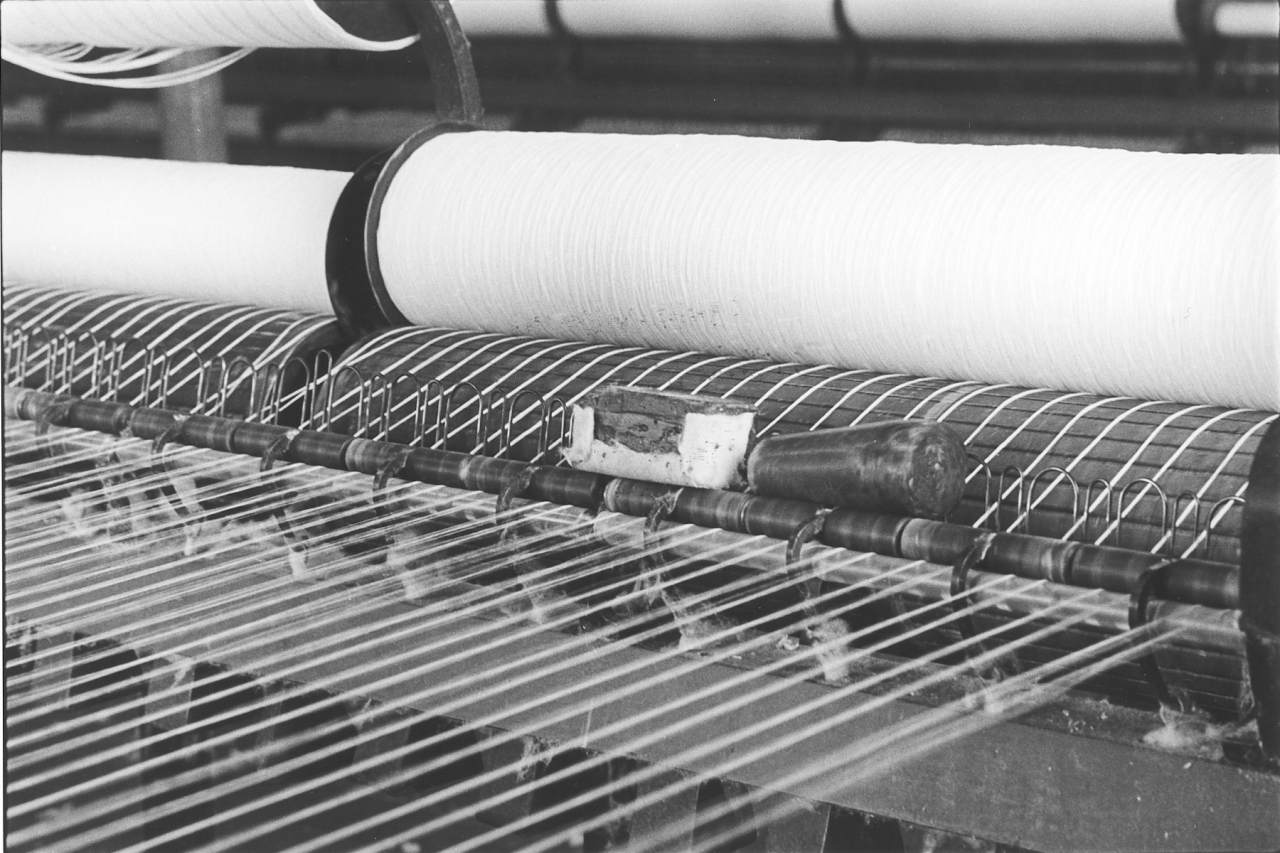
Your next picture to that is 81 which also shows the cleaner being pushed along with the other one, just one round block of wood being pushed along on top to another and it's only like a small wool, piece of cloth in that what’s on, but it just helps to keep the leathers and that clean and polished that little bit.
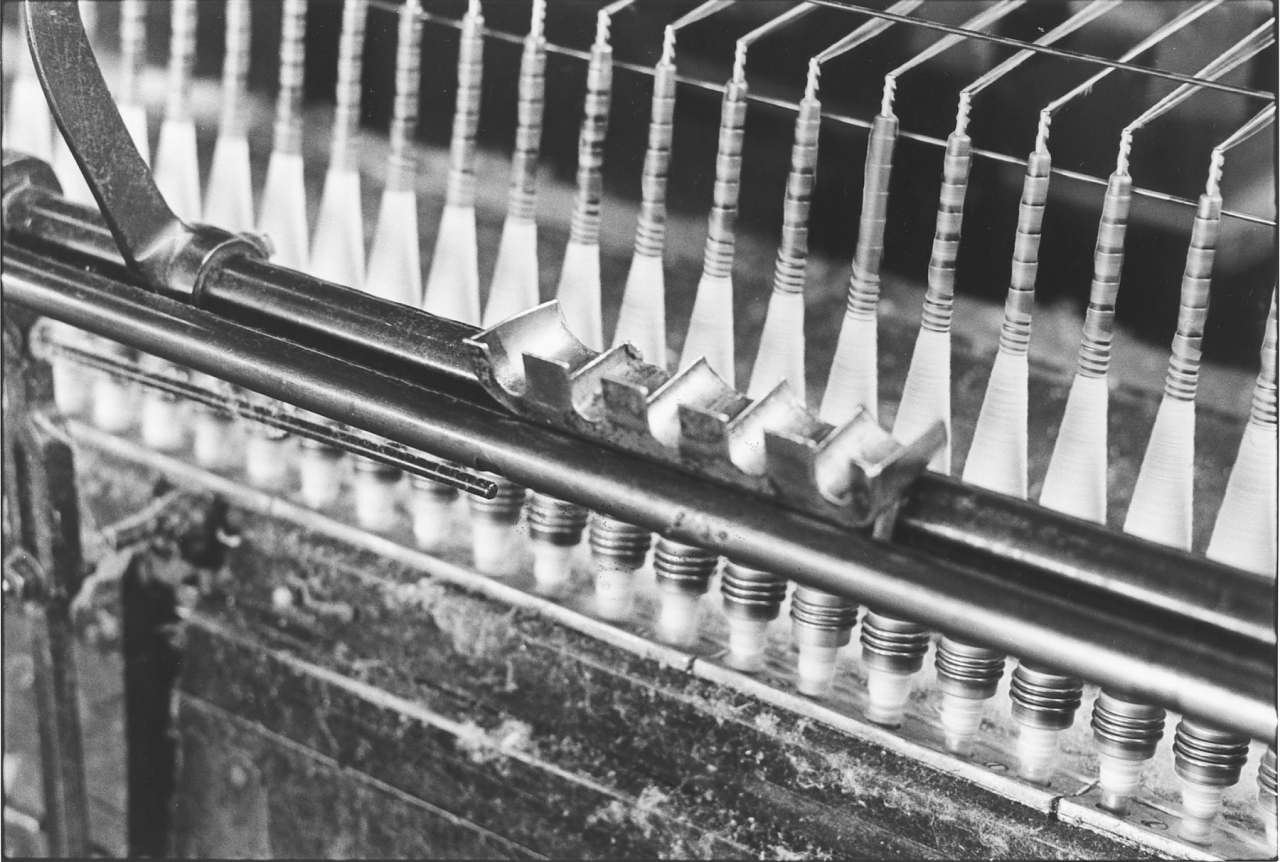
Now, number 82, well that just shows you the mule as it's run out and I presume it's near enough to the back with this picture and it just shows you the individual spindles, the ends on the top of the spindle before the mule's backed. The pressure which they have for pressing the tube and that down. It's quite a decent picture is that of the tubes and the ends on each individual spindle.
In that picture, am I right, it’s twisting at that moment?
R - It's twisting on the back yes. That’s when the biggest part of the twisting is done when it's on the back and as I say it's a good picture to show you that the ends get a reasonable tension all the
(15 min)(350)
way along when it gets on the back because that's when all the twisting mostly is being put in.
Does it twist when it stops at the back or when it's coming out again?
R - Well it's twisting all the time. When it's coming out it’s twisting but it does its majority of twisting when it gets here on the back we call it.
That’s right, yes.
R - But it is twisting all the way. It starts twisting from the time it leaves the roller beam does the mule. The condenser mule starts doing that as soon as it leaves the roller beam it is twisting is that. It twists it and drafts it at the same time.
And by draft you mean pull it out.
R - By drafting .. it's pulling it out as well as twisting it.
And when it goes back in it, it's winding it on.
R- When the mule’s going back in the folders is changed, your counterfolder is the one at the bottom, in reverse order. Like when the mule’s running out your counterfolder is at the bottom, your winding folder, guide wire as we call 'em like is at the top. Now when the mule has backed off the winding folder then goes to the bottom, your counterfolder comes back to the top so then the mule starts running in and the winding folder then is guiding the ends on to each individual cop.
Yes, I am with it now.
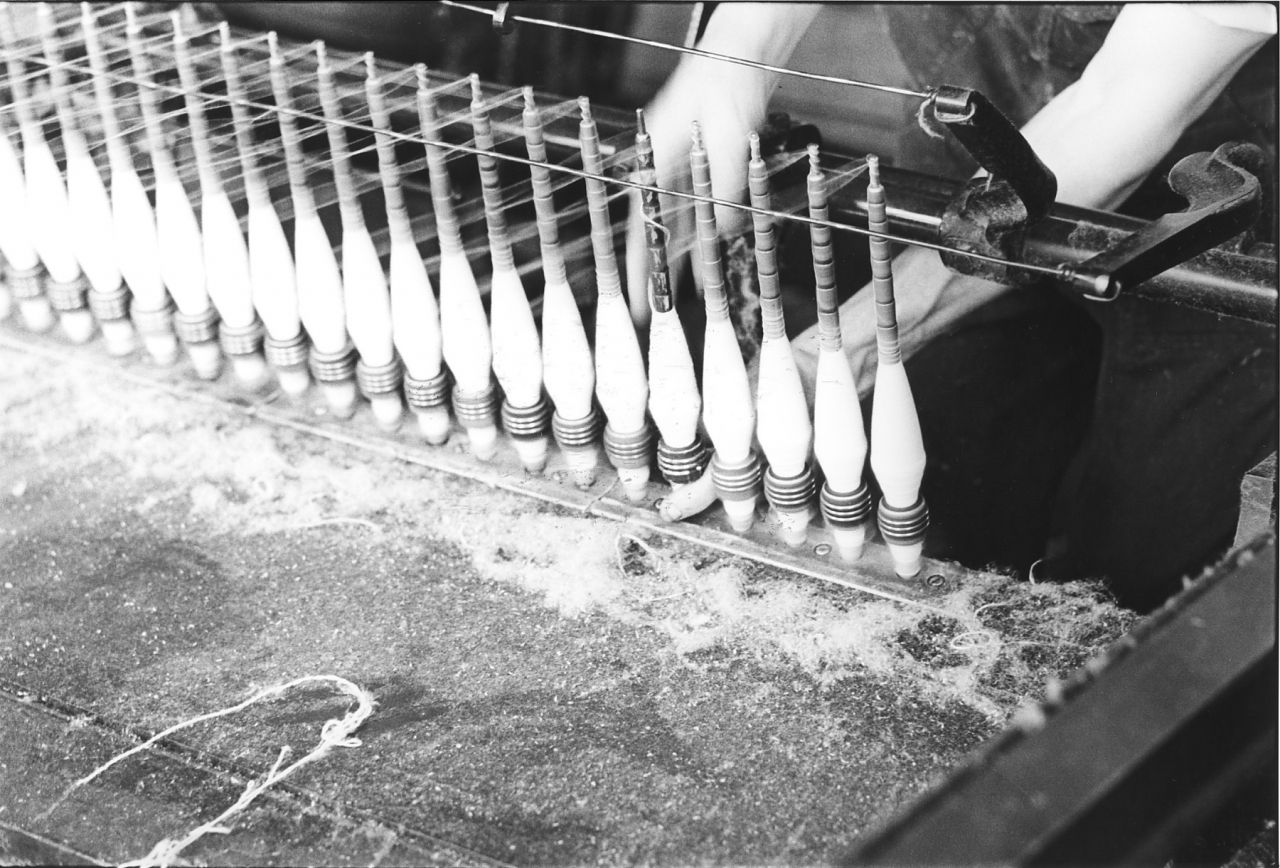
R - Eighty-three .. well that's a matter of showing you where Jim is pulling the end off the cop, off one cop end which is broke. That's really the only thing you can say about that, except that it shows you where he's got his fingers through the two cops to stop the spindle from revolving. And he’ll be holding the cop and the tube at the same time.
To find the end?
R – Yes to find the end so the end will lock on to the other you see, so you can just pull it straight up then. But it shows you in that one particular picture your counterfolder and your winding folder. You see, your winding folder is the top one when the mule's running out, your counterfolder, the one underneath when the mule’s running out. When it's running back in it's the other way about, the winding folder in at the bottom and the counterfolder is at the top.
(400)
Yes. You can also see on 83, and 82 you can see the thread on the bottom.
R - Yes I can see the thread underneath, yes. That is only when they are getting ready for doffing where all that thread is involved.
But presumably, every so often you’ve to take all that off.
R - Well roughly, depending on the count and that what you are spinning, they need to be took off at least once a week. If you go on to a bigger count, and when I say a bigger count I mean if you are going on to threes, fours, fives, such as that which we do as well as sevens and things like that. If you go on to a bigger count like threes or fours then obviously any time you doff that bit of waste on the bottom gets so much bigger, so you can only stand a limited amount on that otherwise your spindles will be stopping, your ends'll be running together, and so as I say the bigger your count the more times you want to take that off.
Can you just explain the counts to me? How the counts work out?
[What follows is incredibly confusing even to me, and I have spent a lot of time studying this. The basic problem is that Arnold is not answering the question that Mary asked. He is describing how they do checks on yarn in production in the wrapping room. I can’t begin to explain this but what I can do is give the answer to Mary’s original question as stated in the Cotton Year Book for 1919. I chose this at random out of the text books that I have on hand because it is clear, concise and authoritative. ‘Owing to the fact that some yarns are denser than others and also to the difficulty of measuring the diameters of threads, the count of yarn cannot express any direct or simple weight or measurement. What it does express is a relationship of length to weight. The units of length and weight involved are the hank (840 yards) and the pound (7,000 grains). Sometimes indeed the count of yarn is called the hank number because it expresses the number of hanks that go to make up one pound. It will be clear from the above that if we take the weight of a hank of yarn in grains and divide it into 7,000 we shall at once ascertain the count of the yarn. Further, if we take for convenience one-seventh of a hank, (called a lea = 120 yards) we shall only need to divide the weight in grains into 1,000 in order to ascertain the count.’ Note that this is for counts of cotton, a hank of worsted is reckoned at 560 yards. I hope this makes what follows slightly less opaque. SCG.]
R- Well the counts is there, just give us that board, on the… Well, the counts are these. Now then these are below fives, now these are what we call low counts, right? Now these are what we are meaning, you take them bits off there at least twice a week on them. Ones, one and a quarters, one and a half, one and three quarters, then you start going up to twos all the way through. Them’s your grains, them's what they should wrap at. Now when I’m talking about wrapping that's the wheel but she has a yard stick. Now when Irene is wrapping with this particular count she only has ten cops right? Before it only goes into five hundred because five hundred yards on this represents a pound.
Five hundred yards represents…
R - Roughly represents to a pound in weight, supposed to do. That’s one ounce as we call it. Now as I say she'd wrap ten cops if she were doing fours right? She'd get ten cops up to the wrapping room. She'd weigh then ten yards off six times, that's sixteen yards then .. right? She'd wrap them. Now if it were fours they should come out to a hundred and twenty five grains.
And a grain is .. ?
R - A grain? Well that's the weights that they put on to the scale you know, just small pieces they are. I mean they're all weighed out for that like. I mean is all of them. They’re fetched for us like that and they are all different little weights that they’ve been put on the scale for weighing. But them's roughly what the weights should be. Now, when you get above the fives and you start going on to your sevens and, well I mean we, we don’t get down to elevens or twelves or anything like that so often, eights is about the biggest thing what we do, although it sounds queer eights represent a hundred and twenty-five grains, the same an fours count, a hundred and twenty-five grains. But you see the difference there, you've only got ten cops at six yards ... right?
Yes.
R - In this particular one you've got .. but you can do any amount of cops providing you get a hundred and twenty yards. So any amount of cops whether you get, you can get two, you can get five, you can got twelve, you can get sixteen or you can go, you can even get into twenty, providing you can get a hundred and twenty yards that represents one lea. One lea. Now that one lea as we pronounce it like that, one lea is exactly like one part of an ounce. It's the eighth part of an ounce. You write leas to make up an ounce, so that's where your one thousand thing comes in so you divide whatever counts you want into that one thousand to give you the grains that you want.
It sounds awful complicated to me.
R - It does .. it might do but see .. put it this way then : a hundred and twenty-five, if you calculate it out going into that one thousand you’ll find out it roughly comes eight times.
Yes, I follow that.
R - Now then, that is the thing about it you see and providing you get a hundred and twenty yards when you are wrapping, and you get all of your cops, whatever you want, they’re the same, as long as you can get a hundred and twenty yards to divide into that, that hundred and twenty you can get what you want out then.
Right ...
R - That's all you need to remember, a hundred and twenty for below sevens, above sixes and fives, below fives, you only take half of five hundred grains. Because it's a very heavy thing you see, it's twice the weight what the others are. But really all your, all your grains, all your counts divide into a thousand, and that’s where you get your, that's where you get your grain. And that’s all there is to be said really about that.
How does this weighing machine work?
R - Well that’s not a weighing machine, that's what they call a wrapping wheel. All as they do with that, every time Irene used to take a wrap off the mule, she'd put a cop an each of them spindles. When she took the spindles she'd put it on to this wrap wheel, and she'd turn that handle at what’s called twenty turns with the handle from where it is now, she’d turn it round twenty times. Now that twenty is in actual fact when you've weighed it, when you’ve measured it out, it’s sixty yards because it does a turn and a half, every time it goes round it goes two and a half times round with the handle there to wheel all the way round. So if she take twenty she's actually getting sixty yards. Now when she's done that, she puts it on the strength machine here which hooks on to the top hook, the bottom hook, this is automatic, it runs itself.
(550)
Some of them have a wheel on, they turn by hand and it pulls a chain at the top so that, as you can see, the finger goes round telling you the strength of what each individual cop is.
Oh I see, yes. Very good.
R - There is supposed to be a limit but there in no specific limit to them really I mean you can’t because you might pull one cop off which is a bit thicker end, you might pull another two off which is that bit thinner you see.
Sorry about that deviation, but I thought I’d ask you.
R - Oh it's right. No, as I say, that’s just a wrapping wheel, that's just for getting her sixty before she puts it on here. That’s all that's for.
Now we’ve got a new series of photos on the headstock.
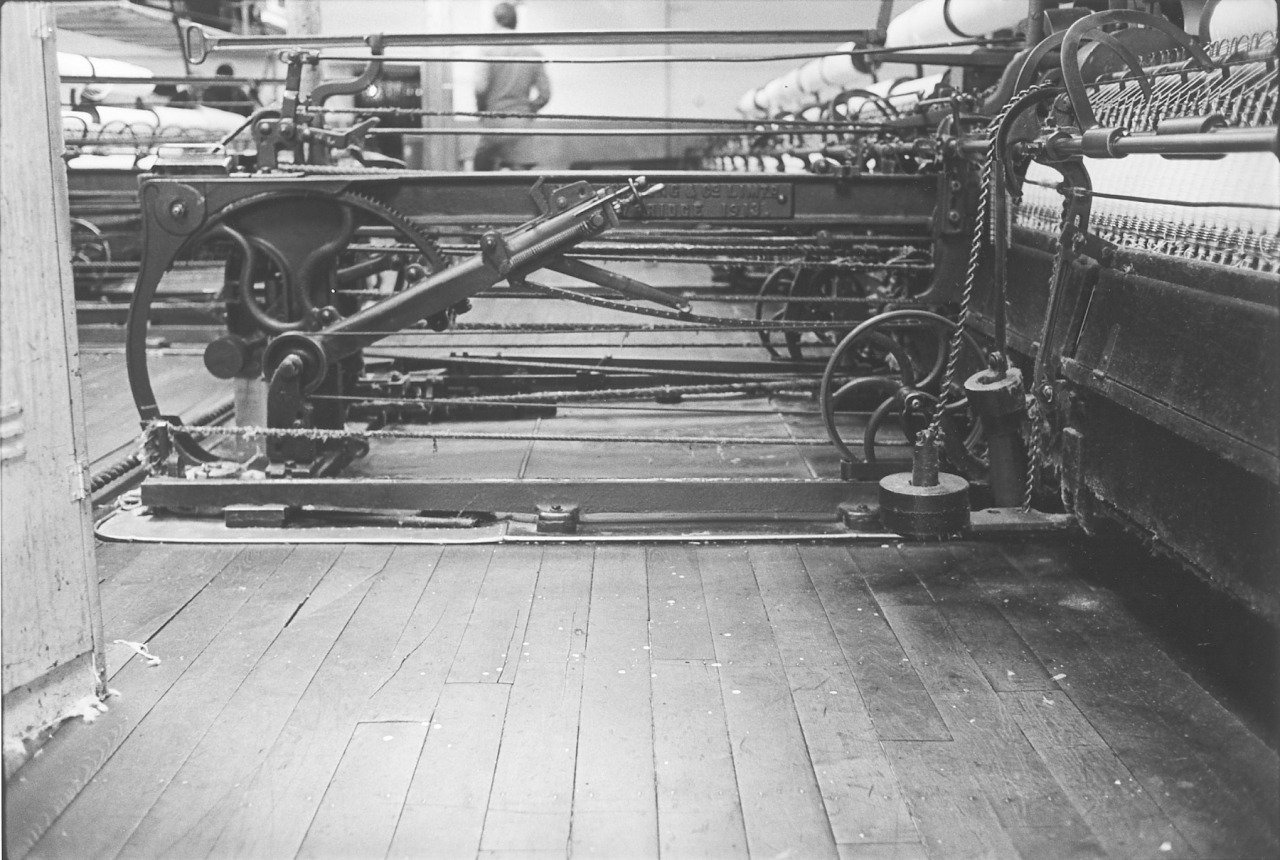
R – 84, yes well this is where the mule’s already in.
And if you can just on the following ones explain to us as well as you can
R - Well you’ve got your mule into the roller beam, it stopped in at the roller beam and as far as this front side is concerned you’ve got two weight levers which you can see quite clearly; one which we call a salmon head lever, that is the one with those two ten pound weights on and the counterfolder weight which in some cases we have just a weight on it without having a five pound on, to compensate for them. Now getting any one of these weights out of correspondence, we’ll say we had that chain there, the chain that comes from the folders down to the salmon head, if that one had to be pulled up that bit more tighter then this one'd be slack. So therefore, when you’re mule is running out your folder would be tipping up all the time, pulling the end off the cop all the time. That’s really all. Them are supposed to be in uniform with one another all the way through the mule. If you get one tight and one slack you'll get a variation and when your mule backs off .. that's providing you can get to the back without it jumping up .. you’ll see then because you’ll get a lot of ends that’s slack, you'll get some that's tight and that can be quite a bit of it with them. Now it shows you
(600)
the quadrant as we call it with a long chain fastened to it that is also fastened to a barrow wheel inside. Now that barrow wheel is the one which governs the amount of time as there is on that cop under the tubes. Whether it's on a tube, or whether it's on a Welsh hat, whether it’s on a paper tube or the bare spindle, that chain and the barrow wheel, plus the plate wheel governs the times on them, as well as the weights.
A quadrant is the diagonal bar?
R - The quadrant. That's right, the diagonal bar as you call it.
What is it?
R - That's what it is, it's only a circle cut in half and another what's called ... another small collar fixed on to it so that through but it works backwards and forwards , really that’s all it amounts to. But in actual fact as I say, it is to govern the tension which is on them cops. But whether they are on any tube or bare spindle or anything else, that's what that is for. You’ve also got a small nosing notion on it should be adjusted so that when the mule is running in or out there is a chain .. used to be fixed to the travelling rail at the other side here and it came round through a small eye hole at the bottom of the mule, back up to the nosing motion to work automatic. But like .. as spinners are, in their wisdom sometimes they move it up, they take it off. Like some cops it wouldn’t work, others it would work too fast on the mule and other times it wasn’t working. Well the idea of that particular notion is only for a particular reason, when your mule, your cops are getting tall on to the spindle or the tube or when it’s getting full. That nosing motion then should he starting coming into operation to push that chain that little bit more. Now when it pushes that chain it turns that barrow wheel that bit faster. Now with turning that barrow wheel and your plate wheel that bit faster so it makes then spindles revolve that bit faster and the cotton then is being pulled tighter at the nose, so as to keep a good nose on and that’s what the nosing motion is for, just to keep it tighter.
And the nose is the top of this…
R- The nose is the top end of your cop. Where your end starts coming off when it goes into the loom. Now eighty-five, now that is the same thing except in the reverse way. It does show you the builder rail.
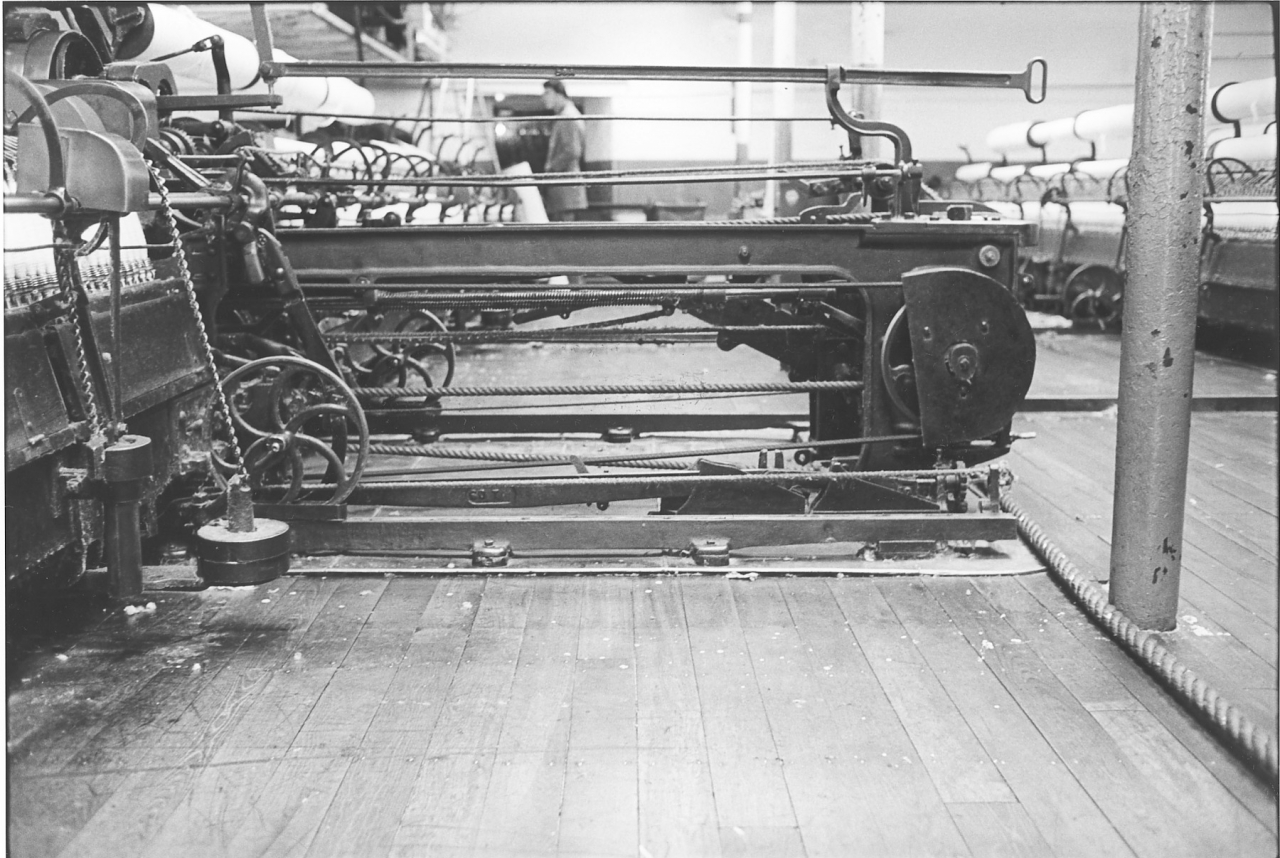
[85]
The what?
R - The builder rail. Now this rail as you can see it more or less underneath the rim band which turns all your spindles and that’s really all that is for. It turns the tin roller which goes right through the carriage, from one end to the other at both sides of the headstock. It turns that tin roller to turn your spindles. That’s governed at the back with three or four wheels which you can’t see in this picture. But just underneath that is where your builder rail is. Now that builder rail it works with a small chain coming through from the quadrant shaft here, which you can see at one side. You have a small shaft, and it runs through underneath. Now at the inside of there, more or less just down there, there is a small catch that’s fastened on to that shaft. And there’s four or five holes in it. It is just hooked on with a bit of wire and then a small chain comes from that back to a small builder wheel here. Now every time that mule runs out, that builder wheel turns to the required thing at that tooth. If you want two teeth it’ll go two, if you want three it’ll take it to that. We only take one tooth. Now as it turns that one tooth, your builder rail then does naturally move but drops your plates at the one that’s moving. You’ve one, two and one at the back which you can't see. They're moving out all the time, your builder rail itself is just moving down, it's not moving anywhere else it just goes straight up and straight down, but the function of doing that, the shape of the builder rail is what governs the shape of your cops.
(35 min)(700)
Oh I see.
R - Now if this one here, you can't really explain these like, on this line, because you can't really see them. But the middle plate of all, and the end plate are the two plates what do the shaping of the cop.
Yes.
R - The front plate really is only what they call a Locking Motion. That’s for the nose of the cop and where the cop starts. It's really all as it is for. But the shapes of each individual plate, if you take any notice of it, the middle one is flat, it looks more or less flat at the top but it is actually concave, that little bit round you know so that the plate in actual fact starts high, starts dropping that very little bit, and comes back up again to make the shape of the nose and the bottom of the tube straight away.
Yes I am with you.
R- There is nothing else really there. Oh there is a quadrant rope there or sommat, aye, he must have been putting a check band on.
I think they were, I think that rope, I don’t know what it was for, but I think they were stretching it weren't they? [85]
R- No, it's too thick you see? No, he’s been putting one of the thick ropes on which pulls the mule in and out. It’s the same weight of rope is that, that’s what that'll be.
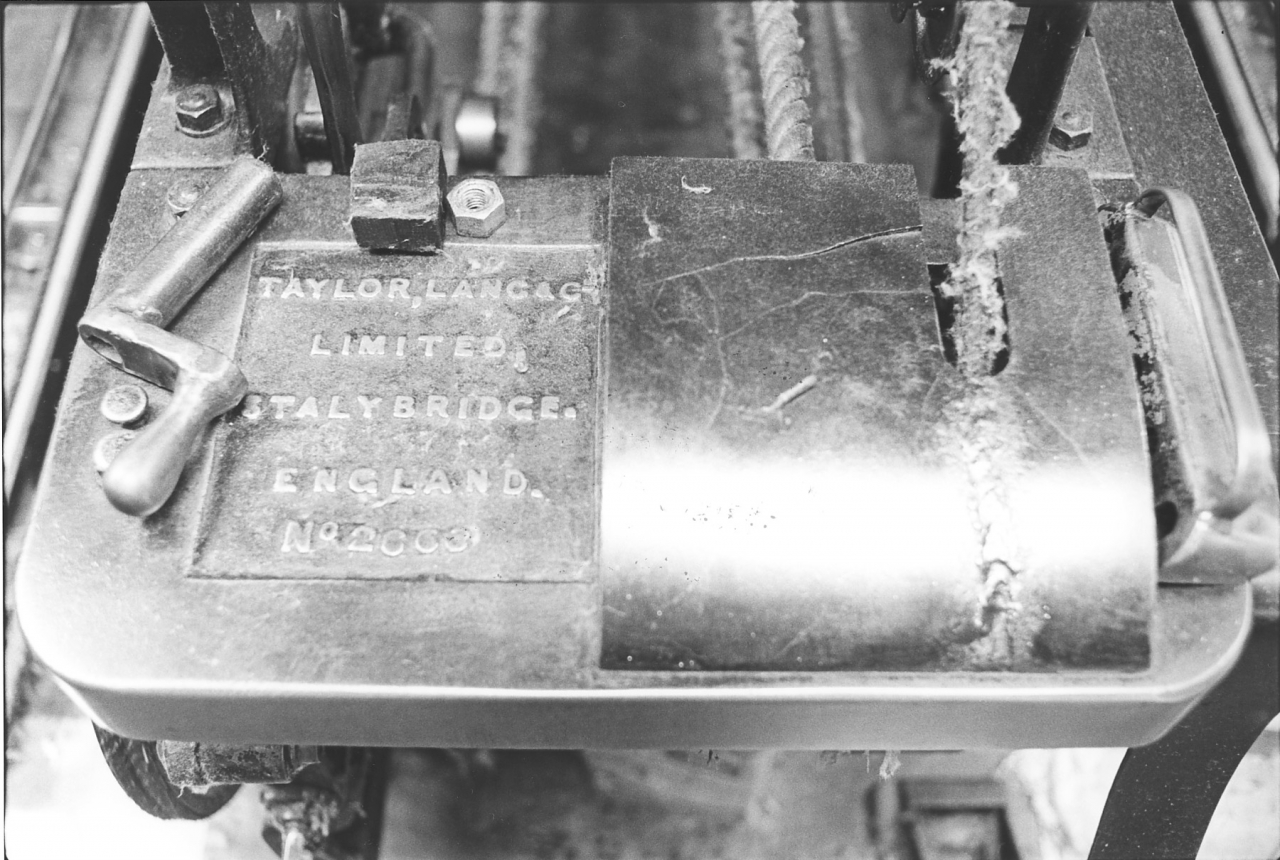
Now picture 86, that shows you the front of the mule, the plate that's on the top which tell you ‘Taylor Lang Limited. Stalybridge, England’ and .. well I can't really… What is that number?
Number 2,000?
R- Aye, that's when it were more or less made. That’d be the date.
You don’t know when that was?
R - Well I couldn’t tell you off hand. They’ve normally a plate at each side of the mule which tells you the date, but most of them were fetched out roughly about 1916, 1920. They started going out then. Well that were more or less when they were made. It shown you in the picture a small rope which goes through a guard which is over the top of the mule, the headstock, right in front. That thin rope is only a steadying band as we call it, for the back shaft, and that’s really all it is for, to help to steady the mule going in and coming out.
What's this?
(750)
R- The handle if that’s what you're meaning. Well that's for winding your rim band when they start first thing at morning. They can put that on the end of the rim band and either turn it round, you can either tighten it or slacken it. Same with the check band which is just underneath it, there is another small flat thing as comes out, they put it on there, they can either tighten that up or slacken it. And that's all the handle is for in there. That block of wood which you can see on the top, that is also the block which they put underneath the counterfolder when they're getting ready for doffing.
Yes.
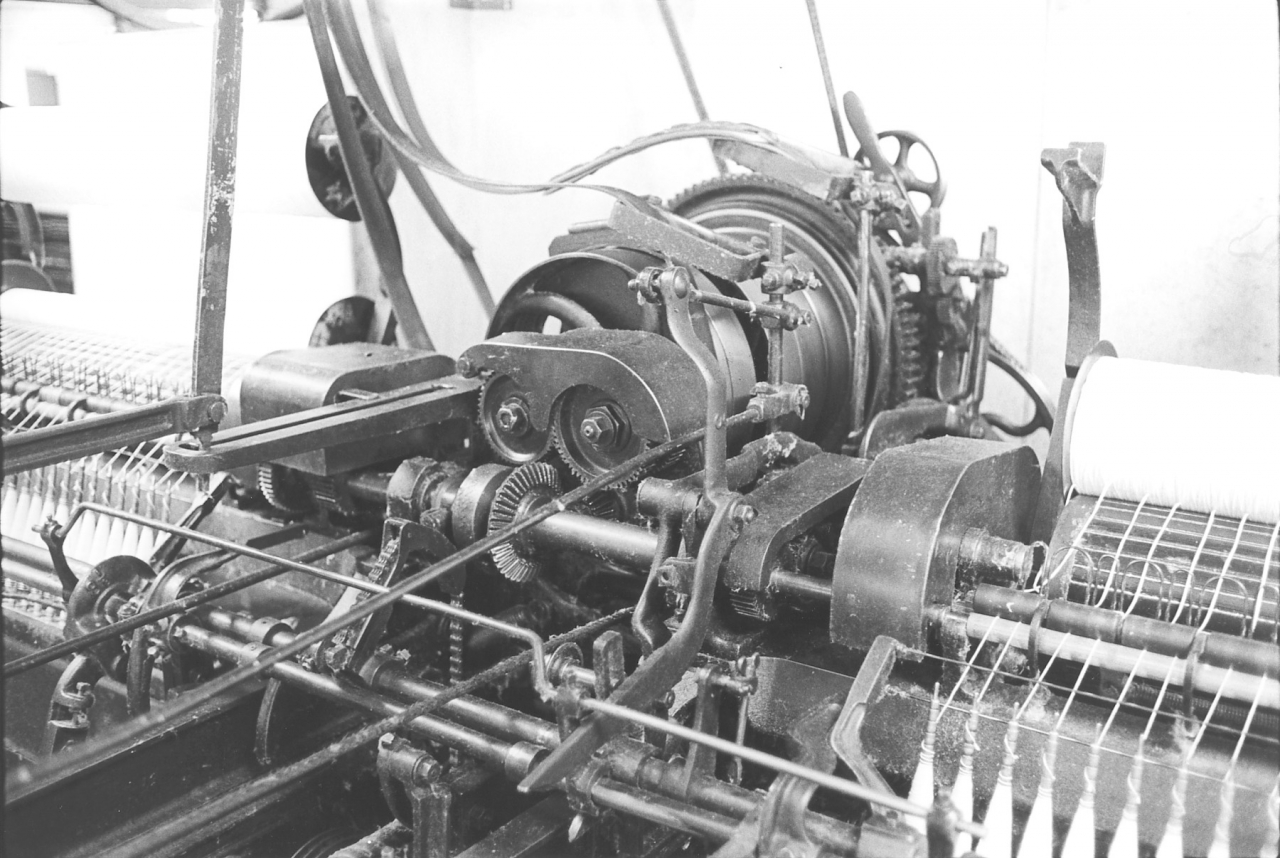
R - Now 87 is a good picture of the headstock at the front. It shows you the guards which ought to be on now for the insurances. These are over the bobbin drum wheels, for guarding the bobbin drums, they've one at either side. There is the other guard which is [over] your pinion wheels, them are the ones that govern your counts which comes from your bobbin to your spindle point. Underneath the guard at this side is a train of one, two, three, four wheels which is under the steel roller shaft, them's the ones that drive your
(40 min)
mule backwards and forwards that's under there. That is your bevel wheel for driving your different motions all the way through. This small bevel wheel here is for, is into another what we call a bell wheel inside there. That is fastened on to another flat wheel at the back of it which then drives these from the pinions, from your headstock. Them are also for driving your mule in and out. But they drive it all at different sections like, I mean they’re not all the same. The headstock pulleys, the two pulleys on the top, two narrow ones, unless you're looking carefully you might think they are all alike, but they are not. Them two, the first two of all which you can see is what we call the first speed pulley, there's one loose and one which you can turn but in actual fact it's a fast pulley with a small clip at the back which you can’t see here but there is a small clip inside there under the shaft. Now, when that mule sets off, that catch goes into that wheel and then it starts the mule in rotation while driving from these. Now it sounds complicated to you, I quite agree, but once that mule has gone roughly about sixteen inch, twenty inch, the strap which is on that narrow pulley then could be took off, if there's any need it could be took off and it wouldn’t make no difference to the mule, the mule would still run out
(800)
to the back because your other speed pulleys on the big rim takes over. Now as I say that’s your first speed, that’s your second speed which I mean again, has got a loose pulley in the middle, but you've got a two inch strap on, on your narrow pulleys and a three inch on your big one. Now the three inch strap has to go over like, pushing a small lever inside the front of the mule like same as down this side, pushing the fork over under the second (?) when your twist wheels revolve at a certain time. That then with this, this is the one should be done here, the twist motion I am talking about now, has two fingers on. When it gets down here that strap will be on the second speed. Now when that pin releases that arm, the first arm outside releases this fork for that fork to go straight over on to the third speed pulley; that is when all your twist is going in.
The third pulley is the one furthest away?
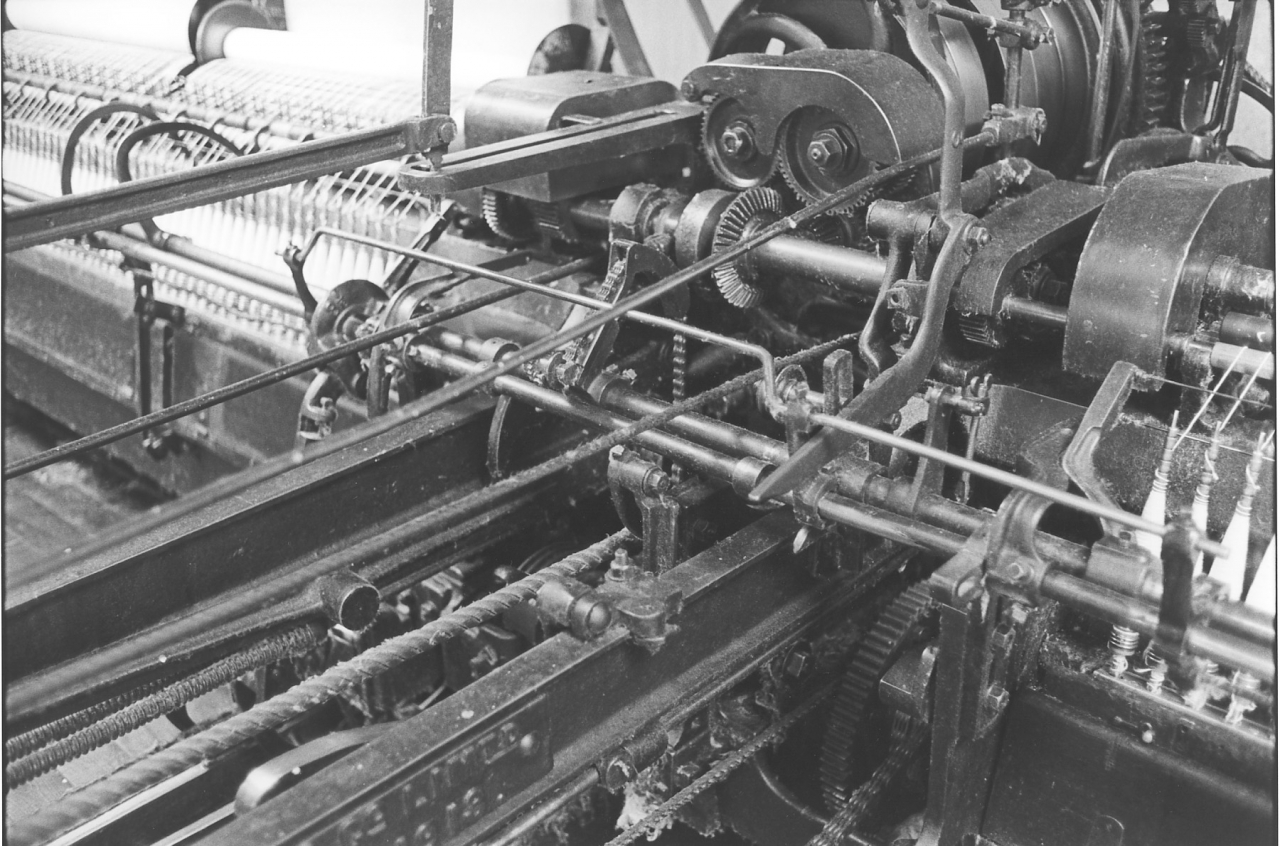
[88]
R- That’s right, the one furthest away. Now the mule then is near enough on the back. That's when near enough all your twisting need being done, all your ends and that are coming to the right tension and everything. But they're all governed with that particular small wheel, the twist wheel as we call ‘em, they're governed with them. You can either go bigger or you can go smaller but you're given that to the required counts as what you're wore likely to spend your time on. The wheels here we have the low counts with that from twos up to eights. Now [it’s] very seldom we go any more, if we did we’d have to change nearly all these round, it we had to go any different. But they can all be changed. Now 88, well that's the same kind of a picture at the front excepting .. when I were saying about your strap fork there coming over under your second speed you can see a small finger just underneath your folders, your counterfolders, that thing, you’ll see a small finger sticking down. Now as the mule runs out roughly about sixteen to twenty inches that finger then depresses that lever to fetch that fork over on to the second speed right?
(850)
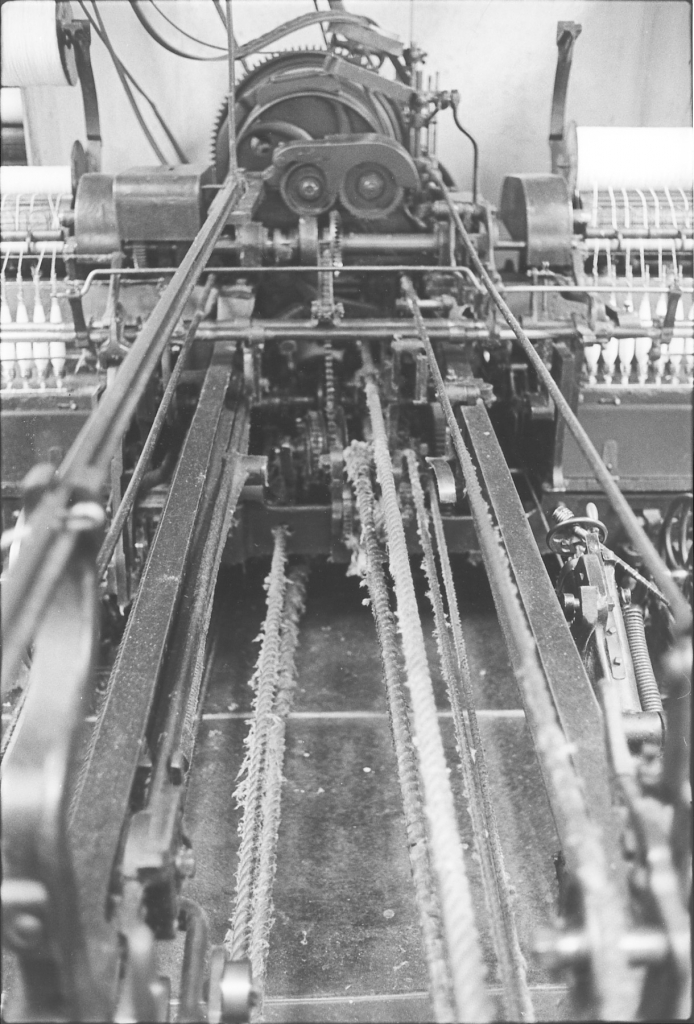
[89]
It looks like a band doesn't it?
R- Well, there is a band, that is a rope, that's for what you call the quadrant rope. You’ve two ropes there, you’ve that one, that's a seven eighth, that's on the quadrant. Now you’ve got the other thin rope which is just a steadying band from your back shaft. That's over the top. Well that small finger, when the mule is run out that small finger down there is loose, just free on itself but when it starts running out it’ll catch on to this lever here, this slide, and it'll start pushing that down. Now as it pushes that down it fetches that fork forward and it fetches it on to your second speed. Now at a given time that twist wheel turning that finger then shoves that fork out, lifts that fork up from here to let that strap fork go back right over on to the third speed. 89 is a good picture showing you the various ropes including the slide, your carriage rods and that for them, your quadrant as it is when it’s in. You’ve got a check band right down at the bottom that governs the speed of your mule running in so that when it gets into the roller beam it's not banging and breaking all your stop motion at the back. That’s all is required for to stop the mule from running in hard. You've got your quadrant rope again showing, plus your steadying band. These others underneath, they're in twos, that’s steadying and there is one which comes from the back shaft round back to the carriage. But your quadrant band is in two sections, you’ve got one long one at the top but one shorter underneath. But they're both on the same pulley which you can't see here. I can’t see anything else really in there for you. I mean the rods for driving your strap on and pulling then off, but you can't really see it in this.
Now, what’s 90?
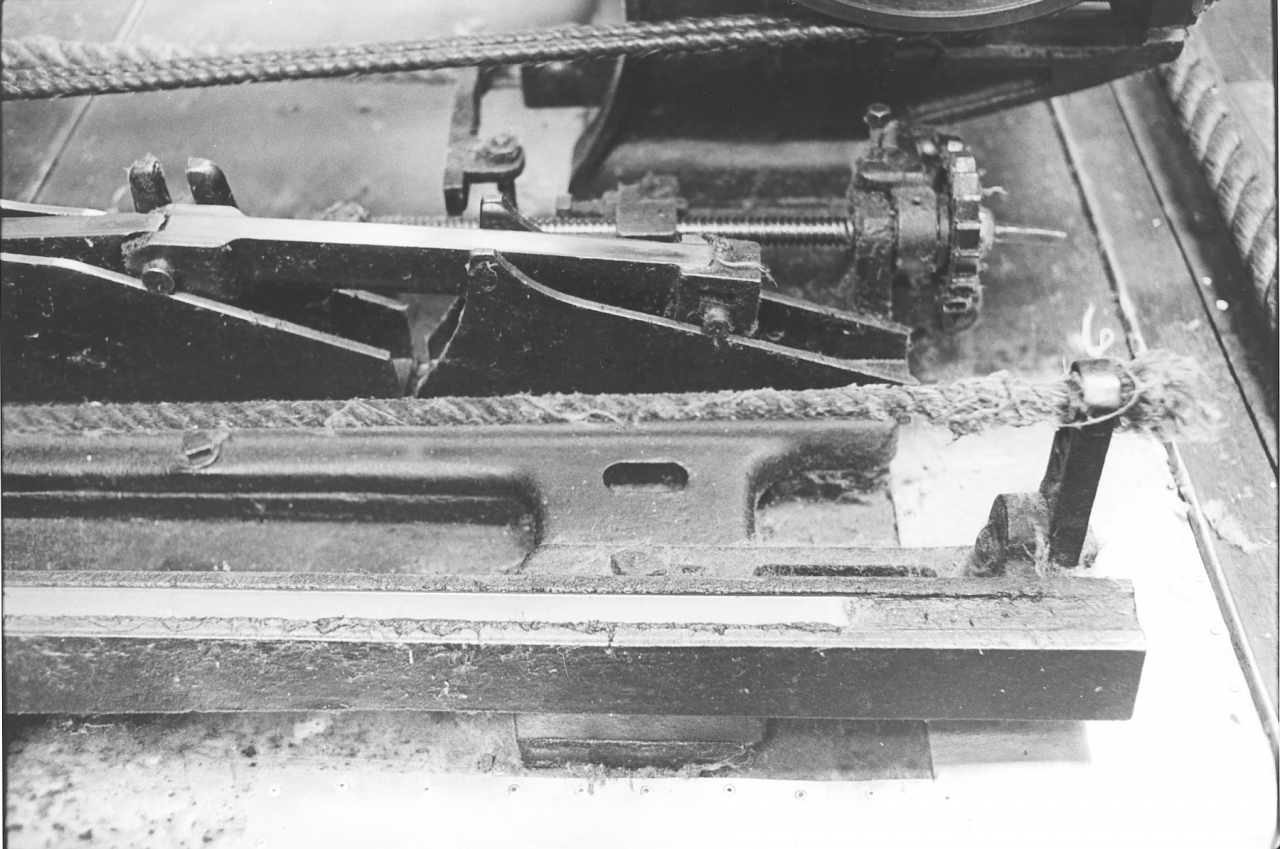
R- Well 90 shows you the front of your headstock. It shows you the builder wheel that we were talking about before with a small finger which turns as the mule is running out. That mule runs out and you can imagine your quadrant coming up. So as your quadrant's coming up the chain side is going back round. Well as it goes back so this wheel, this finger turns that little cog wheel that much and then lets it go back as your mule goes back in. It also shows you the builder plate and your plates which I were saying at the beginning, the shapes of them. As you can see it looks more or less flat but in actual fact it’s that little bit concave in and then up.
Yes, so that the builder plate is this shiny one?
R- Well all that is the builder plate, yes.
Yes. And on either side of the builder plate is…
R - There's two, there's two plates ... but they’re one plate is them. There’s only one plate there, and one at the back. It's just that this builder rail here is the one that builds the cops, the shape of the cops up or down. All as that does, that just slides up and down in those two levers there at that side. Now as I say, some people call that other things but that's all as it is for is to stop the builder rail from sliding out and falling over. It’s just there to hold that builder rail in so that it lets it drop.
SCG/22 June 2003
7,123 words.
LANCASHIRE TEXTILE PROJECT
TAPE 80/SHE/04
THIS TAPE HAS BEEN RECORDED ON THE 8th of APRIL 1980 IN THE WRAPPING ROOM AT SPRING VALE MILL, CHARLES LANE, HASLINGDEN. THE INFORMANT IS ARNOLD PARKINSON, MULE OVERLOOKER AND THE INTERVIEWER IS MARY HUNTER.
[SG note. Some parts of this transcript were virtually incoherent and I have had to edit very heavily to make sense. The principle I have followed is to preserve the sense and meaning rather than refine the original words. The message is that if you wish to make your own assessment of my accuracy you must go back to the original tape. Sorry if this sounds arbitrary but it was the only practical way to do the job.]
Right I think we were talking about ...
R - On the front of the headstock, the builder rail and the plates on number 88.
On number 90. Right.
R - And as I was saying there is just one thing on this where you can see a rope which is fastened on to the rails where the carriage runs backwards and forwards on these wheels, there is a rope and it goes underneath the carriage itself and it is just a steadying rope really to keep the carriage in line and straight from the headstock to the bask, to the outside of the mule. There is two ropes on at one side, there's two ropes on at the other side, they are just steadying ropes to keep the carriage square. Apart from that there is nothing else on there. Number 91 shows you exactly the same, excepting on this one it does give you a good picture of the rim band and
(50)
your builder plates again, plus on this particular picture .. that particular finger there, which you can see
On the left?
R - On the left hand-side at the inside of the builder plate you’ll see a small finger. Well that finger is also what we call the monkey chain which in inside the carriage. It is, it catches on to a small lever which tightens the chain up that little bit and when the mule gets to the back and backs off it keeps the noses that little bit more tight, there you see? Also underneath there is a small locking nut where there should be a chain coming along from there to the front of the headstock back to a small eye hole underneath, back up to the quadrant. So that all the time that that builder rail ...well not builder rail I shouldn't say that here .. but the builder plates are moving back so as that chain is also being moved back and governing the nosing action to come down.
(l00)
Right. You mentioned something else. It is a good one of the what did you say?
R - The builder plates and the shapes of them with the rail.
Did you mean rim plate?
R – No, the rim band.
Oh, which is the rim band?
R – The rim band is the one where it looks like there is two ropes but in fact there is only one, because they run all the way round you see. There is only one rim band on, roughly they're running out to about 78 yards in lengthy but the way we reckon them when we are putting [a new one] on we start off with… If there is no rim band there at first and we have had to put a new one on we’d start off from the outside when we’d thread that. The pulleys that it runs on, are in two grooves in this one pulley you know? So we start off with the outside groove, when we’ve got to the back we go to the inside groove. Now as we threaded that round we come to the back where all the wheels are, and the rope then will come out and looking like it had been put into a figure eight. But it’d be in the inside but when we took it back through underneath the carriage and back to the front again, fetch it back round from the front to come back again it’d come from the inside to the outside then. So you see sometimes you'll see a spinner saying “Oh well, it's inside and outside rim band” and
(150)
that is actually what they’re meaning. It's actually crossed is the rim band but not crossed as you’d think like when you are crossing your fingers. It's actually crossed so that it's running in a straight, more or less in a straight line all the way through. But it is crossed. Now I think that’s about the only thing there is on there.
Is there any trouble holding the weight of this headstock on a wooden floor?
(5 min)
R- No. very seldom. Just odd individual times we have got one in the bottom room here which we had trouble with. About two year back when that happened. The eye holes in the beams where the screws are, the big bolts are screwed through into the plates here. The beams must have been going a little bit soft so as the bolts started working backwards and forwards. Now if you look at one of these plates here down on the floor you’ll see that although they’re fastened down they are also allowed about two inches of a slide. Now that means that a fitter coming in can move that plate in that two inch to adjust his mule when he is setting up.
Like the plates on the old railway line?
R - That's right yes. So that you can move them backwards and forwards you know? That's something similar is that. Same with your builder rail, you've got a small eye hole in there so that sometime you can move it back or you can move it forward you know?
(200)
Right, but I did notice that the floor shakes a bit.
R - Yes well that's the vibration of the mule, I mean when it's twisting and that and all the twist and that’s going in at the back. One mule coming in and another mule going out. I mean if you didn't, if you didn't have this particular function going on the whole building would collapse, you can't have something rigid inside, you've got to have it pliable. And that is one reason, why a wooden floor is more suitable for a mule really because of that pliability and going backwards and forwards, it lets you do it. Now, with some mules, I mean in some spinning rooms they've had mules bolted down to the floor and they've had them inserted into lead, the screws, the bolts had been inserted into lead. Like you see some of these builders use these Rawlplug things. Now them’s all right for a limited time then all of a sudden they start wandering backwards and forwards and all of a sudden you've got your whole headstock going back and forward. But oven if the headstock’s going backwards and forwards, sometime the carriages won't be going backwards and forwards, the carriage itself will be going backwards and forwards but the builder rails and the rails that’s carrying the carriage will not he going backwards and forwards, then all of a sudden you've got a crack comes in.
Yes, I am with you yes.
(250)
R – That’s what happens sometimes in a stone floor. In a wood floor you are better off because you don't get a lot of that but you do get it in a stone floor. Then if that happens sometimes I mean you get a lot of bother, well, you've got to take part of the flags out, you've got to concrete it, you've got to make sure that you've got all that lot up at a level to start getting all them out, it's very hard work is that.
So you are better on a wooden floor.
R - You're better off really on a wooden floor, yes.
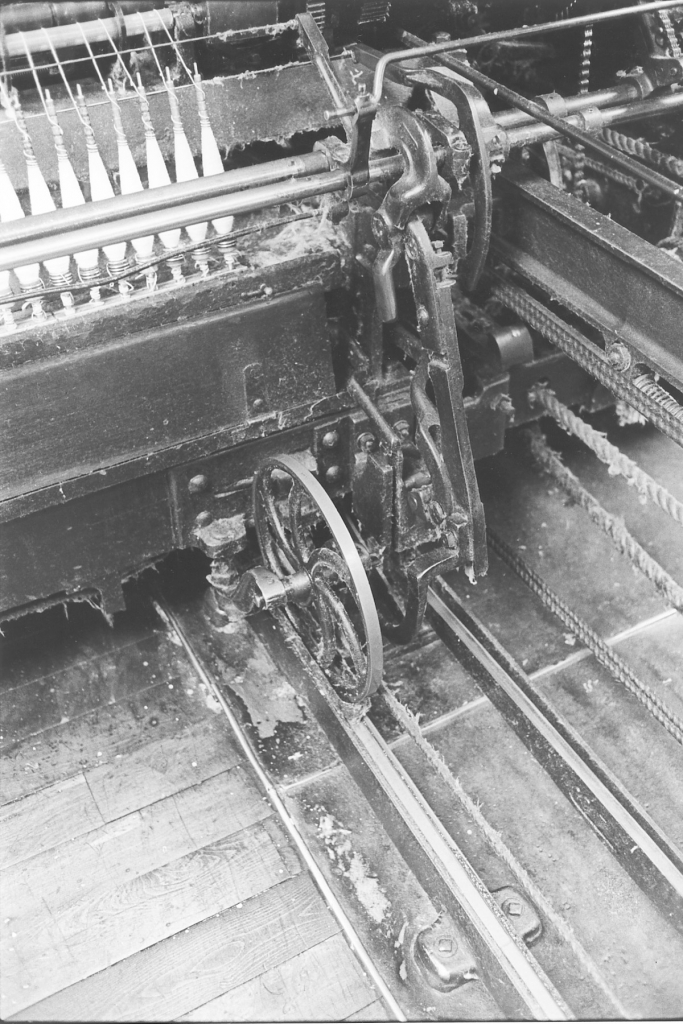
Now 93, that shows you again where the mule is in. It shows you what we’ve talked about before, your counterfolder and your winding folder. But this in actually what they're working on is this one particular lever here, which we call a boot leg. That's the one long un which comes from the folder, it's keyed in, it's keyed on to the folder shaft is them because they’re on to the winding chain, the wires that rung along both of them. And they’re both keyed on at the headstock, them set of that one thing. So any other sickle which in on that mule has to be set to them two, any one which you want, well they have to be set to either one of them, which ones you’re with you know. The boot leg as I say, when the mule comes to the back and it’s done all its twisting and so forth, that boot leg winds up, lifts up with the winding folder going down and there's a small block on the builder rail. Now you can just about see a small block there. Now that block is just one solid piece of metal, that's all, nothing else. The boot leg lifts up and a small little pulley at the bottom here just drops over on the top of that block, that stops it then from coming off. Also you've got a small lever on top of the block which is keeping that block pressed down on to the builder rail. That's just in a small little slide underneath your block which just slides backwards and forwards with the rail.
So that boot leg comes up from the base.
R- From where it is now when the mule’s in, your winding folder is at, in at the top when the mule is coming out. When the mule goes in the winding folder is at the bottom, but your boot leg in on the top of that block till your mule runs back in. Now when the mule goes back in you’ll see a small bayonet at the bottom of the boot leg which is, that's what we do call them really, it’s a bayonet. And it hits another small lever that’d just underneath the carriage but it’s fastened on to the builder plates on the carriage wheel, it's fastened on to that. That can be adjusted to a matter of five inch or six inch either way can that one small thing. But that lever if you have it one way it’ll knock that boot leg off that bit sooner before the mule goes in. If you have it set too far back, consequently that bayonet, it'll not touch it, the boot leg will stop, the counterfolder will stop where it is down in the winding position. And the winding folder will not change so therefore you've got all your ends down then.
(350)
Yes, to be avoided.
R- To be avoided if possible.
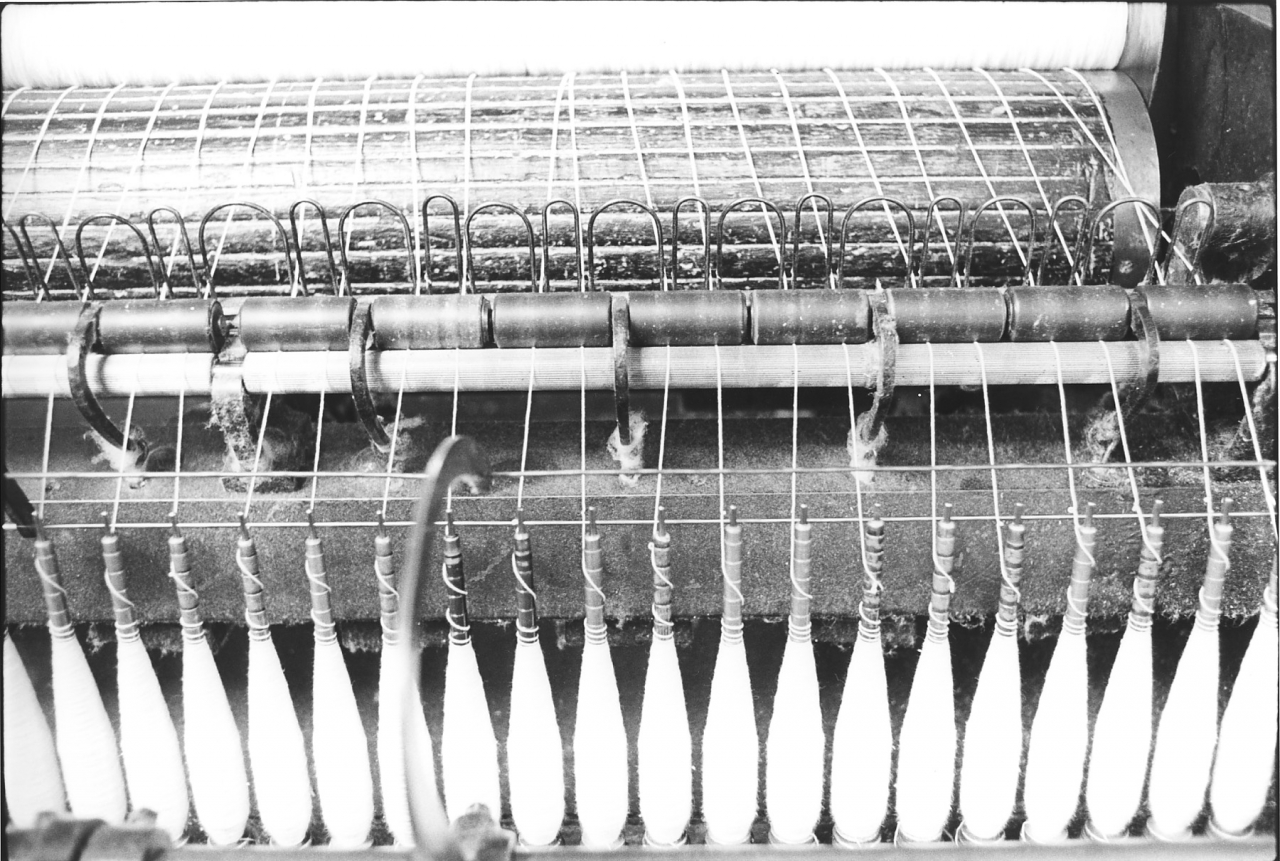
Number 94. Well that's quite a good picture of your mule in, the ends coming from the spindle through your steel, through your fluted rollers and your leather rollers, going in between the guide wires back on to the bobbin drum plus the bobbin. And it’s a good picture that. It’s all uniform, all the way along which is, it's a good thing. But it shows you also the difference in leather rollers as I was saying about them with the cleaners. Some are a bit darker than what others are, a bit dirtier.
Yes I am with you.
R - Although they look lighter they are actually dirtier.
Yes, because of the grease.
R - It's the grease and everything else.
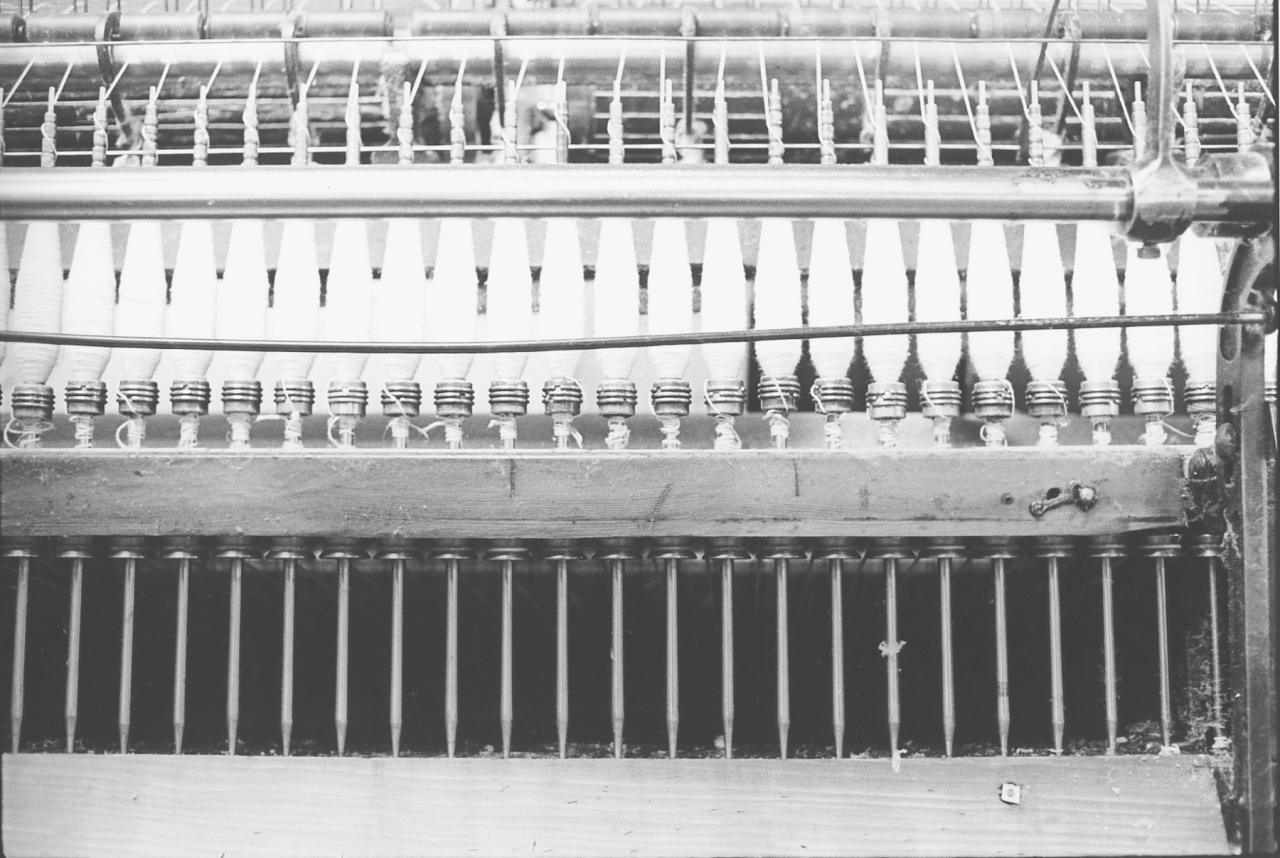
Ninety-five, well that’s more or less the same, excepting it shows you the bottom part of the spindle where all the spindle wharfes are as we call them.
That's the...
R- It’s a small wheel welded on to the spindle, made very tight. But on the spindle wharfe you fasten a small spindle band which goes inside the carriage on to the tin roller and comes back round. Now then, depending on what side you want them spindle bands, we had it weft way so it goes in the shape of an ‘S’. If we change that band round so that it’s running the other way about so you’d have the spindle running the opposite way. And instead of being weft way it would be twist way, for warping and such as that you see.
And what did you call this wooden bar?
R – That, well it's just a holding down bar really for the spindles to stop them from jumping up.
Yes, what did you call it though.
(15 min)
R - Yes sorry. When we talk about the bottom of the spindle, when we talk about the spindle wharfe board that is the one over the top of the spindle wharfe. Now the spindle wharfe in a small wheel which is attached to the spindles for a spindle band to go on to revolve them. Now the wharfe board over the top, that's all it is, it's just a matter that it's fastened on to two little lugs and it's fastened so that it's just here is the spindle wharfe and to give them the freedom without being able to move out of the way, to stop them jumping up. Because if that board weren't on, we'll say we took that board off, it's just the spindle that goes straight up to the top of your thing. So if that board weren’t on them spindles would be able to jump up. That's all as it’s for. And then for another thing, if we have to change one, if one gets
(450)
catched for some reason, you know gets catched I mean we could soon take that spindle out and put another new one in place of it. If that board were fast and we couldn’t take it off, then you wouldn't be able to take them out. That's why there's just two little pins that slots in so that we just let them pins up, take the board off then take the spindle out.
That's it. You might just make some small comment on number 97
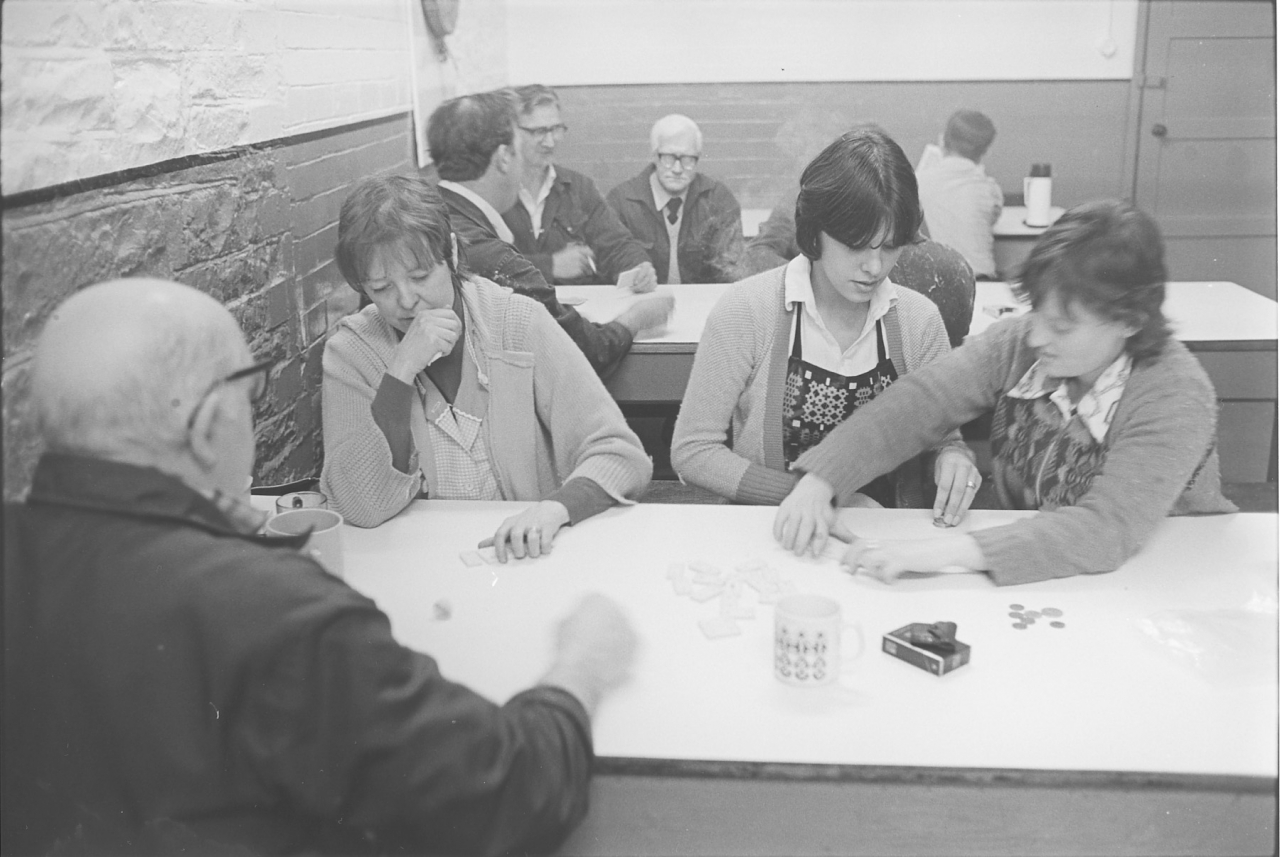
R - Ninety-seven. Well, this is typical isn’t it. I mean this is your canteen, dinner time, that's what I presume. It's dinner time where you've got one or two other people, playing dominoes after their dinner, which is more than likely it would be about five past twelve, ten past.,. probably one or two sneaking in including Joe Pilling and Brian
Why, weren’t they supposed to be there?
R - Well at that time, yes but I mean not at five to twelve like they were at dinner time. I mean you can do nothing about it. but young Pat here, as I say this has been a good lass has this one, a tuber which we’ve had since she were fifteen. And as far as tubing's concerned, and as far as workers is concerned you'll have a job to get a better lass. But they haven't made her redundant, they’ve found her a job over at Grane Road but she's not as content at Grane Road as what she were working here. This is what happens through redundancy things, which can't be helped. But that is one particular sort of lass that this trade is losing. And give or take a month or two, and it wouldn't surprise me if I don't come up sometimes and somebody tells me that young Pat’s finished because as I say, them sort of things are happening, and we are losing people. When we do get a good un in this trade now, which is an exceptional thing, and the management will tell you the same thing. When we do get a good un we might be able to keep them for a while, and then all of a sudden something comes like this, short time or sommat else and all of a sudden the good uns have gone so that then we are left with the rubbish again. And it takes a long while to get a decent staff together and we've done pretty fair in this mill as far as having a decent staff. We’ve had one or two bad uns and I wish you could have been here four or five years since. The lad what's took the photos, I wish he could have been here to take the photos of one or two of the lads which we've had in this particular trade. It’d give you a good idea of what we’ve had to put up with. And then this is what happens. In this trade now, it’s been going down and going down and nobody’d ever been able to stop it. Not really, they’re still not trying, not as hard as they should do.
I felt that, every time I’ve been here, that there is a very friendly atmosphere.
R- There is quite a good friendly atmosphere. You get one or two that tries to come out with one or two wisecracks you know. The fly boys as we call them, them's the ones that want to be sat down in there, in the canteen, they don't want to be bothered over doing anything else. If they can get away with it they will do. I mean you've got an example not long since with one lad that were in there at the same time as meself, no names because he doesn't need to be mentioned, but that lad now is being made redundant the same as us all. Now, he is under the obligation that he thinks the country and the rest of the mill should owe him something. It only owes him what he's put into it. And if he hadn’t have been here, he wouldn’t have been here so long excepting for two things. He’s had a good easy job in one respect, he's had time on his hands to he able to play about, read his books and what not and he’s also been able to get his overtime in. Now a lot more mills won’t put up with things like that, not chasing overtime and all. We've got another one that works in the card room that had time off work without number but when he’s come in, if it's been his particular day for overtime he worked on it. Now he might have been off two days but this is the sort of things that this particular trade has been having to put up with. Now it's not running nobody down or anything else, it’s just the way that we’ve been saddled with labour. And that's the way it's been. It’s been going steadily worse every year that's gone over your head. But as I say in the spinning room department we’ve done pretty fair because we've only really one and not a bad lad but at the same time he could have been a hundred per cent better but he is the only one we have now that's been anything at all. I mean a year or two since, we’d three or four of them. But I got a bit weary, and I kept having a do at Roy and I told him straight that I wasn’t putting up with it. Either we got shut of them or I get shot. And I said “You take it on your own shoulders.” Well you can’t expect to get good work out of bad relationships. You see, when we talk about running a pair of mules and we want a pair of lads working in that mule room, you get one bad un in that pair of mules and you don’t just get one, you don't just get the bad un, you get the good one being bad because the good un will turn automatically and go back to the bad un. And this is what happens. I mean, a lot of them before used to try to do it the other way, “Oh we’ll put him with him because he is a bad un and he is a good un so the good un will work harder to pull him through. But that were all right, it were taking the, it were taking the guts and everything else out of the good un to keep his wage up .. and the bad un were being all right, he were having a pound or two put in his pocket. But eventually the good un would either leave the job, leave the trade or otherwise go the same way as him, then at finishing up you were having to finish them both which should never have been allowed. But this is what it used to be once over. And that's what I mean when I say if you get two good lads working on a pair of mules you get better production, you may get better quality and everything else. But, like, as I say, through the years it has deteriorated. Are you right now?
Yes. Thank you very much for everything Arnold.
R- Right, thank you.
SCG/22 June 2003
3,563 words.
